|
HESIODUS.
H�SIODOU ASKRAIOU TA HEURISKOMENA. Hesiodi Ascraei quae extant. Ex recensione Johannis Georgii Graevii cum ejusdem animadversionibus & notis. Accedunt notae ineditae Josephi Scaligeri et Francisci Guieti. Bound with: Johannis Georgii Graevii Lectiones Hesiodeae ut & notae Josephi Scaligeri et Franscisci Guieti.
Amsterdam Amstelodami Apud Danielem Elzevirium 1667. 8vo. 2 volumes in 1: XXXII1639 fragmenta; IV1838 7 index & 1 errata1 blank p. Vellum 16 cm Ref: STCN 850625599; Neue Pauly Supplement 2 p. 282: Hesiodus EF 10; Willems 1378; Berghman 830; Rahir 1439; Brunet 3141; Graesse 3263; Ebert 9603; Dibdin 234/35; Moss 1470 Details: Greek text and Latin translation. Boards with blind fillet border. First title printed in red and black. Woodcut printer's mark of Louis and Daniel Elzevier on both titles both showing different versions of the Minerva type; they depict Minerva under an olive tree she holds a banner with the motto: 'Ne extra oleas' to be understood as 'Stay within the bounds of wisdom' Condition: Vellum slightly worn. Boards slightly curved. Old ownership entry on the front flyleaf and on the title. 2 gatherings loosening. A few old ink inscriptions in the margins. Small inkstains on 1 p. A small and faint waterstain in the lower corner of the beginning. Small wormhole in the upper margins of the second half nimbling only at the head of a few letters Note: Hesiodus from Askra a small town in Boiotia born ca. 775 BC is one of Greek's oldest poets. His poems are in Homeric hexameters and show his interest in ethics and systematization. His work was known throughout antiquity to rhapsodes scholars and schoolboys. The Byzantines compiled scholia from ancient commentaries for eludication. The Renaissance didnot quite appreciate him. Until 1667 ca. 18 editions of his 'opera omnia' were published not much. Hesiod's reception chiefly concerns myths and the motifs that he provides and these motifs certainly appealed to mythographers historians of religion poets and painters. 'Hesiodic details of myth saturate European epic and mythopoeic writings perhaps most spectacular in Dante Milton Blake . who make much of Hesiod's infernal regions his Titans and primordial monsters his giant battles'. The Classical Tradition N.Y 2010 p. 435 Of Hesiod survives his 'Theogonia' or 'Theogony' which 'deals with the origin and genealogy of the gods . and the events that led to the kingship of Zeus: the castration of Uranos by Kronos and the overthrow of Kronos and the Titans by the Olympians'. OCD 2nd ed. p. 510 The 'Works and Days' or 'Erga kai H�merai' of Hesiod which was always most read has been called a 'gospel of labour'. The poet recommends the hard and honest life of a farmer. He 'inveighs against dishonesty and idleness by turns using myth . parable allegory and threats of divine anger. . The poem as a whole is a unique source for social conditions in early archaic Greece.' OCD 2nd ed. p. 511 The third poem that has survived is the 'Shield' or 'Aspis' a short narrative poem on Heracles' fight with Cycnus a bloodthirsty son of the god Ares. It derives its name from the long description of Heracles' shield. 'Artists have never abandoned a fascination with Hesiod on the Muses. In the 19th century the artist Gustave Moreau created many visual representations of their initiation of the poet. Both Rubens and Goya painted famous and harrowing pictures of Kronos Saturn devouring one of his children a motif from the Theogony; William Blake engraved a series after drawings by his friend John Flaxman . Georges Braque chose the 'Theogony' as the subject of 20 etchings'. The Classical Tradition N.Y. 2010 p. 436 � This edition of Hesiod was produced by the Dutch classical scholar of German descent Johann Georg Greffe or Graeve better known as Graevius 1632-1703 professor of Latin at the Univerisity of Utrecht during the last forty years of his life. The Hesiod was almost his only edition of a Greek classic. Graevius limited his attention mainly to writers of Latin prose and primarily to Cicero. He is best known for his huge 12 volume 'Thesaurus antiquitatum Romanarum'. Graevius tells in the preface of this Hesiod edition that he corrected the text of the 'Works and Days' with the help of two manuscript owned by Isaac Vossius. One them contained commentary of Tzetzes. From the French scholar Emericus Bigotius he received Graevius tells annotations of J. Scaliger and Franciscus Guietus. Dibdin echoes this preface 'Graevius has here presented us with an original edition; and partly by the help of Mss. and a careful examination of ancient editions and partly by his own critical acumen has rectified the text and supplied some of the deficiences'. The first volume contains the revised text and corrected Latin translation. The second Graevius' own annotations and the observations of Scaliger and Guietus Provenance: On the title has been written in small type: 'Johannes Grimm me suis annumerat Anno MDCLXXXI die 21 Aprilis'. � On the front flyleaf: 'ex libris F.J. Brevet a.d. 1914'. The jurist Frederik Jacobus Brevet 1893-1983 was a businessman and a man of letters. In 1958 he published a translation of 16 odes and an epode of Horace. In 1966 followed a more varied collection 'Moza�ek' which contained besides more translations of Horace also Catullus a number of poems from the 'Carmina Burana' and from the Greek poet Meleager and poetry of his own. In 1978 appeared a translation of all 103 odes of Horace. From 1952 till the end his life he contributed many articles on classical culture to the periodical Hermeneus of the Dutch Classical Society NKV. On the blank verso of the last leaf an old inscription: 'Hic est liber condiscipuli mei suavissimi' not followed by a name Collation: -28; A-L8; A-M8 Photographs on request hardcover
Ссылка продавца : 152349
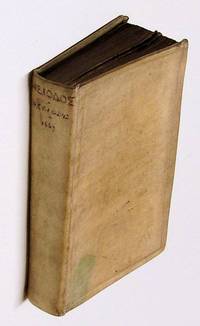
|
|
|
BAIF L. DE.
De vasculis libellus adulescentulorum causa ex Bayfio decerptus addita vulgari latinarum vocum interpretatione.
Paris Parisiis Ex officina Roberti Stephani typographi Regii 1543. Colophon at the end: 'Excudebat Rob. Stephanus Typographus Regius Parisiis an. M.D.XLIII XIII Cal. Oct. 8vo. 523 index1 blank p. Half vellum 20th century 17 cm Ref: not in Renouard 'Ann. de l'Impr. des Estienne' see however p. 58 1543/12: 'Carolus Stephanus De re Vestiaria Vascularia et Navali ex Bayfio. Addita vulgaris linguae interpretatione'; not in Brunet Graesse or Ebert Details: Printer's Olive tree device of the Stephanus family on the title motto: 'Noli altum sapere' short for 'Noli altum sapere sed time' in English 'Donot be high-minded but fear'. Epistola Beati Pauli ad Romanos 1120 Condition: The right upper corner of the first gathering slightly waterstained Note: The French diplomat humanist and poet Lazare de Ba�f ca. 1496-1547 was born near La Fl�che in Anjou. He wrote in Latin and translated from Greek into French. He translated the Electra of Sophocles which was printed in 1537 in Paris. He was abbot of Charroux and Greneti�re and counselor of the parliament of Paris. Around the year 1530 Ba�f was sent to Venice as ambassador where he fell in love with a woman of rank with whom he had a son in 1532. The boy was named Jean-Antoine the future poet of the Pl�iade. Lazarus de Ba�f being of ecclesiastical orders could of course not marry his mistress but he recognized her son and legitimized him later. He took the boy to Paris where he gave him a worthy education. Some of his tutors were Dorat a brilliant Hellenist and Latin scholar and Charles Estienne his friend and disciple. In 1526 De Baif published his first work in Basel De re vestiaria which earned him a reputation among French scholars as second in rank to Guillaume Bud�. As a diplomat he continued his philological and archaeological studies and corresponded with Erasmus Bembo and many other humanists. 'His scholarly reputation rests squarely on his three Latin works: De re vestiaria of 1526 . De vasculis Basel H. Froben 1531 . and finally De re navali Paris R. Estienne 1536' which was accompanied by illustrations derived from sketches of the pillar of Trajan and other monuments. Contemporaries of Erasmus: A Biographical Register of the Renaissance and Reformation Toronto 1985 p.87/88 In 1549 Robert Estienne posthumely published an edition of these works which were revised and expanded by the author. Charles Estienne rearranged de Ba�fs works on naval matters clothing and vases of the ancients for the use of young students. Various editions between 1535 and 1537 The first 'school-edition' of the book on ancient vases came from the presses of Robert Estienne in 1536 and was repeated in Basel by Froben in 1537 and 1541. De vasculis libellus adulescentulorum causa ex Baysio decerptus. Addita vulgari Latinarum vocum interpretatione In the preface to De Vasculis Charles Estienne tells the reader that not all aliquot studious young students iuniores tyrunculi could understand De Baif's work. se non omnia intelligere quae in libello Bayfii de vasculis continerentur. Therefore when he heard this De Baif gave his friend permission to make a summary of his book. facile passus est suum libellum in brevem quandam summulam contrahi Charles Estienne 1504-1564 'was an early exponent of the science of anatomy in France. Charles was a younger brother of Robert Estienne I the famous printer and son to Henri who Latinized the family name as Stephanus' . After the usual humanistic training Greek and latin classics he studied medicine and took his doctor's degree at Paris. He was for a time tutor to Jean-Antoine de Ba�f the future poet. It is uncertain whether he taught publicly. His career was interrupted by the oppressive persecutions in which their religious opinions involved the family. Wikipedia s.v. Charles Estienne Robert Estienne published De Baifs work on vases in the same year 1543 also accompanied by a French translation See Renouard � This 1543 edition seems to be rare. KVK records only a few copies worldwide Collation: a-c8 d4 Photographs on request hardcover
Ссылка продавца : 120164
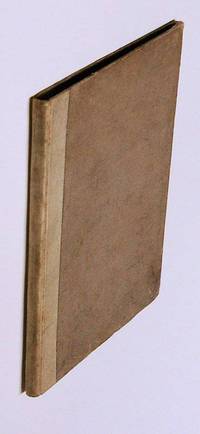
|
|
|
VERGILIUS.
Vergilius Maro ex editione Nic. Heinsii & P. Burmanni.
Amsterdam Amstelaedami Apud Jac. Wetstenium 1744. 12mo. XXXII328 p. engraved title. Vellum 12.5 cm Ref: Schweiger 21174; Graesse 6/2342 Details: Nice copy. Back ruled gilt and with a green shield in the second compartment. The engraved title shows scenes from the work of Vergil. On the verso of leaf 2 an engraved portrait of Vergil after a gem from the collection of Fulivius Ursinus. Clear typography Latin text only Condition: Vellum age-tanned. Ownership inscriptions on the front pastedown and the front flyleaf Note: The Bucolics Georgics and the Aeneid of the Roman poet Vergil 70-19 BC were already classic in antiquity. In the Middle Ages Vergil was also widely read. Of no other Latin author survive so many manuscripts as of Vergil. He never fell out of favour and he did not need to be revived. He 'became a European classic not only in the sense that he was a central author for many European readers for many centuries but also in the further sense that his works crucially helped such readers to define themselves as Europeans'. The Classical Tradition Cambr. Mass. 2010 p. 965. Vergil's work was used for opera's Orfeo for epics Paradise Lost by painters et alii. Vergil was served well by numerous editions and translations. It is a well known bon mot to say the Vergil's legacy to Western literature is Western literature. � This edition of 1744 is based on the earlier edition of Nicolaas Heinsius 1620-1681. He was a Dutch diplomat and classical scholar who never held any academic appointment. Few scholars have examined so many Latin manuscripts and in 'making his selection from the vast mass of variants he was guided by a fine taste and a sound judgment acquired by long experience'. He edited several Latin poets among whom Vergil 1664. His editions laid the foundations of the textual criticism of those authors. Heinsius' notes on Vergil came after his death in the hands of Burmannus Senior. Sandys 2 323/6; 443/5 455 Thereupon Burmannus Senior decided to produce a new Vergil edition. However while he was preparing this edition his sudden death interrupted the project. It was his uncle's will ut ipse jusserat Burmannus Junior tells us in the preface to this edition of 1744 to put the finishing touch to the project ut suprema operi imponeretur manus. While Burmannus Junior was working on his uncle's edition of Vergil the publisher Jacobus Wetstenius in the mean time decided Burmannus tells to bring a small version minoris formae editionem hanc of this ambitious Vergil project on the market. This slim edition of 1744 was to offer in a handy format and at a low price a kind of appetizer or first course to a tasty meal 'ut quasi praegustata hac promulside lectores mox ad lautiores invitaret epulas'. Preface Lectori Benevolo p. 2 recto This tasty and opulent meal came two year later. In 1746 Petrus Burmannus Junior finally published in four volumes Vergil's Opera cum integris & emendatioribus commentariis Servii Philargyrii Pierii. Accedunt Fulvii Ursini Georgii Fabricii Francisci Nansii Joh. Musonii Tanaquilli Fabri et aliorum ac praecipue Nicolai Heinsii notae nunc primum editae; quibus & suas in omne opus animadversiones & variantes in Servium lectiones addidit Petrus Burmannus. Post cujus obitum interruptam editionis curam suscepit & adornavit Petrus Burmannus junior. � Petrus Burmannus Senior 1668-1741 was professor of Latin at the University of Utrecht since 1696 and at Leiden since 1715. Fabricius/Ernesti hold the Vergil edition which Burmannus Senior was preparing in high esteem: 'Haec igitur editio est omnium princeps et canon Vergilii posthac luculenter edendi'. He adds that the text is 'optime constitutum'. Burmannus Senior who was famous as manufacturer of Variorum editions confined himself to the editing of Latin classics. He was regarded by Ruhnken as the equal of Nicolaas Heinsius in learning but inferior in acumen and in emendatory skill. His nephew Petrus Burmannus Junior 1714-1778 was in 1742 appointed professor of Latin at the Athenaeum Illustre of Amsterdam. Sandys considers him to be superior in his intellectual attainments to his uncle. He appointed himself 'ex�cuteur litt�raire' of the still unpublished works of his uncle who had spent his last years on Claudian and Vergil Provenance: On the front pastdown: 'Daniel H. Newell Rome . 1884'. On the front flyleaf: 'A.G. Larman 1947' Collation: -8 A-T8 U4 X8 Photographs on request hardcover
Ссылка продавца : 120184
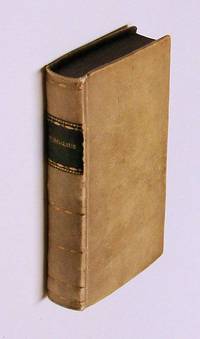
|
|
|
HEINSIUS D.
Danielis Heinsii Poemata auctiora. Editore Nicolao Heinsio Dan. Fil. And: Danielis Heinsii Poemata graeca et e graecis latine reddita diverso tempore ac aetate conscripta. Quibus Adoptivorum liber accedit.
Ad 1: Leiden Lugduni Batavorum Apud Francis. Hegerum 1640. Ad 2: Leiden Lugd. Bat. Ex Officina Francisci Hegeri 1640. 12mo. 2 volumes in 1: XX5751 blank;1893 errata p. Overlapping vellum 13 cm Ref: Willems 1613: '�dition la meilleure la plus compl�te et la plus belle des po�sies latines et grecques de Dan. Heinsius'; Rahir 1892; Berghman 864; Brunet 384; Ebert 9380 Details: 5 thongs laced through the joints. Volume 1 has an engraved title it depicts 'Severitas' i.e. 'Seriousness' as a seated and bearded philosopher/author who's hand rests on a book; he is looking at 'Lepor' or 'Plaesantry' depicted as a young woman/Muse playing a lute she has a laurel wreath on her head. At the feet of these two 'Severitas Leporque'. The second volume has on its title Hegener's printer's mark: a pelican feeding its young with his own blood the motto is: 'Vivimus ex Uno'; on p. 15 of the second volume a woodcut portrait of Homer Condition: Vellum age-toned and somewhat soiled. First flyleaf gone. Old inscription on the front pastedown Note: The Dutch classical scholar of Flemish origin Daniel Heinsius 1580-1655 who enjoyed international fame as an editor of classical texts theorist of literary criticism historian and neolatin poet was professor of Poetics at the University of Leiden since 1603 extraordinarius Greek since 1605. After the death of J.J. Scaliger to whose inner circle he belonged he held the chair of Greek from 1609 till 1647. He is best known for his edition of Aristotle's treatise on poetry 1611 which he studied in connexion with the 'Ars Poetica' of Horace. This edition is 'the only considerable contribution to the criticism and eludication of the work that was ever produced in the Netherlands. . In his pamphlet 'De tragoediae Constitutione' published in the same year 1611 he deals with all the essential points in Aristotle's treatise giving proof that he has thoroughly imbibed the author's spirit. . It was through this work that he became a centre of Aristotelian influence in Holland. His influence extended in France to Chaplain and Balzac to Racine and Corneille; in Germany to Opitz; and in England to Ben Jonson .'. J.E. Sandys 'A history of classical scholarship N.Y. 1964 vol. 2 p. 314 Heinsius was a representative of the great age of Neo-Latin in the Low Countries which encompasses the 16th century and a good part of the 17th century. Here the Anacreontic-Petrarcan love poetry in Latin was kept alive. J. IJsewijn 'Companion to Neo-Latin studies' vol. 1 Leuven 1990 p. 154. The first volume of Heinsius' poetry opens with early work the 3 books of Sylvae followed by Hipponax an Ode to Molinus 3 books of Elegiae and the Monobiblos. Then Heinsius' Epigrams and occasional poetry including a 'cento vergilianus'. The second half of the first volume contains 'Herodes Infanticida tragoedia' followed by Heinsius' last long Latin poem 'De contemptu mortis' a didactic poem in 4 books wherein arguments Platonic Stoic and Christian are set forth which explain why man should not fear death. At the end of volume 1: 'Elegiarum iuvenilium reliquiae'. Volume 2 contains Heinsius' literary tour de force his Greek poems inspired by Theocritus and the Anthologia Graeca. It opens with 'Peplus' Gown a series of epigrams which Heinsius composed on Greek authors and philosophers. This part is followed by occasional poetry in Greek which Heinsius wrote for his contemporaries like e.g. Casaubon and by a section of Greek poetry in Heinsius' Latin translation. This second volume is concluded with the 'Liber adoptivus' which contains occasional poetry addressed to Heinsius by J.J. Scaliger J. Dousa H. Grotius et alii. The bibliographer of the Elzeviers A. Willems praises this 1640 edition of their Leiden colleague Hegener of 1640 highly; it is even to be preferred above the Elzevier edition of 1621. 'elle m�rite � tous �gards la pr�f�rence sur celle de 1621 no. 187 la seule que les Elzevier aient donn�e de ce recueil' Collation: 12 minus blank leaves 11 & 12; A-2A12 leaf 2A12 verso blank Photographes on request hardcover
Ссылка продавца : 120075
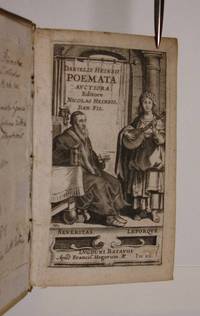
|
|
|
ERASMUS.
Des. Erasmi Roterod. Colloquia nunc emendatiora.
Amsterdam Amstelodami Ex officina Elzeviriana 1662. 12mo. XX672 p. Overlapping vellum. 14 cm Ref: Willems 1285: 'R�impression ligne pour ligne de l'�dition donn�e par les Elzevier en 1655'; Berghman 1350; Rahir 1324; Brunet 21040 Details: 5 thongs laced through the joints. Title engraved by Corn. Cl. Duysend it depicts a standing Erasmus who looks through a telescope into a clouded sky; from a cloud comes the hand of God that bears the 'globus cruciger' corss-bearing orb in German Reichsapfel; the globe represents the earth and he who holds the globe owns the world. The motto on the title suits Erasmus: 'Vidit pervidit risit'. This engraved title was already used by Elsevier for the edition of the Colloquia of 1636. On the last of the preliminary pages a woodcut illustration depicting both sides of a medal of Erasmus on the recto his portrait on the verso his motto: 'Concedo nulli'; around it the legend with Erasmus' interpretation of his motto: 'Mors ultima linea rerum' Condition: Vellum age-tanned and somewhat soiled Note: 'The Colloquia like the Adagia were written over a period of years and constantly enlarged as edition succeeded edition. From their earliest form of short models of Latin conversation and formulae of etiquette composed at Paris in 1497 for the use of some pupils and first printed in 1518 they grew into 'a rich and motley collection of dialogues each a master piece of literary form well-knit spontaneous convincing unsurpassed in lightness vivacity and fluent Latin each one a finished one-act play' Huizinga. The Colloquia full of witty and penetrating observations on ordinary day-to-day happenings as well as on the basic weakness of Church and society are an invaluable mine of information about 16th century customs institutions and social problems. Besides their success as a schoolbook was unrivaled and the stream of editions and translations flowed almost uninterruptedly down to modern times'. Gilhofer & Ranschburg GmbH Catalogue 50 Erasmus published on the 500th anniversary of his birth' Luzern ca. 1967 p. 34 The Colloquia are preceded by a short biography of Erasmus last sentence: 'Discerptus est ab utraque dum utrique studet consulere' and a table of content Collation: 10 A-2E12 Photographs on request hardcover
Ссылка продавца : 120064

|
|
|
FLORUS.
Lucii Annaei Flori Rerum Romanarum editio novissima accurante Joanne Freinshemio. In qua quid praestitum sit aversa pagina docet.
Strassburg Argentorati Apud Georg. Andr. Dolhopf & Joh.Eberh. Zetzner 1669. 8vo. 32452155 'Variae lectiones' & index1 blank p.; frontispiece. Vellum 17 cm Ref: VD17 3:306199X; Schweiger 2361; Fabricius/Ernesti 2444; Graesse 2605 Details: 5 thongs laced through the joints. Frontispiece depicts two discussing Roman warriors at their feet the she-wolf and the twins Romulus and Remus above their head soars a big eagle holding in its claws a crown and a scepter. Woodcut printer's mark depicting a bust of the Greek goddess Athena Condition: 3 thongs of the joint of the lower board snapped. Vellum age-toned & somewhat soiled. Pastedown of the lower board detached. Old ink annotations in the first gatherings. Ten gatherings browning Note: Favourite school-book in the 17th century. This is the chief work of the Roman historian Lucius Annaeus Florus who lived at the beginning 2nd century AD. It is an abridgement of Roman history with special reference to the wars waged up to the age of Augustus. Florus 'shows a certain literary gift marred however by a strong tendency to rhetoric. His brevity often entails obscurity though he sometimes produces a felicitous epigram. . As an historian he is often inaccurate in both chronology and geography but the work as a whole achieves a limited success as a rapid sketch of Roman military history. It was a favourite school-book in the 17th century'. OCD 2nd ed. p. 442 This Florus edition was produced by the German classical scholar Johannes Casper Freinsheim 1608-1660. He was an excellent representative of the flourishing school of Roman History at the University of Strassburg. 'The editions of the Roman historians published by this school were distinguished for the excellence'. According to Sandys he 'produced excellent editions of Florus'. Sandys 2 p. 367 . At the end have been added 22 pages with 'Variae Lectiones' and an index of 134 pages of which Fabricius/Ernesti record that 'In indice multa ad explicandam latinitatem pertinentia sunt'. This edition of 1669 is a reissue of the edition of 1636 also printed by Zetzner in Strassburg. It is based according to the enumeration on the verso of the title on earlier editions: 'Flori contextus a Iohanne Camerte Ioanne Stadio Elia Vineto Iano Grutero Claudio Salmasio & Isacio Pontano e manuscriptis codicibus emendatus in versiculos distinctus'. Freinshemius added many conjectures of his own consulting older editions. In the introduction however no mention is made of manuscripts but 'interdum etiam ubi manifesta correctionis ratio est ex aliorum ingenio nostroque restituimus'. p. a8 verso The editio of Camertis is of 1518 Stadius of 1567 Vinetus of 1576 Gruter of 1597 Salmasius of 1609 Pontanus of 1626. The notes at the end of each caput have been selected from the just mentioned editors '& quotquot ex aliis philologicis auctoribus nostrove ingenio depromere licuit' p. a2 verso Collation: a-b8 A-2P8 leaf 2P8 verso blank Photographs on request hardcover
Ссылка продавца : 120131
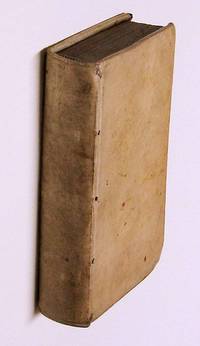
|
|
|
AUSONIUS.
Decii Ausonii Burdigalensis viri consularis varia opuscula dilegenter recognita.
Basel Basileae Apud Valentinum Curionem 1523. 8vo. XVI2493 p. Early 20th century half vellum 15.5 cm Ref: VD16 A 4385; Schweiger 221: 'nicht ohne krit. Werth'; Fabricius/Ernesti 3147 Details: Title with large woodcut borders. Large printer's mark designed by Hans Holebein at the end; Holbein worked for Curio from 1521 till 1524. Heitz/Bernoulli 'Basler B�chermarken' Strassburg 1895 p. 67 illustration 102 Condition: Binding probably early 20th century. Damaged back restored with a strip vellum. Title slightly soiled and its edges are somewhat thumbed and its upper margin is somewhat cut short. Name on the title below the imprint. First gathering slightly waterstained. No flyleaves. Paper slightly yellowing Note: Decimus Magnus Ausonius of Burdigala Bordeaux ca. 310-394 was according to H.J. Rose an example of the senile degeneration of 4th century Latin literature and the first glimmer heralding the full day of French literature. He wrote trifles sometimes pretty or clever often tiresome. H.J. Rose 'A History of Latin Literature' London 1967 p. 527/29. H.G. Evelyn White the editor of the Loeb edition is even more negative: 'As poetry . the great mass of his verse is negligible'. The chief value of Ausonius' work is according to him historical. Loeb Classical Library Ausonius Cambr. Mass. 1919. p. VII The 'Neue Pauly' is more positive: 'Ausonius repr�sentiert eine Kultur der Bewahrung und des Erbes. Allenthalben greift er auf die griech. und lat. Lit. zur�ck �ber die er souver�n verf�gt und gestaltet anspielungs- und voraussetzungsreiche preti�se Gebilde von formalem Raffinement'. Der Neue Pauly 2334 Alexander Souter is in the Oxford Classical Dictionary full of praise: 'His numerous poems written in various metres . are of considerable interest in both subject-matter and style. There are over a hundred epigrams some of which are in Greek and others translated from Greek. There are 25 letters. His correspondence with Paulinus of Nola is the most notable part of these. The Ephemeris includes many poems in various metres dealing with daily life. The Parentalia is a collection of short poems in memory of deceased relatives of the poet. The Commemoratio Professorum Burdigalensium is of interest for the history of education. . This account by no means exhausts the list of minor poems throughout which the author's minute knowledge of Virgil is apparant and his Christian faith is not obtruded. His most important poem is the Mosella which still attracts readers. It is a rhetorically fashioned laudatio in 483 hexameters and describes in considerable detail the various fish to be found in the river as well as some of the fine buildings on the banks and other features the whole constituting a series of episodes composed like the rest of Ausonius' verse according to rule'. OCD 2nd ed. p. 154 � Not known on which edition this 1523 edition is based. It is not a reissue of the Juntae or Aldus edition both of 1517. It has after the short biography of Ausonius by Petrus Crinitus with which it opens a 10 page 'Scriptorum Ausonii Catalogus'. Follow the Epigrammata the Eidyllia among them Mosella Epistolae and other minor works; it ends with Ausonius' 'Periochae in omnes Homeri Rhapsodias' Provenance: Name on the title is partly illegible: 'Galij Milia. 1692' Collation: a-q8 r6 leaf r6 recto blank Photographs on request hardcover
Ссылка продавца : 120150
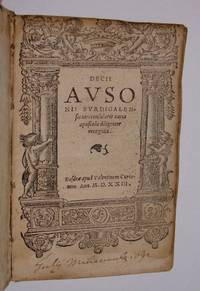
|
|
|
VENERES BLYENBURGICAE
sive amorum hortus: in quinque areolas divisus & fragantissimis CXLVIII celeberrimorum poetarum flosculis refertus opera Damasi Blyenburgy Batavi H.F. Part 1: Venerum Blyenburgicarum sive Horti Amoris areola prima: Ad amicam; 2: Areoloa secunda: Laudes; 3: Areola tertia: Ad se ipsum; 4: Areola quarta Ad Venerem & Cupidinem; 5: Areoloa quinta: Ad animum mentem mortem et similia.
Dordrecht Dordraci Ex typographia Isaaci Canini impensis Davidis Episcopii 1600. 8vo. 5 parts in 1: XVI865 recte 8711 blank84 appendix p. Contemporary limp overlapping vellum 16 cm Ref: Brunet 1982: 'Ce recueil de pi�ces �rotiques est un des plus agr�ables que nous ayons en ce genre mais il y manque nombre de morceaux qui auraient d� y figurer'; Graesse 1444; Gay-Lemonnyer 31308 Details: 2 thongs laced through the joints. Manuscript title on the back. Each part has its own title followed by a dedication preface and list of contents Condition: Binding age-tanned worn spotted and somewhat wrinkled. All four ties gone. Front flyleaf removed. First title thumbed and showing a small hole at the imprint. Paper foxed and yellowing some gatherings browning Note: This is the first edition of one of the most important 17th century anthologies of erotic Neolatin poetry from 148 poets. The collection was compiled by the Dutch man of action and letters and neolatin poet Damas Heymansz. Blyenburg born Dordrecht 1558 deceased while traveling to Bohemia in or after 1616. Damas was in 1586 enrolled as a law student at Leiden and followed an intellectual career. In his youth he published a poem in praise of the neostoic treatise De Constantia of Justus Lipsius 1584 who was a professor at Leiden. He corresponded with many scholars. From a letter to Bonaventura Vulcanus professor of Greek at Leiden it seems that he participated in one of the first trips to the East Indies as a captain. In 1594 we find him in America where he entered into the service of the first British governor of Virginia. Damas published the works of Fulgentius of Ruspe Amsterdam 1610 & 1612 published an anthology of 200 Latin poets Cento ethicus ex variis Poetis hinc inde contextus Leiden 1599 and compiled another anthologyVeneres Blyenburgicae Dordrecht 1600 2nd edition 1613 Amsterdam. NNBW 4175/76; and www.regionaalarchiefdordrecht.nl/achtergronden/familie-van-blijenburg-15e-17e-eeuw/ The Veneres Blyenburgicae divided into 5 areolae flower-beds contains on more than 900 pages 1137 erotic poems of 148 poets of Alciatus Bonefonius Dousa Erasmus Gruterus Hessus Lotichius Muretus Marullus Politianus Robortellus Sannazarius Janus Secundus and many others Collation: 1 8 A-O8; 2 P-Z8; 3 2A-2P8; 4 2Q-2X8; 5 2Y-3N8 3O8 minus blank leaf 3O8 Photographs on request hardcover
Ссылка продавца : 120181
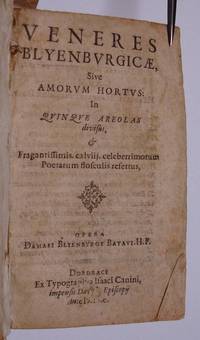
|
|
|
LAMPADIUS J.
Tractatus de Constitutione Imperii Romano-Germanici auctore Iacobo Lampadio I.C. Accessit eiusdem Discursus de Natura nummi & interpretatio L. 2. C. 'de usucap. pro Hered'. Item Iacobi Augusti Thuani Germaniae descriptio ex eius lib. 2 Histor.
Leiden Lugduni Batavorum Ex officina Ioannis Maire 1634. 24mo. 380 p. engraved title. Overlapping vellum 11 cm Ref: Breugelmans p. 364 1634:4 Details: 2 thongs laced through the joints. Short title in ink on the back. The engraved title depitcts the emperor of the Holy Roman Empire on his throne with his regalia. The lower part of the title is adorned by 7 coats of arms of German states Condition: Vellum age-tanned. Ink stain on the back. Small inscription on recto of front flyleaf. Upper margin of the title slightly stained and showing an old ownership entry. A small stamp on the lower margin of the recto side of the second leaf. Four new brown ribbons attached to the covers Note: The German diplomat and jurist Jacobus Lampadius Jakob Lampe 1593-1649 conducted a lively correspondence with Conring Althusius Grotius Georg Calixt et alii. His theory of constitutional law which contributed to the further development of the prevailing dualism in the Holy Roman Empire into a system of federate states in accordance with a shared sovereignty between the Emperor and the German lands has become with adaptions to the peace of Westphalia of 1648 which ended the thirty years' war in Germany made by Conring and later by Kulpis a widely read standard work on the constitutional relations in Germany during the second half of the 17th century. It was first published in 1621 as 'Dissertatio de jurisdictione in Imperio nostro Romano-Germanico'. H. Conring Conringius produced in 1630 an augmented and revised edition under the title of 'De constitutione reipublicae Romano-Germanicae'. The Leiden publisher Maire brought Conring's edition on the market as 'Tractatus de Constitutione Imperii Romano-Germanici'. NDB 13 454/56 Provenance: On the front flyleaf: 'C. desars 1654'. This name is repeated in smaller type on the title. On the verso of the title in faint ink: 'Ex libris Jacobs'. On the recto of leaf A2 a small stamp: 'Albert Conrot Luxembourg'. On the internet we found one Albert Conrot 'industriel � Luxembourg' corresponding member of the 'Institut Arch�ologique de Luxembourg'. He died in 1904 Collation: A-2A8 minus the blank leaves 2A7 & 2A8 Photographs on request hardcover
Ссылка продавца : 120098
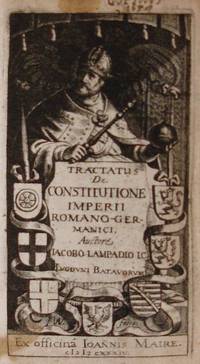
|
|
|
HEINSIUS D.
Danielis Heinsii Poematum editio nova. Accedunt praeter alia libri 'De Contemptu Mortis' antehac una non editi.
Ad 1: Leiden Lugduni Batavorum Sumptibus Elzeviriorum et Ioannis Mairii 1621. Ad 2: Leiden Lugd. Batavorum Ex Officina Elzeviriana 1621 8vo. 2 volumes in 1: VIII474 recte 4782 blank; VIII167 recte 16519 index p. Overlapping vellum 15 cm Ref: STCN ppn 832974838; Willems 187; according to Willems 'on lit sur le dern. f.: Lugduni Batavorum typis Isaaci Elsevirii iurati Academiae typographi 1622; our copy has 1621. A mistake of Willems; Berghman 862 & 863; Rahir 158 & 159; Breugelmans p. 180 1621:3; Brunet 383; Ebert 9378 Details: 5 thongs laced through the joints. Manuscript title on the back. Elsevier's woodcut printer's mark on the title of both volumes depicting an old man standing in the shade of a vine-entwined elmtree symbolising the symbiotic relationship between scholar and publisher. The motto is: 'Non solus' probably indicating the interdependency of publisher and scholar. They cannot do it alone and need each other. Engraved portrait of Homer on p. 264 of the first volume. Second title printed in red and black. Edges dyed red Condition: Vellum age-tanned and somewhat soiled & spotted. Back soiled. Both pastedowns detached Note: The Dutch classical scholar of Flemish origin Daniel Heinsius 1580-1655 who enjoyed international fame as an editor of classical texts theorist of literary criticism historian and neolatin poet was professor of Poetics at the University of Leiden since 1603 extraordinarius Greek since 1605. After the death of J.J. Scaliger to whose inner circle he belonged he held the chair of Greek from 1609 till 1647. He is best known for his edition of Aristotle's treatise on poetry 1611 which he studied in connexion with the 'Ars Poetica' of Horace. This edition is 'the only considerable contribution to the criticism and eludication of the work that was ever produced in the Netherlands. . In his pamphlet 'De tragoediae Constitutione' published in the same year 1611 he deals with all the essential points in Aristotle's treatise giving proof that he has thoroughly imbibed the author's spirit. . It was through this work that he became a centre of Aristotelian influence in Holland. His influence extended in France to Chaplain and Balzac to Racine and Corneille; in Germany to Opitz; and in England to Ben Jonson .'. J.E. Sandys 'A history of classical scholarship N.Y. 1964 vol. 2 p. 314 Heinsius was a representative of the great age of Neo-Latin in the Low Countries which encompasses the 16th century and a good part of the 17th century. Here the Anacreontic-Petrarcan love poetry in Latin was kept alive. J. IJsewijn 'Companion to Neo-Latin studies' vol. 1 Leuven 1990 p. 154. The first part of this collection of Heinsius' poetry opens with early work the 3 books of Sylvae followed by Hipponax 3 books of Elegiae and Monobiblos. Then Heinsius' Epigrams and some occasional poetry; 125 pages with Greek poems inspired by Theocritus and the Anthologia Graeca. The part with Greek poems starts with 'Peplus' Gown a series of epigrams which Heinsius composed on Greek authors and philosophers. This part is followed by 40 p. of Greek poetry in Latin translation 'Elegiarum iuvenilium reliquiae' and is concluded with the 'Liber adoptivus'. The second volume contains Heinsius' last long Latin poem 'De contemptu mortis' 1621. It is a didactic poem the finest of its time in 4 books wherein arguments Platonic Stoic and Christian are set forth which explain why man should not fear death Collation: Pagination sometimes confusing. 4 A-2G8 Gathering P begins with p. 223 in stead of 225 i.e. doubling p. 223 & 224; gathering Q begins with 237 in stead of 239 i.e. doubling 237 & 238 dubbel. 4 A-L8 M4 In gathering I the pagination 129 & 130 is skipped Photographs on request hardcover
Ссылка продавца : 120073
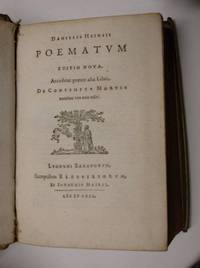
|
|
|
PERIZONIUS J.
Jacobi Perisonii Ant. F. Animadversiones historicae in quibus quamplurima in priscis Romanarum rerum sed utriusque Linguae autoribus notantur multa etiam illustrantur atque emendantur varia denique antiquorum rituum eruunter & uberius explicantur.
Amsterdam Amstelaedami Ex officina Henrici & Viduae Theodori Boom 1685. 8vo. XXXII47016 index2 blank p. Vellum 16.5 cm A masterpiece of historical criticism. Sandys Details: Woodcut printer's mark on the title it depicts a gardener who waters a shoot that arises from a tree Boom is Dutch for tree; the motto reads: 'Tandem fit surculus arbor' A shoot at length becomes a tree a popular motto in the Netherlands ever since the war of independence against the Spaniards which lasted 80-years Condition: The spine was problably once exposed to a fire it is blackish and the gilt is almost invisible; part of the shield pasted on the spine. Head of the spine is gone. Both boards age-toned and somewhat soiled. Faint ownership entry on the title. Title slightly soiled. Paper slightly yellowing Note: The historian of classical scholarship J.E. Sandys observes that this collections of 'Animadversiones' of Jacobus Perizonius is recognised as a masterpiece of historical criticism and as an anticipation of Niebuhr's method of dealing with the early history of Rome. J.E. Sandys 'A history of classical scholarship' New York 1964 volume 2 p. 331 Jacob Perizonius 1651-1715 is the Grecian form of the Dutch name Voorbroek. He was from 1682 professor of History at the University of Franeker and from 1693 of Leiden. His 'Animadversiones historicae' of 1685 made his name. The basic principle of Perizonius is simply that human knowledge is limited and liable to error. This idea he applies to ancient authors. Scribes of later centuries are not always to be blamed for the mistakes and contradictions in the surviving texts he argues. In this way Perizonius unmasks the ancient authors and demystifies their 'sacrosanctity'. 'Homines fuerunt veteres illi' the ancients were humans after all who erred and made mistakes; and consequently they are open to criticism. Ancient historians like Livy Sueton Florus Plutarch et alii he states regularly mix up names confuse dates and make all kind of errors. Their works do not offer indisputable thruths as many contemporaries thought. The task of the critic is to purge the ancient texts of mistakes. The principle aim of Perizonius is not to bowdlerize the style and expurgate the language but to investigate the historic contents of the texts. He tries to reconstruct Roman history investigating with a critical eye the historical data which have come down to us. The fallability of ancient historians was proven already by earlier generations of scholars that is true but historical truth can only be attained with a critical research methodology shifting through evidence and comparing the facts which passed down through the centuries. Perizonius's 'Animadversiones historicae' laid the foundations of historical criticism in modern time Provenance: On the front flyleaf: 'Bib. Theol. Ohly' Collation: -28; A-Z8 Aa-Gg8 Hh4 leaf Hh4 blank Photographs on request hardcover
Ссылка продавца : 120118
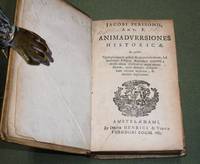
|
|
|
JUSTINUS.
Iustini Historici Clarissimi In Trogi Pompeii historias libri quadragintaquatuor a Ioan. Sichardo summa diligentia recogniti & illustrati. Quibus adiecimus certo consilio Sex. Aurelium Victorem qui Caesarum vitas a D. Augusto ad Theodosium usque historia prosequutus est. Cum indice.
Basel Basileae Apud Andream Cratandrum 1526. Cum privilegio Caesareo. Colophon at the end: 'Basileae per Andream Cratandrum Mense Ianuario anno 1526' 8vo. VIII37141 index errata colophon p. 20th century overlapping vellum 14.5 cm Ref: VD16 T 2050; Schweiger 2487; Graesse 3512; Ebert 11134 Details: Printed completely in italic letters. Woodcut printer's mark on the last page it depicts an almost naked Fortuna with winged feet standing on a globe which is divided in four parts; in her right hand she hold a opened razor blade with her left hand she makes a gesture as if she wants to grab something; the back of her head is shaven bald and the long lock in front is blown to the right; Fortuna stand in an architectural alcove. There is no motto. This variant of Cratander's printer's mark is not mentioned by A. Wolkenhauer 'Zu schwer f�r Apoll die Antike in humanistischen Druckerzeichen des 16. Jahrhunderts' Wiesbaden 2002 Condition: Title dustsoiled and showing a thumbed right edge. Two small holes in the right lower corner of the title. Old ownership entry at the top of the title erased. Old name on the title. Paper somewhat yellowing. Occasional old ink notes and underlinings; right margin cut rather short Note: This is an epitome made by one Justinus probably in the third century A.D. of the 'Historiae Philippicae' of the Augustan historian of Gaulish descent Pompeius Trogus who got his nomen because his grandfather was given Roman citizenship by Pompeius after his campaign against Sertorius in Spain. Important parts of his 'Historiae' which numbered 44 books only survive in this epitome of Justin in which it was boiled down it is estimated to 1/10th or 1/6th. Neue Pauly 10 p. 115 Trogus produced a universal history of the peoples outside Italy. He seems to have used no other sources than Greek historians and his story runs from Ninus king of Assyria to the absorbtion of the other nations into the Roman empire and the establishment of the 'Pax Augusta'. Books 7/12 describe the rise of Philip II and of Macedon. Books 13/40 treat the Hellenistic kingdoms. 42/42 contain the history of Parthia 43 of Italy and 44 the history of Spain. Inserted are many historical and geographical excursus for example on the history of Armenia or the Jewish wars. The leading concept of Trogus' history was the so-called 'translatio imperii' which conceived history as a linear succession of empires under a singular ruler or emperor. The narrative is elaborate dramatic and moralizing. Trogus was according to Rose an very passable stylist who arranged his second hand material intelligently and showed 'some original views how to write history. . Even in this diminished condition the epitome the history is interesting reading often containing facts not to be met with elsewhere and one of our much too scanty sources for the history of the eastern Mediterranean and the adjacent countries'. H.J. Rose 'A Handbook of Latin literature' 'London 1967 p. 312/13 The epitome of Justin was widely read in the Middle Ages because it seemed to legitimize the 'translatio imperii' to the Pope but also the emergence of the Holy Roman Empire as legitimate continuation of the Roman Empire. See for 'translatio imperii' English Wikipedia After the Historiae Philippicae has been added the 'Vitae Caesarum' of the late antique Roman historian Aurelius Victor biographies of Roman emperors from Augustus to Constantius 360 A.D. It treats biographical material in a moralizing fashion and is based for the first emperors on Suetonius. � The German jurist Johannes Sichard 1499-1552 was from 1535 till his death professor of Roman Law at the University of T�bingen. This representative of humanistic jurisprudence published on the Codex Iustinianus but also some important legal texts of Germanic peoples especially the 'Breviary of Alaric' Breviarium Alaricianum 1528 laws of the Ripuarian Franks Alemanns and Bavarians 1530. He was also a legal counselor in lawsuits for the Dukes of W�rttemberg in their legal controversies with Ferdinand king of the Holy Roman empire. This Justinus seems to have been his only edition of a Roman author. ADB 34 143/46 It was reissued by Cratander in 1530 Provenance: On the front flyleaf in pencil: '13 Oc. 1962' written by the Flemish linguist Walter Couvreur 1914-1996 who was an Orientalist and professor of Indoeuropean linguistics at the University of Gent. It indicates the date of aquisition. The place of acquisition he wrote on the flyleaf at the end: 'Luik Halbart'. The ownership entries on the title are made illegible Collation: a4 b-z8 A-C8 D6 Photographs on request hardcover
Ссылка продавца : 120090
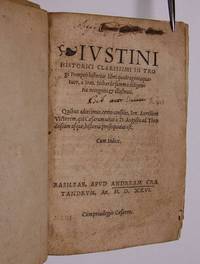
|
|
|
EUNAPIUS.
EUNAPIOU TOU SARDIANOU BIOI philosoph�n kai sophist�n. Eunapius Sardianus De vitis philosophorum et sophistarum Hadriano Iunio Hornano interprete. Graeca cum mss. Palatinis comparata aucta & emendata Hieronymi Commelini opera. Nunc recens accedunt eiusdem auctoris Legationes e bibliotheca Andreae Schotti Antverpiani.
N.pl. Geneva Oliva Pauli Stephani 1616. 8vo. 16915 index1 blank p. 18th century boards. 17 cm Ref: Hoffmann 265; Renouard Stephani 497 erronously dating 1612; Schweiger 1114; Graesse 2518; Ebert 7069; Brunet 21094 Details: Woodcut printer's mark on the title depicting a man on his knees under an olive tree he is praying; some branches are broken off and are falling down; from the mouth of the man comes on a banner the motto: 'rami ut ego insererer defracti sunt' 'the branches were broken off that I might be graffed in'. Romans 1119 The text is printed in 2 colums Greek text with opposing Latin translation Condition: Binding soiled and worn. Back chafed. Title page foxed. Paper yellowing Note: The Greek neo-Platonist Eunapius was born in Sardes ca. 345 A.D. He was an admirer of the last pagan emperor Julian and a convinced opponent of christianity. His historical work survives owing to its anti-christian tenor only in excerpts. Still extant are the 'Lives of the Sophists' written about A.D. 396. 'They follow Philostratus' model Life of Apollnius and on the basis of first-hand information deal mainly with 4th century Neoplatonists. Eunapius gives an idealized picture in order to compete with the biographies of Christian saints'. OCD 2nd ed. 416 The 'editio princeps' was published in 1568 in Antwerp. This edition already had the Latin translation of the humanist Hadrianus Junius or in Dutch Adriaen de Jonghe who was born in 1511 in Hoorn. From the presses of the Flemish scholar/printer Hieronymus Commelinus 1550-1597 came the next Eunapius edition Heidelberg 1596. It was reissued with exact the same title by Paulus Stephanus in 1616. Commelinus a native of Douai and a protestant had to flee because of the persecutions. In 1569 he is a student in Heidelberg and in 1572 he surfaces as bookseller in Geneve where he cooperates with Pierre de St. Andr� Officina Sanctandreana. He immatriculates for the second time in Heidelberg in 1585 and is invited in 1587 by the Prince-Elector Elector Palatinus to establish a printshop as typographus principis'. Commelinus' special interest were the publishing of classical texts edited by great scholars like Casaubon Scaliger and Gruter. He often did so with the help of manuscripts from the local 'Bibliotheca Palatina'. Commelinus himself was also active as an editor. In the short preface to this Eunapius edition Commelinus tells how he found 2 Greek manuscripts in the Library of the Prince-Elector now known as Bibliotheca Palatina compared them with the text of the 'editio princeps' which was edited quite insufficiently Eunapiio ita misere affecto and how he in doing so could correct and supplement Eunapius. Collatis itaque Palatinis duobus cum editione Iunii quae tuto potuere correxi supplevi Leaf a2 recto. Commelinus printshop produced in 10 years nearly 140 editions. This 1616 edition was produced by Paul Estienne who had taken over the Estienne-firm in Geneva after the death of his father Henri Estienne Henricus Stepanus II. With him ends the Geneva branch of the printer's dynasty of the Estiennes. Renouard lists between 1603 and 1627 only 27 editions Provenance: On the front pastedown in pencil: '13 maart 1963' written by the Flemish linguist Walter Couvreur 1914-1996 who was an Orientalist and professor of Indoeuropean linguistics at the University of Gent. It indicates the date of aquisition. The place of acquisition he wrote on the flyleaf at the end: 'Groningen Bouma'. The price was 8 guilders Collation: A - L-8 Photographs on request hardcover
Ссылка продавца : 120135
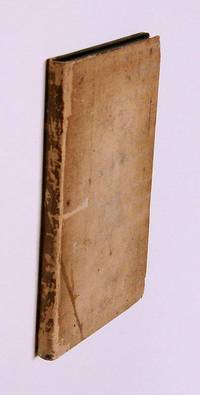
|
|
|
PINDARUS.
PINDAROU OLUMPIA PUTHIA NEMEA ISTHMIA. Pindari Olympia Pythia Nemea Isthmia.
Leiden Lugduni Batavorum Ex officina Plantiniana Apud Franciscum Raphalengium 1590. 8vo. XVI2464 blank p. Vellum 16 cm Ref: Hoffmann 398; Graesse 5294; Ebert 16858 Details: 5 thongs laced through the joints. Woodcut printer's mark on the title it depicts a hand that comes out of a cloud and draws a circle with a pair of compasses the motto is: 'Labore et constantia'. Short biography of Pindar by Gyraldus in Latin precedes the Greek text of the epinicia Condition: Vellum age-tanned. Some small wormholes in the blank upper corner of the first gathering smaller pinpoint ones in next six gatherings nowhere affecting the text. The edges of the lower corner of the first gathering eaten away by some insect Note: A quarter of the works of the Greek poet Pindar ca. 518-438 BC his four books of 'epinicia' named after the Great Games the Olympian Pythian Nemean and Isthmian survive. Pindar wrote eulogistic hymns to celebrate a victory in athletics boxing and horse racing. Praised in a magnificent way are the victor his family the native city. 'Each ode draws from a variety of historical cultural and mythological sources. The highly allusive manner by which this material is presented is complemented by an equally rich repertoire of metrical patterns from epic Doric and Aeolic systems'. The Classical tradition Cambridge Mass. 2010 p. 729 'Extended similes and difficult metaphors intricate syntax and rapid narration far-reaching digressions and bold disruptions' result in grandiose but also obscure enigmatic and sometimes seemingly awkward poetry. Already in antiquity the comic playwright Aristophanes presented in the 'Aves' Pindaric poetry as foolish pretentious and embarrassing. The Hellenistic poets Callimachus and Theocritus wrote poetry under his influence. The Roman poet Horace thought him grandiose and sublime. Pindar's influence on European literature is great. The great number of editions in Greek and Latin translations of Pindar's odes that were printed in the 16th century are an indication of a continuous and widespread humanist interest. Many of Pindar's gnomic maximes and punctuated statements containing elements of traditional wisdom were collected in Renaissance anthologies of 'sententiae' for example in Erasmus's Adagia. Already the first full Latin translation of Pindar 1528 indexed all the gnomes according to moral lessons. 'The sententious Pindar . provided the Humanists of the Reformation with pithy statements of moral instruction and wordly advice which ensured the poet's place in pedagogical circles'. 'The sheer variety of Pindarically influenced traditions -the political ode and the personal the religious hymn and the song of genius the freely aimless and the rigorously concise- all serve as a testament not only to Pindar's versatility but also to his rich potential to inspire'. Op. cit. p. 730 For Filelfo Pontano Cowley Dryden Pindar was a model for political encomium and there are quite a number of imitators of Pindar in European literature. Giangiorgio Trissino wrote a tragedy and three canzoni in a form approximating Pindar's practice Luigi Alamanni modelled his hymns on the Pindaric ode Ronsard wanted to be the French Pindar introducing the Pindaric ode into the vernacular literature of France. The French author Voltaire made the witty remark that Pindar wrote verses that no one understood and everyone had to admire. For Thomas Gray Goethe and H�lderlin he was a genius. � This Pindar edition of 1590 is based according to Hoffmann Graesse & Ebert on the Greek text of the edition of 1560 produced by the French scholar/printer Henri Estienne Henricus Stephanus. Stephanus published a second 1566 and third edition 1586 all three containing in addition to the Greek text a Latin translation of the odes but the 1560 edition is to be preferred because the Greek text is according to Dibdin the most correct. Plantin published a reissue of the Greek text of this 1560 edition earlier in 1567 Provenance: On the front pastedown in pencil: '18 april 1961' written by the Flemish linguist Walter Couvreur 1914-1996 who was an Orientalist and professor of Indoeuropean linguistics at the University of Gent. It indicates the date of aquisition. The place of acquisition he wrote on the flyleaf at the end: 'Utrecht Beijers veiling Wille'. On the front flyleaf an illegible name and 'J. Wille 10 febr. 1928'. J. Wille 1881-1964 was professor of Dutch literature and linguistics and at the same time librarian of the protestant Free University at Amsterdam. His specialty was 18th century Dutch literature and an excessive buyer of books. His books were auctioned by Beijers at Utrecht on the 23rd 26-27th april 1961. It was the largest private library ever auctioned by Beijers. P.J. Buijsters 'Geschiedenis van de Nederlandse bibliofilie boek- en prentverzamelaars 1750-2010' Nijmegen 2010 p.110/11; including a picture of Wille Collation: 8 A-P8 Q6 leaves Q5 & Q6 blank Photographs on request hardcover
Ссылка продавца : 120117
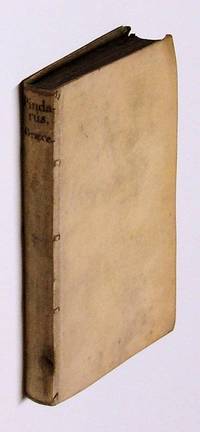
|
|
|
STATIUS.
P. Papinii Statii Opera ex recensione et cum notis I. Frederici Gronovii.
Amsterdam Amsterodami. Typis Ludovici Elzevirii Sumptibus Societatis 1653. 16mo. VIII424 p. Overlapping vellum 12 cm Ref: Willems 1166; Bergman 2139; Rahir 1189; Copinger 4491; Schweiger 2965; Dibdin 2424; Fabricius/Ernesti 2335; Moss 2612; Ebert 21682: 'mit grossem Scharfblick und nach guten H�lfsmitteln verbessert'; Graesse 6480 Details: 5 thongs through the joints. Engraved title: a battle scene from the Thebaid the city of Thebes is in the background the poet in front Condition: Vellum slightly soiled. Small owner's inscription on the title Note: His fluent and highly polished verse brought the Roman poet Publius Papinius Statius ca. A.D. 45-96 to the court of the Roman emperor Domitianus. He is best known for his epic the 'Thebaid' which tells the story of the civil war between the sons of Oedipus Eteocles and Polynices contesting power over the city of Thebes. The 'Achilleid' tells the story of the education of Achilles. Statius' 'Silvae' is a collection of 32 occasional poems addressed to his friends celebrating their marriages etc. In his epic work there are frequent imitations of Vergil in word and thought. 'The various episodes highly coloured and rhetorical though they be are generally successful regarded as separate wholes the descriptive passages striking and the narrative lively'. OCD 2nd e. p. 1011/12 � The Thebaid was extraordinary popular during the Middle Ages and the Renaissance. In Dante Statius even ascends to heaven. The 'Thebaid' was used by Boccaccio and Chaucer and there appeared adaptations in Irish French and Italian. Also Statius' 'Silvae' enjoyed a vigorous afterlife and set a standard for the Neolatin poets of the 16th and 17th century. Composing occasional poetry in imitation of Statius was a common pastime among humanist classicists e.g. Heinsius Scriverius Meursius and in England Milton and Ben Jonson. The works of Statius were ably edited by the Dutch classicist of German origin Johann Friedrich Gronov or Gronovius 1611-1671 He was the successor of Heinsius at the University of Leiden and was influenced by Vossius Grotius Heinsius & Scriverius. His editions mark an epoch in the study of Livy of Seneca Tacitus & Gellius. His interest to the textual criticism of Latin poetry was due to the discovery of the Florentine MS of the tragedies of Seneca. In his riper years 'the acumen exhibited in his handling of prose is also exemplified in his treatment of the text of poets such as Phaedrus and Martial Seneca and Statius'. Sandys History of Classical Scholarship 2321 As an editor and commentator Gronovius played a pivotal role in the history of the works of Statius. This small and light book of 1653 weighs only 120 grams it is indeed 'pondus non magnum' but especially the notes are 'satis ponderosae' that is really important. They fill merely 68 pages at the end of this volume and of these pages the notes to the Thebaid fill only 41 and are concerned with little more than 200 passages. 'Their scope is almost entirely limited to the emendation of the text of Statius'. For the Thebaid Gronovius consulted at least 11 manuscripts. 'The place given to conjecture though clearly subordinate is by no means negligible. These notes often involve other aspects as well: Gronovius broad conception of emendation leads him to tackle various questions whenever they lend support to his views. . In his eyes the dignity of critical studies does not lie in emendation itself but in the comprehensive knowledge of ancient languages and cultures in which emendation should always be grounded; such knowledge enables the scholar to get the author's genius and thus restore the text from inside'. V. Berlincourt 'In pondere non magno satis ponderosae.' Gronovius and the printed tradition of the Thebaid' in: 'The poetry of Statius' Leiden Boston Brill 2008 p. 1-2. Mnem. Suppl. 306. The Gronovius edition became during the 2 following centuries 'the undisputed foundation of almost every later edition until scholars at last began to base their work on a comprehensive study of the manuscript tradition that is until the second Teubner of Otto M�ller in 1870'. Berlincourt p. 7. Gronovius' work exercised a great influence over later editors and commentators. 'There is little to find fault with in Gronovius' critical method as illustrated by his notes though it is of course still conceived of as being mere emendation of the textus receptus; usually his discussions are well informed his arguments sound and his judgement balanced'. Berlincourt p. 10 Provenance: On the lower margin of the title we read the name of one 'I.N. Arntzenius' 'J.N. Arnstzenius' or F.N. Arntzenius' Collation: 4 A-2C8 2D4 Photographs on request hardcover
Ссылка продавца : 120167
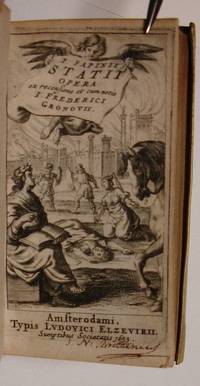
|
|
|
CASSIUS DIO.
Dionis Casii Cocceiani Historiae Romanae libri XLVI partim integri partim mutili partim excerpti. Io. Leunclavii studio tam aucti quam expoliti. Fragmenta priorum XXXIV amissorum & posteriorum XX librorum. Notae Leunclavii quibus Dionia plurima restituuntur. Adiectus index copiosissimus.
Frankfurt Francofurti Apud Andreae Wecheli heredes Claudium Marnium & Ioan. Aubrium 1592. 8vo. XVI11011105 index1 printer's mark p. 1 folding table. Vellum 18 cm Ref: VD16 D 1794; Hoffmann 1551; Dibdin 505/06; Graesse 2393/94 Details: 5 thongs laced through the joints. Wechel's woodcut printer's mark on the title and the last page depicting the winged horse Pegasus gracefully arched over a caduceus and 2 intertwined cornucopiae. Inserted is a folding table with a genealogical tree of the Iulii from Caesar to Nero. This book contains a Latin translation of the extant books libri 36/60 covering the years 68 B.C - 47 A.D. of Dio Cassius' Roman History supplemented with the books 61/80 till 229 A.D. epitomized by the Byzantine historians Johannes Xiphilinus and Zonaras. After this translation follow fragments of the 'Historia Romana' in Greek accompanied by a facing Latin translation followed by the Greek text only of the fragments of the first 20 books. At the end of this work 99 pages with critical notes of Leunclavius Condition: Vellum soiled especially the back. Ownership inscription on the front pastedown and the title. Name cut out of the title at the lower edge resulting in a hole of 35x12 cm. Paper yellowing Note: Dio Cassius Cocceianus of Nicaea in Asia Minor was born ca. 164 A.D. He held several high state offices twice consul. He wrote in Greek a Roman history Rh�maik� Historia in 80 books from the founding of the city of Rome till 229 A.D the year of his own second consulate. His work 'appears to be based on republican annalistic tradition Livy or Livy's sources . imperial annalistic tradition and for contemporary events' the time of Marcus Aurelius and the Severian dynasty 'his own high authority. Unreliably about republican institutions and conditions from Caesar onwards he used his constitutional experience at first colouring events with his ideas of imperial absolutism . but later handling his material with full knowledge. Annalistic in arrangement . his narration concentrated on political aspects in the manner of Thucydides giving a rhetorical narrative in Atticist style'. OCD 2nd ed. p. 345 � The 'editio princeps' of Cassius Dio was published in 1548 by Robertus Stephanus. The first Latin translation appeared ten years later in Basel and was made by the German scholar Xylander in German Wilhelm Holzman 1532-1576. He was professor of Greek at the University of Heidelberg and a translator and editor of late antique and byzantine writers. He produced e.g. the 'editio princeps' of Marcus Aurelius' Meditations. His gifted pupil Johannes Leunclavius or Hans Loewenclau 1541-1594 who had hoped to succeed Xylander in 1576 but failed because he was considered to be a 'cryptocalvinist' revised and augmented Xylander's translation of Cassius Dio and had it published in 1592. Leunclavius added also a collection of critical notes of his own. Leunclavius is known for his Latin translations of Greek church fathers Gregorius Nazianzenus 1591 Gregorius Nyssenus 1567 and of Xenophon 1569 1594 and Zosimus 1576 1593. He edited and translated following the steps of Xylander several Byzantine authors among whom the 'Apomasaris Apotelesmata' a dreambook 1577 the Annales of Michael Glykas 1572 and Constantine Manasse 1573. With his edition of the Basilica 1575 and his posthumously published 'Juris Graeco-Romani tomi II' 1596 he is considered to be one of the founders of the study of the Byzantine legal system. Neue Deutsche Biographie 15 1987 p. 95 f. Provenance: On the front pastedown: 'Petrus Iaenichius Thorn 1738'. Petrus Iaenichius in German Peter J�nichen 1679-1738 published in Wittenberg in 1706 a 40 page theological dissertation 'Christianismum Stoicum hodieque redivivum'. On the title the author is referred to as 'hactenus Fac. Phil. adiunctus nunc Illustris Gymnasii Thoruniensis Rector vocatus'. He published in Thorn on the history of Prussia and Poland. The last part of his four volume 'Meletemata Thoruniensia seu dissertationes . ad historiam maxime Polon. et Prussicam . spectantes' was published poshumously in Thorn in 1762. Slavica Gottingensia 1685 & 1686 On the title in old ink: 'A.J' or A.F. v. Hoijm me possidet'. Von Hoijm a variant of Hoym was probably of noble birth. See Wikipedia 'Hoym Adelsgeschlecht' Collation: 8 A-Z8 Aa-Zz8 AA-ZZ8 AAa-FFf8 GGg4 Photographs on request hardcover
Ссылка продавца : 120136
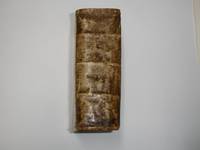
|
|
|
VELLEIUS PATERCULUS.
C. Velleii Paterculi Hist. Rom. ad M. Vinicium Cos. libri duo. Cum annotatis Joannis Henrici Boecleri. Bound with: Joannis Henrici Boecleri Characteres Politici Velleiani.
Strassburg Argentorati Typis Joan. Philippi M�lbii Academiae typographi 1642. 8vo. 2 volumes in 1: XVI2231 blank;366 recte 316177 index3 blank; IV142 p. Vellum 15.5 cm Ref: Schweiger 21127; Graesse 5162 Details: 3 thongs laced through the joints. Title in red and black. After the text of Vellius Paterculus follows the chapter that Vossius devoted to Velleius in his De Historicis Latinis followed by Boecler's Oratio habita an. Christiano 1635 cum privatam Velleii Paterculi interpretationem auspicaretur. Then 265 pages containing the commentary of Boecler and Boecler's 66 p. Dissertatio Thrasybulus Pacificator sive De amnestia Cornel. Nep. in Thrasyb. 32. The index numbers 177 pages. The second volume is Boecler's treatise on the most important personae of Velleius' Historia Romana Condition: name cut out of title to the right of the printer's mark leaving a space of 3.5 x 1 cm. Occasional old ink underlinings and small ink marginalia. Paper yellowing Note: The work of the Roman historian Velleius Paterculus ca. 19 BC - after 30 AD commonly called Historia Romana is a valuable source for the reigns of the Roman emperors Augustus and Tiberius. It is the only history written by a witness of their time. Paterculus who served 'under Tiberius in many of his most important campains seems to have conceived an unbounded admiration for him and the whole imperial family in whose men he could see nothing but sublime virtues while the ennemies were compact of every possible vice' H.J. Rose 'A handbook of Latin literature London 1967 p. 355. Velleius' adulatory type of history was however condemned by the later historian Tacitus who ignores him. The Historia Romana consists of 2 books. The beginning of the first is lost from the founding of Rome to the battle of Pydna in 168 BC in which the Romans defeated the Macedonian kingdom. What remains of book one ends with the fall of Carthago in 146 B.C. Book 2 is of greater importance. 'Book 2 covering the period 146 BC to AD 30 becomes more detailed as it approaches the author's own day doubtless because as he tells us he projected a fuller history from the Civil War onwards.' OCD 2nd edition p. 1111/12. Velleius' style is less polished but we are to remember that he was more a soldier than a rhetorician or scholar. Long time the work of Velleius was considered to be a kind of rhetorical patchwork produced by an opportunistic court historian. However 'erst seit kurzem arbeitet man intensiv an einer Neubewertung des Velleius und seines Oeuvre als eines 'interpretationsf�higen und interpretationsbed�rftigen Textes sui generis'. Neue Pauly 12/1 1170/71 The suggestions notes and emendations of Heinsius are frequently discussed in the normative Cambridge edition of Velleius Paterculus of A.J. Woodman. He observes that he was certainly not a panegyrist but that modern historians sided with Tacitus and have 'invariably tended to accept the criteria which Tacitus laid down for judging the early empire and its rulers. There is no reason why these should be the only valid criteria. The writing of history is an interpretation of various items of evidence: Velleius' own lifetime coincided with the period which he covers in the Tiberian narrative and it is almost always possible to corroborate from other ancient sources the statements which he makes concerning contemporary events. What objection can there be to an historian who recognised the benefits inherent in the imperial system and who devoted his rhetorical skill to the production of a corresponding interpretation of events'. A.J. Woodman 'Velleius Paterculus the Tiberian narrative' Cambridge 1983. p. 53 Cambridge Classical Texts and Commentaries 25 � The German classicist Johann Heinrich Boekleralso Boeckler or Boecler 1610-1672 was an influential teacher at Strassburg and between 1648 and 1652 professor in Uppsala. See the provenance of this book He edited besides Velleius Paterculus also Tacitus Herodian and produced a commentary on Nepos. Sandys 2367 Boeckler followed according to Schweiger the edition of Vossius Leiden 1939. 'Sein Commentar ist vorn�mlich politisch-moralisch aber er besch�ftigt sich auch mit der Erl�uterung der Quellen' Provenance: Uppsala provenance: The name of one Ericus Kinnander inscribed on lower margin of title. This might well be Erik Kinnander born 1702 at Bj�rnstorp student in the �sterg�tland nation at the University of Uppsala in 1727; Doctor of Philosophy in 1737; ordained in 1739; Rector of Eksjoe school Vicar of Lommaryds and B�laryds in 1749. Died 1786. source: website by Mattias Loman in Sweden. The last owner was a successor of Boekler Lennart H�kanson professor of Latin Lit. at the Univ. of Uppsala 1980-1987 Collation: 8 A-2Y8 leaf 2Y7 verso and 2Y8 blank; pi2 A-I8 minus the blank leaves I7 & I8 The pagination jumps form 144 to 195 nothing has however been omitted Photographs on request hardcover
Ссылка продавца : 120182
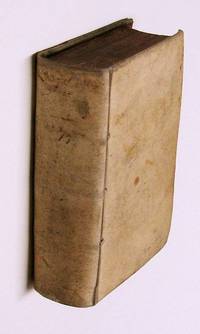
|
|
|
JUSTINUS.
Justini Historiae Philippicae. Variantes lectiones adjecit P. Burmannus.
Leiden Lugduni Batavorum Apud Samuel. Luchtmans 1722. 12mo. Frontispiece XXIV44362 index1 blank p. Contemporary stiff wrappers. 14 cm Ref: Schweiger 2492; Fabricius/Ernesti 366; Graesse 3513; Ebert 11155 Details: Margins uncut. Engraved frontispiece depicting a half naked woman who blows a trumpet that she holds in her left hand; in her right hands she holds a string to which are attached 2 crowns and a laurel wreath; she stands on a globe amidst all kinds of spolia; right of her is a monument with celestial symbols stars and a radiant sun. Is she a combination of Fama Dea Roma Juno Caelestis On the title a woodcut printer's mark that shows a standing woman within an oval wreath; she hold in her right hand a hammer in her left a hook a little flame burns on her head at her feet is a crane that holds a stone in one of its claws. The motto is: 'Deo duce ingenio arte vigilantia labore�Condition: Paper on the back partly gone Note: This is an epitome made by one Justinus probably in the third century A.D. of the 'Historiae Philippicae' of the Augustan historian of Gaulish descent Pompeius Trogus who got his nomen because his grandfather was given Roman citizenship by the Roman military leader Pompeius Magnus after his campaign against Sertorius in Spain. Important parts of Trogus' 'Historiae Philippicae' which numbered 44 books only survive in this epitome of Justin who boiled it down it is estimated to 1/10th or 1/6th. Neue Pauly 10 p. 115 Trogus produced a universal history of the peoples outside Italy. He seems to have used no other sources than Greek historians and his story runs from Ninus king of Assyria to the absorbtion of the other nations into the Roman empire and the establishment of the 'Pax Augusta'. Books 7/12 describe the rise of Philip II and of Macedonia. Books 13/40 treat the Hellenistic kingdoms. 41/42 contain the history of Parthia 43 of Italy and 44 the history of Spain. Inserted are many historical and geographical excursus for example on the history of Armenia or the Jewish wars. The leading concept of Trogus' history was the so-called 'translatio imperii' which conceived history as a linear succession of empires under a singular ruler or emperor. The narrative is elaborate dramatic and moralizing. Trogus was according to Rose an very passable stylist who arranged his second hand material intelligently and showed 'some original views how to write history. . Even in this diminished condition the epitome the history is interesting reading often containing facts not to be met with elsewhere and one of our much too scanty sources for the history of the eastern Mediterranean and the adjacent countries'. H.J. Rose 'A Handbook of Latin literature' 'London 1967 p. 312/13 The epitome of Justin was widely read in the Middle Ages. � This Justinus edition was produced by the Dutch classical scholar Pieter Burman or Petrus Burmannus 1668-1741 from 1696 professor of Eloquence at Utrecht and from 1715 at Leyden. As an editor he confined himself to the Latin classics. He produced editions of the Roman poets Ovid Lucan Claudian and Valerius Flaccus. Of prose the writers he edited Petronius Velleius Paterculus Justin Quintilian and Suetonius'. J.E. Sandys 'A history of classical scholarship' N.Y.1974 vol. 2 p. 445 Burman was not an original scholar but more an industrious manufacturer of so-called 'Variorum' editions from 'cum notis Variorum' editions with a 'textus receptus' which was widely accepted accompanied by an overload of often ill-digested commentaries excerpts and annotations of various specialists and other leading scholars. This Justinus is an exception it is mean and lean; it offers a text borrowed from Graevius without commentary but with occasionally variant readings that were taken from earlier editions of Aldus Giunta Bongarsius Graevius Hearne et aliiCollation: 12 A-X12 Photographs on request unknown
Ссылка продавца : 120091
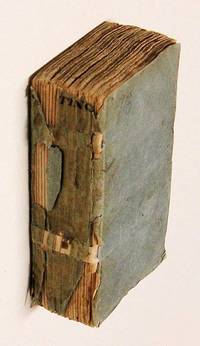
|
|
|
PERSIUS.
Auli Persii Flacci Satirarum liber. Isaacus Casaubonus recensuit & commentario libro illustravit. Ad virum amplisissmum D. Achillem Harlaeum senatus principem. Volume 2: Isaaci Casauboni in Persii Satiras Liber commentarius. Eiusdem Persiana Horatii imitatio
Paris Parisiis Apud Hieronymum Drouart 1615. 8vo. 2 volumes in 1: XV1 blank4341 blank; XXXII55826 index p. Vellum 17.5 cm Ref: Schweiger 2711; Graesse 5212; Ebert 16282; Smitskamp 'The Scaliger collection' no. 116 Details: 5 thongs laced through the joints. The first title shows an engraving of a 'thiasos': a drunken Bacchus is carried off by a bunch of satyrs accompanied by some revellers. The second title has an oval woodcut printer's mark; it depicts a thisle flank by the initials A and D. of Ambrosius Ambroise Drouart the brother of Hieronymus Jer�me. Hieronymus kept using his brother's printer's after his death in 1608; the motto in fact 2 mottoes reads: 'Nul ne s'y frote' 'patere aut abstine' 'let no one meddle' and 'bear of forebear'. The first volume contains a preface the Latin text of the Satires and 18 pages with 'Glossae veteres in Persium'. The second volume contains the commentary of Casaubon Condition: Vellum age-tanned and somewhat soiled. All four ties gone. Endpapers worn and somewhat soiled. First title dustsoiled and its right margin is very thumbed Note: The well-born and well-to-do Roman poet Aulus Persius Flaccus 34-62 A.D. produced during his short life one book libellus with 6 satires together 650 hexameters. 'They are well described as Horatian diatribes transformed by Stoic rhetoric'. OCD 2nd ed. p. 805 The first is 'on the decay of literary taste in his own time and the neglect of the manly Republican authors the second on vanity of wealth and luxury the third on idleness the fourth on self-knowledge the fifth on true liberty the sixth on the proper use of riches'. H.J. Rose 'A History of Latin Literature' London 1967 p. 377 The style is obscure contorted and crammed with allusions to Horace and Lucilius. He was much read in antiquity and admired as a moralist in the Middle Ages but now he is found dull too difficult cryptic too far fetched and too complicated. 'So f�hlte sich zumal das 19. Jh. von seinem vielschichtigen Stil abgestossen w�hrend sich erst neuerdings eine gerechtere W�rdigung durchsetzen beginnt'. Neu Pauly 9 619 A specimen of this new appraisal is the following quote: 'The elements of composition in Persius' satires - words and ideas images steps in the argument registers of speech and literary style speeches in dramatic dialogue- are abruptly or peculiarly even bizarrely combined. One is faced by an unpredictable surprising series of conceptions; continuous attention is necessary if one is to understand. However the surprises and incongruities are often observably intelligent apt and curiously artistic. From a literary point of view the quality of continual surprise in Persius' style makes the Satires amusing to read'. J.R. Bond 'Persius the Satires' Warminster 1980 p. 5 � This 1615 Persius edition is a reissue of the edition previously published in 1605 also from the presses of the Drouart brothers. The Latin text was based on that which was edited by the French scholar Pithou in Paris in 1585. The edition of 1605 and its extensive commentary were produced by the French protestant scholar Isaac Casaubon 1559-1614 the first critical commentator of Persius. His preface is a vigorous defense of Persius' Stoic earnestness end philosophic constancy. 'The ethical interest is strong in his Persius 1605 on which he had lectured at Geneva and Montpellier and his commentary on the Stoic satirist of which Scaliger said that the sauce was better than the meat was reprinted in Germany as late as 1833 and has been ultimately merged in Conington's edition' of 1872 Provenance: On the front pastedown the name: 'E.A. Groenman 1839'. We found an Albertus Groenman 1814-1861 member of the 'Provinciale Staten van Groningen' from 1851 till 1859 elected for Zuidhorn profession manufacturer and merchant. He might have been the owner once Collation: a8 A8 b-c8 �8 �8 A-Z8 2A-2NO8 2O4 Photographs on request hardcover
Ссылка продавца : 120143
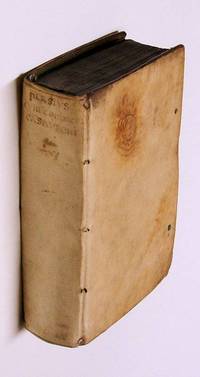
|
|
|
DEMOSTHENES & AESCHINES.
Demosthenis et Aeschinis Mutuae accusationes de ementita Legatione et de Corona ac contra Timarchum quinque numero cum earum argumentis ipsorum oratorum vita et Aeschinis Epistola ad Athenienses ac indice copioso. Nuper a bene docto viro traductae. Dictorum series versa pagina conintetur. Cum Privilegio Veneto.
Venice Venetiis Apud Hieronymum Scotum 1545. 2231 blank leaves. Limp overlapping vellum. 16 cm Ref: Edit16 CNCE 16736; Hoffmann 1528 Details: Latin translation only. 5 thongs laced through the joints. Woodcut printer's mark on the title and the verso of the last leaf blank depicting a branch of olive and a palm tree graft onto trunk with between them an anchor; anchor and trunk are held together bij the initials SOS Signum Octaviani Scoti; a banner runs around with the motto: 'In tenebris fulget'. Printed in italis except for the title. Some historiated and ornamental woodcut initials Condition: Vellum age-tanned and slightly soiled. 2 tiny holes in both boards because of the 2 ties which have disappeared Note: In the preface of this book the learned anonymous translator explains his readers that it was his aim to collect for those who are not able to read Greek qui graeca non legerant in one volume in unum eundemque codicem ac seorsum ab reliquis five speeches translated into Latin of Demosthenes and Aeschines because those speeches full of mutual accusations and attacks belonged together inter se sint connexae . ut una ab altera divelli non possit. They shared the same actors and the same subject matter and showed to the consent of all the power of speech and the art of oratory in her perfection tota ars dicendi & vis orandi. Demosthenes and Aeschines were at daggers drawn and therefore the collections begins with the 'Contra Timarchum oratio' because this speech was the beginning of their enmity quod inde Demosthenis & Aeschinis inimicitiae exordium habuerint. In this preface he severely criticizes the clumsy Latin translation of Leonardus Aretinus Leonardo Aretino known to us also as Leonardo Bruni ca. 1370-1444. He calls his translations 'mendosae' and unreliable. The anonymous translator not only translated speeches of Demosthenes and Aeschines he added also relevant material from other sources such as Libanius Philostratus and Apollonius which he now translates into Latin for the first time adiunctis tam Libanii quam aliorum argumentis ad eas ipsas orationes. Interpres lectori S.P.D. leaf 2/3 Translated are beside Aeschines' 'Contra Timarchum Oratio' the 'Oratio de ementita legatione' of Demosthenes and Aeschines now commonly known as 'De falsa legatione' and the 'Oratio contra Ctesiphontem de Corona' and the 'Oratio de Corona pro Ctesiphonte' of both men. Added are biographic sketches argumenta and testimonia. � The Athenian Demosthenes 384-322 BC was without doubt the greatest orator of his time. His surviving speeches are mostly connected with his politics. He was a fierce opponent of Philippus II king of Macedon since 359 who gradually tried to subject the whole of Greece. In 351 he delivered his first Philippic against him. His speeches against Philippus known as Philippics are one long warning against the growing Macedonian power. Demosthenes attacked also the pro-Macedonian elements in Athens who sought peace with Philippus and wanted to give in. One of their leaders was the orator Aeschines 389-314 BC. In 345 Demosthenes and his Athenian ally Timarchus tried to impeach in a speech called 'De falsa legatione' or 'On the false embassy' Aeschines 'for wilfully neglecting the interest of Athens as a member of the embassy which had negociated the peace' H.J. Rose A handbook of Greek literature London 1965 p. 291. Demosthenes held Aeschines responsible for Philip's use of the peace negotiations to intervene in other Greek city-states. Demosthenes was unsuccessful and Aeschines was acquitted having delivered a speech in which he defends himself against accusations of treason and collusion with the enemy. Instead of refuting the accusations directly Aeschines used Athenian Civil Procedure to argue against Timarchus as a qualified prosecutor. The feud reached its peak in 330 with Demosthenes' most famous oratorical effort the so-called speech 'On the Crown'. A member of his party Ctesiphon had proposed in 336 to honor Demosthenes for his services as was customary with a golden crown. Nothing came of it the next 6 years mainly because Aeschines accused Ctesiphon of legal irregularities but in effect he attacked Demosthenes' policy. In 330 after a charge of Aeschines 'Demosthenes replied in the masterpiece commonly known in modern times as the 'De Corona'. It is partly a formal rebuttal of the charge against Ktesiphon but this is the weakest part of it for technically Aischines had the law on his side. Substantially it is a magnificent defence of the principles guiding the anti-Macedonian party justifying them in face of failure. Less to modern taste is its bitter personal attack on Aischines who however had not spared Demosthenes in his own speech'. Rose p. 292 Provenance: On the front flyleaf in pencil '7 januari 1961' written by the Flemish linguist Walter Couvreur 1914-1996 who was an Orientalist and professor of Indoeuropean linguistics at the University of Gent. It indicates the date of aquisition. The place of acquisition he wrote on the flyleaf at the end: 'Turijn Bottega d'Erasmo' Collation: A-2E8 pagination sometimes irregular Photographs on request hardcover
Ссылка продавца : 120062

|
|
|
CICERO.
M. Tullii Ciceronis Epistolarum libri XVI. Ad familiares ut vulgo vocantur ex recensione Io. Georgii Graevii cum ejusdem animadversionibus.
Amsterdam Amstelaedami Apud Henricum Wetstenium 1689. 12mo. Frontispiece X63815 indices1 blank p. Boards of ca. 1800. 16 cm Ref: Schweiger 2162; Dibdin 423; Moss 1329; Graesse 2169 Details: Gilt black shield on the back. The frontispiece depicts a seated Cicero giving a messenger a letter. Title in red and black Condition: Cover scuffed worn at the extremes. Head & tail chafed. Shield slightly damaged. Front joint cracking but strong. Paper slightly yellowing Note: For centuries the Roman orator author and politician Cicero retained a central position as a school author and a model for good writing on protestant schools and in Jesuit colleges. The period of his greatest glory was the Renaissance when he became the object of a literary cult called Ciceronianism. Many humanists took him as an absolute model for pure Latin and an elegant style. Petrarch modeled his own 'Epistolae Familiares' in part on Cicero's 'Epistulae ad Familiares'. Petrarch created like Cicero in his letters 'a kind of autobiography and a partial history of his own life and time. Even as Petrach rebuked Cicero for being too Ciceronian in other words he helped establish Cicero as a uniquely powerful stylistic model and intellectual resource'. The Classical tradition N.Y. 2010 p. 196 The Epistulae ad Familiares form a part of the epistolary oeuvre of Cicero consisting of letters addressed to public figures like Pompeius Magnus Caesar and Pollio et personal letters to his wife Terentia or his secretary Tiron. They were written between 63 and 43 B.C. and are arranged according to the addressee. The style of Cicero's letters varies very much. Many of them deal with official business there are also polished manifesto's in letter form. 'Others have a less formal tone while others again . on private affaires have no stylistic pretensions at all but consist of short elliptic sentences packed with idiomatic phrases. . This . shows the essential soundness of his style; it was not an artificial dialect for the use of literary men but the speech of his own people purified carefully arranged and made more flexible and expressive'. H.J. Rose 'A handbook of Latin literature' London 1964 p. 165 The Dutch classical scholar of German descent Johann Georg Greffe or Graeve better known als Graevius 1632-1703 professor of Latin at the Univerisity of Utrecht during the last forty years of his life edited separate editions of Cicero's Letters De Officiis Cato Laelius Paradoxa and the Somnium Scipionis and the speeches. He published also between 1684 and 1699 an 'opera omnia' edition of Cicero 'cum notis Variorum' Collation: pi1 frontispiece 6 minus leaf 6 A-2D12 2E4 minus blank leaf E4 Photographs on request hardcover
Ссылка продавца : 120047
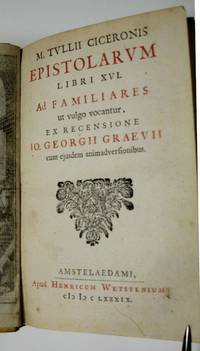
|
|
|
TURSELLINUS H.
Horatii Tursellini Romani Historiarum ab origine mundi usque ad annum a Christo nato 1598. Epitomae libri decem. Cum brevibus notis duplici item accessione usque ad annum 1642 ac duplici indice. Editio ultima a quamplurimis mendis nunc demum purgata.
Utrecht Ultrajecti Apud Gulielmum vande Water 1718. 8vo. XVI56674 index p. frontispiece. Vellum 16.5 cm Ref: cf. Graesse 6/2216 Details: 5 thongs laced through the joints. Boards blind tooled. Frontispiece engraved by P. Sluyter probably depicting the Muse Clio a winged woman with a quill in her hand and a laurel wreath on her head; she is visited by several allegorical figures such as Father Time and a naked woman with a palm branch Victoria in her hand; in the background is Fama who blows her horn. Title printed in red and black. Woodcut printer's mark on the title depicting Fama hovering above a city the motto is: 'Pax artium altrix' Condition: Vellum somewhat soiled ans spotted. Small inkstain on the front board. All four ties gone Note: Not much is known about the Italian Jesuit scholar Orazio Torsellini or Orazio Torsellino latinized as Horatius Tursellinus 1545-1599. Tursellinus taught at several Jesuit Colleges in Italy and lectured for 20 year at the 'Collegium Romanum' in Rome. His most important works are De particulis latinae orationis a biography of the Jesuit missionary Franciscus Xaverius published in 1596 and a universal history Epitome Historiarum libri X which treated in 10 books the complete history from Adam till 1598 and which remained popular for centuries on schools and universities. For a long time it was used even at the protestant universities in the Dutch Republic. 100 or more editions and adaptations were produced until 1845. Right from the start it was a success and became a standard. The book was reissued in Italy in Rome Venice Milan and Perugia in France in Douai Lyon Paris Rouen Caen Toulouse and in Germany in Cologne M�nchen and Frankfurt generally cities where Jesuits had their colleges. The first edition in the Low Countries appeared in The Hague in 1678 and was edited by Johann Conrad Nuber who introduced this manual at the University of Leiden. In 1688 and in 1695 it was reissued in Franeker followed by editions produced by the Utrecht printer W. vande Water in 1710 1718 1730 and 1744. In 1708 a Dutch translation was published in Amsterdam. The manual was published for the last time in The Low Countries in 1786. The continuatio till 1624 incorporated in this edition of 1718 was produced by the French historian Henri de Sponde Henricus Spondanus and adopted from his Annales Baronii. See for Tursellinus: H.W.A.M. Sancisi Weerdenburg 'Lege veteres sperne recentiores : Tursellinus en het achttiende-eeuwse geschiedenisonderwijs' in Utrechtse Historische Cahiers Jaargang 17 1996 1: 'Studeren en promoveren in Utrecht' p. 22/35; and also 'Biographie Universelle ancienne et moderne' Paris 1826 vol. 46 p. 233/4. � This historical work is of course outdated but nowadays every classical scholar still knows Tursellinus which is to say that he/she knows and sometimes uses: 'Tursellinus seu de particulis Latinis commentarii' in the edition that was published by the German scholar Ferdinand Gotthelf Hand Leipzig 1829/45 and later reprinted by Hakkert in 1969. This work first published in Rome as De particulis latinae orationis and brought Tursellinus fame among classical scholars. It offered the student of eloquence the means to speak coherently by the correct use of those small particles and adverbs which glue his speech together. Tursellinus his highly praised by H.J. Sandys for his accurate scholarship Collation: pi1 8 minus leaf 8 = pi1 A-2R6 Photographs on request hardcover
Ссылка продавца : 120176
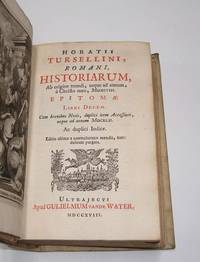
|
|
|
JOSEPHUS FLAVIUS.
Fl. Iosephi Omnia quae extant opera. Tomus I & II: Quorum hic tomus I& II continet Antiquitatum Iudaicarum libros decem priores et libri X posteriores.
Lyon Lugduni Apud Seb. Gryphium 1546. 8vo. 2 volumes: LXXII index5521 blank1 printer's mark; 5261 blank1 printer's mark p. 20th century leather 18 cm Omnia quae extant opera vol. 1 & 2: De antiquitatibus Iudaeorum libri XX Ref: Schreckenberg p. 7 Schreckenberg Supplementband p. 167; Hoffmann 2450; Graesse 3481 Details: These 2 volumes are the volumes 1 & 2 of a 3 volume set 'Omnia quae extant opera' and they contain the complete Latin translation of 'De antiquitatibus Iudaeorum libri XX'. Volume 3 with the remaining works of Josephus is lacking. On the titles are the printer's mark of Sebastianus Gryphius depicting a griffin which mythological animal symbolizes courage diligence watchfulness and rapidity of execution used as a pun of his family name Gryph or Greif. From the claws of this creature hangs a big rectangular stone symbolizing Constancy beneath which is a winged globe symbolizing Fortune. The motto is 'Virtute duce / comite fortuna' 'Virtue thy leader fortune thy comrade' a quote from a letter of Cicero to Plancus Epistulae ad Familiares liber X3. On the last page of both volumes a woodcut griffin Condition: Old leather binding covered with untanned leather. Binding with traces of wear. Front hinge of volume 1 cracking. Flyleaves absent. Both pastedowns of volume 2 renewed. Titles somewhat soiled and with a small inscription. A name on the first title neatly erased. Small paper label on the title of volume 2. Small tear in title of volume 2 because of overstretch in the margin. Occasional old and small ink underlinings. One old and small ink annotation in German Note: Flavius Josephus born 37/38 A.D. 'was a Jewish priest of aristocratic descent and a Pharisee. Though a zealous defender of Jewish religion and culture politically he was pro-Roman and without sympathy for extreme Jewish nationalism'. His first work was a history of the First war of Palestine Jews against the Romans which raged from 66 till 70 A.D. and of which the author was an eyewitness. The war ended with the fall of Jerusalem the walls and Temple were destroyed and most of its inhabitants were enslaved. Josephus who tried to follow the objective methods of Thucydides and Polybius wrote this history in Aramaic 'of which a Greek translation the extant 'Bellum Judaicum' in seven books appeared between 75 and 79. . His next work the 'Antiquitates Judaicae' in twenty books published 93/94 is a history of the Jews from the Creation to immediately before the outbreak of the war giving a fuller account of the period from the Maccabees to A.D. 66 than that in 'Bellum Judaicum' and showing a more hostile attitude to Herod the Great'. OCD 2nd ed. p. 565 Josephus probably wrote this work sometimes also called 'Judaica Archaeologia' to defend the sacred history of the Jews and 'to show that Jewish tradition was as ancient and trustworthy as the Egyptian and Mesopotamian traditions and surely preceded Greek culture. The Classical Tradition Cambr. Mass. 2010 p. 497 � The 'editio princeps' of the Greek text of the complete works of Josephus was published in Basel in 1544 by Frobenius and was edited by Arnoldus Peraxylus with the help of Sigismund Gelenius. The 'editio princeps' of the ancient Latin translation of 'De antiquitatibus Judaeorum' was published much earlier in Augsburg in 1470. See Schreckenberg p. 1 This translation is sometimes ascribed to the Roman statesman and author Cassiodorus born ca. 485 died after 580 who served in the administration of Theoderic the Great king of the Ostrogoths. He however didnot translate it but he commissioned the translation. He mentions this explicitily in his Institutiones 1:171: 'Ut est Iosephus . Hunc tamen ab amicis nostris quoniam est subtilis nimis et multiplex magno labore in libris viginti duobus converti fecimus in Latinum'. 'Ich habe ihn aber dennoch von meinen Freunden unter viel M�hen- er gilt ja als ungemein scharfsinnig und vielschichtig- in 22 B�chern ins Lateinische �bertragen lassen'. Cassiodor Institutiones Divinarum �bersetzt und eingeleitet von W. B�rsgens Freiburg etc. 2003 p. 222/223 This Gryphius edition of 1546 is a reissue of that translation of 1470 Provenance: In the first title are faintly discernable traces of 6 blind stamped capitals: 'LDDAVH'. A name Collation: alpha-epsilon8 zeta4; a-z8; A-L8 M4; aa-KK8 Photographs on request hardcover
Ссылка продавца : 120138
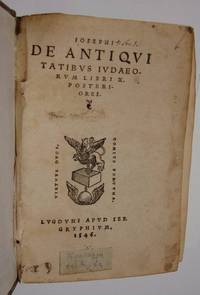
|
|
|
BARLAEUS CASPER.
Casparis Barlaei Antverpiani Poematum pars II: Elegiarum et Miscellaneorum carminum.
Amsterdam Amstelodami Apud Joannem Blaeu 1646. 12mo. VIII576 p. Overlapping vellum 13 cm Details: 5 thongs laced through the joints. Woodcut printer's mark on the title depicting a celestial sphere flanked by Tempus and Hercules motto: 'Indefessus agendo'. This is the second volume of a two volume set. The first volume was published in 1645 by Blaeu simply as 'Poemata' Condition: Vellum age-toned. Old name on the title. Faint waterstain in the upper and lower margin of most quires. Note: When he was one year old the Flemish parents of the Dutch polymath poet theologian and historian Caspar Barlaeus 1584-1648 had to flee Antwerp for the 'Spanish fury'. 'They settled in Zaltbommel where his father eventually would become head of the Latin school. Caspar studied theology and philosophy at the University of Leiden. After his study he preached for 1.5 years in the village of Nieuwe-Tonge before returning to Leiden in 1612 as an under-regent of a college. From 1617 he also was professor in philosophy at the university. Because of his remonstrant sympathies he was forced out of this job in 1619. He then studied and graduated in medicines in Caen but never practiced professionally. . From 1631 he was professor of philosophy and rhetoric at the Amsterdam Athenaeum Athenaeum Illustre which is commonly regarded as the predecessor of the University of Amsterdam. . Barlaeus published many volumes of poetry particularly Latin poetry. He also wrote the eulogy that accompanies the 1622 portrait of cartographer Willem Blaeu' the father of Johannes Blaeu the publisher of this fourth enlarged edition of 1645-1646. Source Wikipedia English Provenance: From the library of Andrew Fletcher of Saltoun 1653-1716 a Scottish author and politician. He was leading the opposition against the 1707 Act of Union between Scotland and England. He also was an passionate book collector Collation: 4 a-z12 h3 = k3 2a-2b6 chi4 Photographs on request hardcover
Ссылка продавца : 120033
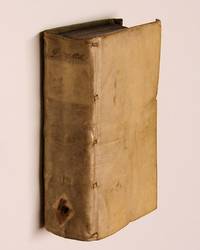
|
|
|
ERASMUS.
Desiderii Erasmi Roterodami Precationes quibus homines assuescant cum Deo loqui. Item precatio dominica. Bound with: Desiderii Erasmi Roterodami Explicatio in Symbolum Apostolorum & Decalogum. And: Desiderii Erasmi Roterodami De sarcienda Ecclesiae concordantia deque sedandis opinionum dissidiis cum aliis nonnullis lectu liber. And: Desiderii Erasmi Roterodami Querela Pacis undique gentium ejectae profligataeque. And: Desiderii Erasmi Roterodami Consultatio de bello Turcis inferendo.
Leiden Lugduni Batavorum Ex officina Ioannis Maire 1641-1642. 12mo. 5 volumes in 1: 1368 blank;264;I-IV blankV-XII1764 blank;76;913 blank p. Overlapping vellum. 13 cm Ref: Ebert 6862; Ad 1: Breugelmans p. 479 1641:11A. Ad 2: Breugelmans p. 475 1641:8. Ad 3: Breugelmans p. 493 1642:6. Ad 4: Breugelmans p. 483 1641:A. Ad 5: Breugelmans p. 509 1643:3. Graesse 2493 Details: 5 thongs laced through the joints. Short title in ink on the back. Woodcut printer's mark on all 5 titles depicting a farmer stamping a shovel into the ground above the head of the farmer the motto 'fac et spera' Condition: Vellum age-toned. 2 old ink annotations a few pencil underlinings. Bookplate on front pastedown Note: Joannes Maire publisher printer and bookseller in Leiden 1603-1657 produced during his career a number Erasmus of editions. The project 'that can be seen as a series and which ensured Maire's reputation through the ages is undoubtedly his edition of Erasmus's 'opera omnia' in 12mo. 23 different volumes appeared between 1641 and 1652. It has long been thought that Petrus Scriverius was the editor but now there is proof that in fact Willem Henricus Vorstius did the job'. Breugelmans p. 24. Vorstius was a very learned Remonstrant theologian and minister living in the small town of Warmond where he died in 1652. NNBW 101136 Ad 1: The precationes were first published in Basle in 1535. It is a collection of 27 prayers to which Erasmus appended another series of 35 shorter prayers Provenance: An ex libris of Leo Polak on front pastedown. Leo Polak born 1880 died 1941 in Sachsenhausen was professor of philosophy at the University of Groningen; he was a humanist and freethinker Collation: 1: A-F12 F9/12 blank. Ad 2: A-L12. Ad 3: 6 leaf 1 & 2 blank A-G12 H6 leaf H5 & 6 blank. Ad 4: A-C12 D2. Ad 5: A-D12 leaf D10 verso & D11 blank; minus blank leaf D12 Photographs on request hardcover
Ссылка продавца : 120061

|
|
|
SENECA. GRONOVIUS JF. J. F.
Joh. Fred. Gronovii Ad L. & M. Annaeos Senecas Notae.
Amsterdam Amsterlodami Apud Ludovicum & Danielem Elzevirios 1658. 12mo. XXIV49025 index1 blank p. Overlapping vellum 14 cm Ref: Willems 1228; Berghman 1280; Rahir 1257; Copinger 1974; Schweiger 2912 Details: 6 thongs laced through the joints. Woodcut printer's mark of Louis and Daniel Elzevier on the title depicting Minerva under an olive tree. She holds a banner with the motto: 'Ne extra oleas' to be understood as 'Stay within the bounds of wisdom'. The Amsterdam Elseviers Louis and Daniel Elsevier produced more than 600 editions and 256 of them have this motto 'ne extra oleas'. It seems more or less the equivalent of the printer's mark a philosopher under an olive tree and the motto of the famous French scholar/printer Robertus Stephanus 'noli altum sapere' 'Be not high-minded'. Stephanus' printer's mark and motto clearly inspired the Elseviers. See for the motto and its sources wwwjstor.org/stable/289286seq=6#page_scan_tab_contents Condition: Vellum age-tanned and slightly worn Note: The classical scholar of German descent Johann Friedrich Gronov 1611-1671 or Johannes Fredericus Gronovius was the successor of Heinsius at the University of Leiden and was influenced by Vossius Grotius Heinsius & Scriverius. His editions mark an epoch in the study of Livy of Seneca Tacitus & Gellius. The pages 1-351 contain Gronovius' notes on the Dialogues the Letters Quaestiones Naturales and the Apocolocyntosis of the Roman author statesman and Stoic philosopher Lucius Annaeus Seneca ca. 4 B.C. - 65 A.D. Pages 352-492 contain Gronovius' notes on the Suasoriae and Controversiae of Seneca's father the rhetor Marcus Annaeus Seneca ca. 55 - ca. 39 A.D. also known as Seneca Maior or Seneca Pater. � A year later in 1659 the Elzevier brothers published a reissue of Gronovius' edition of the Opera Omnia of Seneca. Willems 1251 The Opera Omnia and the Notae were first published in 1648 in Leiden. The volumes of 1648 and 1658 containing the Notae were published separately and are often added as volume 4 to these 3 volume sets Provenance: On the front pastedown in pencil: 'J. v. Dijck' Collation: 12 A-X12 Y6 leaf Y6 verso blank Photographs on request hardcover
Ссылка продавца : 120161
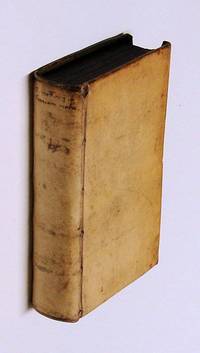
|
|
|
CAMERARIUS J.
Notatio figurarum orationis et mutatae simplicis elocutionis in apostolicis scriptis ad perspiciendam de intellecto sermone sententiam autorum studio Ioachimi Camerarii Pabepergensis.
Leipzig Lipsiae Edita in Officina Valentini Papae 1556. 8vo. XVI368 p. Modern hardback. 16.5 cm Ref: VD16 C 485; cf. Brunet 11513 he mentions only the edition of Leipzig 1572 Details: Modern and modest binding; the second and last gathering of the introduction 8 leaves is missing; this last half of the introduction is added in photocopy. Some woodcut inititals Condition: Paper on the boards very superficially damaged. The second and third leaf of the first gathering are loose the remaining leaves of this first gathering are loosening; the last gathering of the introduction is missing Note: The German classical scholar Joachim Camerarius was born in 1500 in Bamberg. He died in Leipzig in 1574. He held classical professorships at N�rnberg T�bingen and Leipzig and was one of the most significant representatives of Renaissance humanism in the Reformation. His interests were diverse and his productivity spectacular. 'His numerous editions of the Classics without attaining the highest rank are characterised by acumen en good taste'. In critical acumen Camerarius 'holds one of the foremost places among the German scholars of the sixteenth century'. J.E. Sandys 'A history of classical scholarship' N.Y. 1964 p. 266/67 He also wrote poetry produced biographies of famous contemporaries and wrote on church history theology and paedagogy. His wrote his works for academic students explaining matters of style rhetoric and grammar. 'Der Ehrenplatz in seinem Werk geb�hrt seiner erstmal in 1552 in Basel gedruckten vollst�ndigen Edition der plautinischen Kom�dien welche in der Geschichte der neuzeitlichen Plautus-Philologie eine neue Phase inaugurierte'. Neue Pauly Suppl. 6 p. 195. In this 'Notatio figurarum orationis' we see Camerarius at work this time on the 'Letters of the Apostles' which form a part of the 'New Testament'. Here he gives special attention to rhetorical and stylistic explanations of the text. In 1572 Camerarius published in Leipzig an augmented and revised edition. He added his 'notationes' on the remaining books of the 'New Testament' the 'Acts of the Apostles' and the 'Apocalyps'. The book seems to be rare. We found only a few copies in Germany Austria and England in KVK Collation: Aa-8 Lacking Bb8 A - Z-8 Photographs on request hardcover
Ссылка продавца : 120040
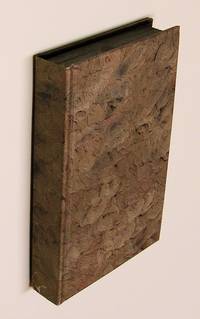
|
|
|
JUSTINUS.
Iustinus Trogi epitomator cum notis perpetuis ad modum Iohannis Minellii ad optimos codices emendatus & illustratus: adiunctis Chronologia Iustiniana & indice uti locupletissimo ita accuratissimo. Editio quinta revisa emendata atque aucta. Cum Priv. Sereniss. Regis Polon. ac Elect. Sax.
Leipzig Lipsiae Ex officina Weidmanniana 1739. 12�. Ref: XX617223 index p. Half vellum 14.5 cm Interesting reading of a very passable stylistRef: Schweiger 2493 Details: Engraved frontispiece it depicts a Roman historian who is dictating to a secretary; above them on a tapestry the scene of Europa on her bull. Title in red and black. Woodcut monogram on the title Condition: Binding scuffed and worn at the extremes. Remnants of marbled paper which was once pasted over the vellum strip on the back. Paper on the boards worn. Paper label on the back. Small name on the title. Paper yellowing as usual with Weidmann books. In short: not a very elegant book but internally quite decent Note: This is an epitome made by one Justinus probably in the third century A.D. of the 'Historiae Philippicae' of the Augustan historian of Gaulish descent Pompeius Trogus who got his nomen because his grandfather was given Roman citizenship by the Roman military leader Pompeius Magnus after his campaign against Sertorius in Spain. Important parts of Trogus' 'Historiae Philippicae' which numbered 44 books only survive in this epitome of Justin who boiled it down it is estimated to 1/10th or 1/6th. Neue Pauly 10 p. 115 Trogus produced a universal history of the peoples outside Italy. He seems to have used no other sources than Greek historians and his story runs from Ninus king of Assyria to the absorbtion of the other nations into the Roman empire and the establishment of the 'Pax Augusta'. Books 7/12 describe the rise of Philip II and of Macedonia. Books 13/40 treat the Hellenistic kingdoms. 41/42 contain the history of Parthia 43 of Italy and 44 the history of Spain. Inserted are many historical and geographical excursus for example on the history of Armenia or the Jewish wars. The leading concept of Trogus' history was the so-called 'translatio imperii' which conceived history as a linear succession of empires under a singular ruler or emperor. The narrative is elaborate dramatic and moralizing. Trogus was according to Rose an very passable stylist who arranged his second hand material intelligently and showed 'some original views how to write history. . Even in this diminished condition the epitome of Justin the history is interesting reading often containing facts not to be met with elsewhere and one of our much too scanty sources for the history of the eastern Mediterranean and the adjacent countries'. H.J. Rose 'A Handbook of Latin literature' 'London 1967 p. 312/13 The epitome of Justin was widely read in the Middle Ages. � The epitome of Justin was a popular school book in the Netherlands and Germany. The style was passable the historic content edifying. It was apparantly read in the lower classes by the younger pupils. Justin was a also a popular gift for excelling schoolboys. The Schola Latina of 's Hertogenbosch for instance awarded in the four years between 1665 and 1668 96 prize books of Latin authors. 38 40 % of them were of Roman historians like Florus Suetonius Tacitus. Of these 38 prize copies 13 one third were editions of Justin. All Justin editions were in octavo or duodecimo format and offered to pupils of the lowest grades. J. Spoelder 'Prijsboeken op de Latijnse School' Amsterdam/Maarssen 2000 p. 331/33 � This school edition of Justin was made in the manner made popular by the Dutch schoolmaster Johannes Min-Ellius ca. 1625-1670. Minellius or Min-ellius produced several school editions of Latin authors such as Vergil Florus Horace Terentius and Ovid with ample annotations in easy Latin. One seldom sees a school edition of Min-Ellius in good condition. Minellius was educated at the Erasmianum at Rotterdam and was until his death a Praeceptor at the same school. At the end of the 17th and in the 18th century his editions were widely used not only on Dutch grammar schools but also on German English and Danish schools. After that they were barred from the schools because they were too unscientific and offered too much help. They were esteemed to be 'pontes asinorum'. Nevertheless they were succesful. The publisher Weidmann obviously wanted to exploit this success. The preface leaf 2 which is dated 1732 and signed by the 'Bibliopola' lists a second edition in 1709 a third in 1715 a fourth in 1725 and announces the fifth of 1732. This book is according to the title a revised and augmented edition of that fifth edition Collation: 10 A-2M12 Photographs on request hardcover
Ссылка продавца : 120092
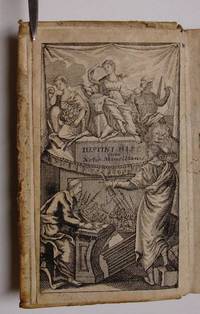
|
|
|
CRAVETTA AYMOON.
Tractatus de antiquitatibus temporum D.N. Aymonis Cravettae a Saviliano iureconsulti clarissimi et Senatoris Illustrissimi Ducis Ferrariensis. Quaestio item in utranque partem super Statuto Ferrariensi de mulierum indemnitatibus. Quibus D. Cravettae repetitionem Rubricae de Legatis Primo nove adiecimus.
Venice Venetiis Apud Bevilaquam 1565. 8vo. 733 recte 71987 index2 series cartarum and printer's mark2 blank p. Overlapping limp vellum 16 cm Ref: Edit16 CNCE 13695 Details: 3 of 5 thongs laced through the joints. Printer's mark on the title depicting 'Patientia' a woman chained to a rock on which rests a kind of urn and a celestial sphere; the motto is: 'Superanda omnis fortuna' after Vergil's 'Quidquid erit superanda omnis fortuna ferendo est'. Aeneis 5710 On the last page a repitition of this printer's mark; old short title in ink on the lower edge of the bookblock Condition: Vellum wrinkled & worn. 2 thongs gone. Remains of an old paper label at the head of spine. Small hole in the paper of the front flyleaf near the gutter. Old and faint ownership entry on the title and the verso of the front flyleaf. Occasional small old ink marks annotations & underlinings. Some insignificant waterstains Note: The Italian Aimone Cravetta 1504-1569 was a jurist and 'Senatore del duca di Ferrara' professor of civil law at Grenoble Avignon Turin Ferrara and Pavia. He was born in Savigliano in the province of Cuneo. Dizionario Biografico degli Italiani volume 30 1984 He was called the 'Principe de' Legisti Piemontesi' worth consulting 'Cravetta dixit sat est' C. Novellis 'Storia di Savigliano e dell'abbazia di S. Pietro' Torino 1844 p. 320 In his hometown there is a high school named after Aimone Cravetta Provenance: On the title probably: 'Jacobi P.St. Portalyn J.C. . emptus place die 12 9bris novembris 1591'. On the verso of the front flyleaf probably: 'A.C. Collegg. Fransisci Leonard' Collation: A-2Z8; 2A-2D-8 2E4 leaf 2E4 blank. Between the gatherings 2P & 2Q the pagination skips 16 page numbers. Catch words and continuing text are ok Photographs on request hardcover
Ссылка продавца : 120049
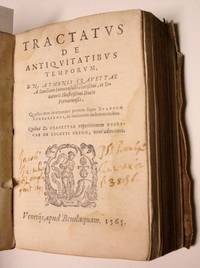
|
|
|
HERMOGENES.
Hermogenis Tarsensis Philosophi ac Rhetoris acutissimi De arte rhetorica praecepta Aphtonii item Sophistae praeexercitamenta nuper in Latinum sermonem versa. A Natale de Comitibus Veneto.
Basel Basileae Apud Petrum Pernam n.d. 1560 according to VD16 8vo. XVIII4142 blank29 index3 blank p. 17th century limp vellum 18 cm Ref: VD16 H 2470; Hoffmann 2216; Ebert 9507 Details: For the binding has been used a plain piece of parchment with faint traces ruling never used for writing. Woodcut printer's mark on the title it depicts a woman leaning on a staff and holding in her right hand a burning oil lamp. The meaning of this scene is explained on another version of Perna's printer's mark which bears the motto: 'Lucerna pedibus meis verbum tuum' which refers to Psalm 119 verse 105: 'Lucerna pedibus meis verbum tuum et lumen semitis meis'. Thy word is a lamp unto my feet and a light unto my paths These verses were later put to music by Henry Purcel in 'Thy Word is a lantern unto my feet' Z61 5 woodcut initials. Latin translation only Condition: Vellum slightly soiled. Endpapers renewed in the 19th century. 2 ownership entries on the title. Uppermargin of the first gatherings slightly waterstained. Last 24 leaves faintly waterstained. Paper yellowing Note: This collection of the works of the Greek rhetor Hermogenes of Tarsus 2nd cent. A.D. contains 3 works of which the 'De statibus' Peri stase�n and 'De formis orationis' Peri ide�n are certainly authentic. The third work 'De inventione' Peri heurese�s is considered to be of doubtful authenticity. They deal with exercises in rhetoric and different kinds of arguments to be used especially for the defence. Hermogenes' most important work 'De statibus' deals with 7 qualities of style 'all to be seen as ingredients in the perfection of Demosthenes: saph�neia megethos kallos gorgot�s �thos al�theia and deinot�s' OCD 2nd ed. p. 505 Added to the 3 works of Hermogenes are the 'Progymnasmata' of the Greek rhetor Aphtonius 4/5 cent. A.D. which is an introduction to rhetoric offering definitions of basic principles. Because the Progymnasmata were easier to read and understand than Hermogenes this slim but important manual remained basic for rhetoric education during the Middle Ages and the Renaissance. Hermogenes was translated into Latin by the Italian humanist poet and historian Natale Conti in Latin Natalis Comes or Natalis de Comitibus 1520-1582. He translated also into Latin the rhetorical treatises of Alexander Sophista 'De figuris sententiarum ac elocutionum' and of Demetrius Phalereus 'De oratione sive De modo dicendi' both published in Venice in 1557 and the 'Dipnosophistarum sive Coenae sapientium libri XV' of Athenaeus. He is however best known for his 'Mythologiae' first published in 1567 which became a standard source for classical mythology in later Renaissance Europe. See Wikipedia 'Natalis Comes' Provenance: Below the imprint an old ownership inscription of 'Leopoldi Andreae Guadagni JCt Flor.'. The Guadagni were a family of Florentine goldsmiths active in the 18th century. One of its members Leopoldo Andreas Guadagni 1705-1785 a jurist was professor of Roman law at the University of Pisa. He published several books on Roman law. Above the printer's mark the old ownership inscription of 'Petri Francisci Minotii Savinatis'. On the site of Flickr we found an inscription of one 'Pier Francesco Minozzi'. This is definitely the same hand. In 1670 Minozzi published 'L'Alleluia di Pindo per la clemenza risorta o regnante nel Vaticano'. On the title he is called 'Professor di Legge Monsavinese'. The 'patria' of Minozzi was of the community of Monte San Salvino in the province of Siena hence the addition 'Savinatis' in the inscription of his name. Minozzi is now forgotten but in his own age he was considered to be a great author and poet. He wrote prose and panegyric poetry in Latin and in Toscane and was professor of Law. His first collection of Latin epigrams was published in Siena in 1629 at the age of 18. He was a passionate representative of Italian 'asianism'. On the site 'cultura-barocca.com' a portrait of Minozzi and more data can befound. This book was once the property of two Italian Law professors. This seems to suggest that the rhetoric of the ancients was still relevant for lawyers and jurists in 17th and 18th century Italy Collation: a-2D8 8 w8 leaf w7 verso and leaf w8 blank Photographs on request hardcover
Ссылка продавца : 120128
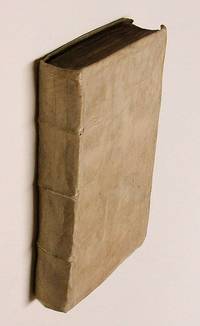
|
|
|
GAUTRUCHE P.
Historia poetica ad faciliorem poetarum et veterum auctorum intelligentiam; a R. Patre P. Gautruche soc. Jesu Gallice conscripta. Post septimam editionem latine reddita ab Uno eiusdem Societatis. In gratiam Poetices Candidatorum.
Tyrnau Tyrnaviae Typis Academicis 1728. 12mo. VIII180 recte 179;20 index1 blank p. Vellum 13 cm Details: Woodcut printer's mark of the Jesuit Order on the title Condition: Vellum slightly soiled and spotted. Back very slightly damaged. Old shelf number with ink on the front board. Front flyleaf removed. Wormholes in the inner margin of the endpapers at the end and of the last 3 leaves with some loss of letters in the index. Modern stamp & old name on the front pastedown Note: The contribution of the Jesuit order to the cultural history of Central and Eastern Europe was more significant than it was to the West. The small town of Trnava in Slovakia or Tyrnau or in Hungarian Nagyszombat and especially its Jesuit University founded there in 1635 was one of the catholic strongholds in Central Europe in the time of the Counter-Reformation. Its main purpose was the stemming of Protestantism or Lutheranism in what was then called the kingdom of Upper Hungary which was a part of the Habsburg empire. Here the order of the Jesuits trained its teachers and missionaries who spread catholicism and Habsburg culture succesfully eastward. Their most important weapons in spreading the autocratic ideology of that era were diplomacy and education. 884 members of the Jesuit order were active in Upper Hungary ca. 1750. They were leading 30 gymnasia 6 academies and 2 universities that of Trnava and of Kosice. For more than 150 years the Jesuit University of Trnava carried on its activity throughout Royal Hungary. Its University Press published more than 5000 titles. After the Order had been dissolved in 1777 the University was transfered to Buda. � This collection of prose narrations of mythological stories necessary for a perfect understanding of the Greek and Latin poets and other ancient authors was compiled to facilitate the study of young students. The collection was originally published in French as 'L�Histoire po�tique pour l�intelligence des po�tes et des auteurs anciens' by the French Jesuit Pierre Gautruche 1602-1681. It was translated into Latin after the 8th French edition and consists of 3 books the first treats the Gods the second the semi-gods the third is on religious ceremonies. p. A4 recto The French and the Latin version saw at the end of the 17th century and the first half of the 18th century many reissues. It was also translated into English Provenance: On the front pastedown a green stamp of 'Univ. Doz. Dr. Mag. F.F. Schwarz Professor. A 8810 Graz Panoramagasse 2A' with a handwritten date of acquisition '1973'. Franz Ferdinand Schwarz was from 1982 till 1996 professor of classical philology at the University of Graz where he was born in 1934. He died in his hometown in 2001 after a long illness. See his wikipedia lemma 'Franz Ferdinand Schwarz' In old ink on the front pastedown: 'Ex libris Francisci Caroli Wernerth anno .' Year illegible Collation: A-H12 I6 K2In the pagination has been omitted no. 113 Photographs on request hardcover
Ссылка продавца : 120086
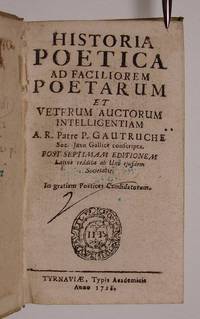
|
|
|
PRUDENTIUS.
Aurelii Prudentii Clementis Viri Consularis rerum divinarum religionis Christianae iuris item civilis & militaris peritia excellentis opera.
Lyon Lugduni Apud Ioan. Tornaesium et Guil. Gazeium 1553. 8vo. 5191 blank p. Contemporary pigskin over wooden boards. 13.5 cm Prudentius hat sich in der lyrischen in der epischen und in der didaktischen Poesie versucht und allenthalben Grosses geleistet Bardenhewer Ref: Cartier 'Bibliographie des �ditions des De Tournes' no. 258; Graesse 5467; Ebert 18063 Details: Contemporary pigskin over wooden boards. Back with 3 raised bands. Boards decorated with a row of blind-tooled rolls comprising floral motives and 10 portraits in medallions; there are 2 kind of portraits of 'Iusticia' and of 'Lucrecia'; Iusticia holds what looks like a disk before her face and Lucrecia stabs herself in the breast with a dagger. If this disk which is as big as her face is a mirror the cutter of the stamp made a mistake for the usual attributes of Justitia are the sword scales or blindfold. If this disk represents however a kind of blindfold to cover her face he chose an attribute we could not find in any work on iconography. A mirror is rather an attribute of Prudentia. The central panel is adorned with floral motives. On the title the round printer's mark of 'De Tournes': a double ring formed by two vipers a male and female; the female crushes the head of the male; in the middle a shield with the motto: 'Quod tibi fieri non vis alteri ne feceris'. Cartier p. 138/39 type Vip. o. Woodcut initials Condition: Binding scuffed and soiled corners bumped. Front hinge cracking but strong. 3 owner's inscriptions on the title one of them erased with ink. The vipers of the printer's mark are coloured pale green Note: The Roman poet Aurelius Clemens Prudentius born 348/49 died after 405 A.D. and of Spanish origin was besides a man of letters also an industrious public servant. He was a fervent Christian who had not cut himself off from the culture of the ancient world. 'He regarded the pagan literature and art not as things to be rejected but as part of the inheritance into which Christian Rome enters'. 'Prudentius' ed. H.J. Thomson Cambr. Mass. 2000 vol. 1 p. IX Loeb Classical Library 'It is as a poet in whom is embodied a reconciliation between the new faith and the old culture and in whom Christian thought claims rank in the world of letters that Prudentius is historically important'. Op. cit. p. X He 'was a pioneer in the creation of a Christian literature and has the credit of originating new types of Christian poetry the literary hymn the moral allegory and what has been called the Christian ballad'. Op. cit. XII His hymns are odes in which pagan mythology is replaced by stories from the Bible. By the great English scholar Richard Bentley he was described as 'Christianorum Maro et Flaccus'. All we know about him comes from Prudentius himself. For an edition of his work published in 404 or 405 he wrote a preface of 45 lines of poetry in which he informs the reader about his carreer and motives to write poetry. Prudentius was much read in the Middle Ages. His influence is also visible in medieval art. More than 300 manuscripts with his work survive. � The 'editio princeps' of Prudentius dates from 1495. This Lyonese edition of 1553 is based on the edition of Basel 1527 edited by the German humanist and classical scholar Johannes Sichardus 1499-1552. In Basel he lectured from 1525 till 1527 on Cicero Livius and other Roman classics. In the preface to the Prudentius edition dated 1527 and which is repeated in the edition of 1553 Sichardus complains about earlier editions of Prudentius which had suffered from mutilated manuscripts and amateur 'sciolo nescio quo' scholars. He has however managed to restore Prudentius in his original splendour Pristinio autem nitori restituimus. He did so not relying solely on his genius which is a tricky sometimes even unsound way to emendate genus emendandi satis lubricum ne dicam interim pestilens but with the help of an old manuscript ex codicibus vetustioribus which was lend to him by one Vuerinherus Vuoflinus Wernerus Woflinus. This manuscript is now held in Bern 'Bern Burgerbibliothek Cod. 264' place of origin: Bodensee Reichenau/St. Gallen/Konstanz and written ca. 900. Near the end of this edition of 1553 we find: 'In Aurelii Prudentii Clementis V.C. Psychomachiam scholia per Ioannem Sichardum' 10 p. De Tournes added from another source after this section of scholia: 'Erasmus Roterodamus castissimae puellae Margaretae Roperae s.d.' dated 1523 and the 'Commentarius in hymnum Prudentii de natalis puero Iesu per Erasmum Roterodamum' together 57 p. Provenance: Weissensee provenance On the title: 'Erdmann Wilhelm Ferber Gosecka. Thur.' We found a New Year's message of him dated 1757 'Licht in Finsterniss beym Wechsel des Jahres'. He is described on the title as Diakonus 'und ausserord. Colleg. der Landschule zu Pforta'. In the 'Personal-Codex des Weissensee'r Kreises' Weissensee 1868 p. 1 it is recorded that Magister Erdmann Wilhelm Ferber was 'Pfarrer' and 'Superintendent' in Weissensee from 1771 till 1799. Goseck lies in Th�ringen between Leipzig and Jena. � Below the printer's mark the name of probably the next owner: 'Ern. Andr. Christp. Callenberg'. Ernst Andreas Christoph Callenberg was Rector of the 'Stadtschule' at Weissensee from 1784 till 1822. 'Personal-Codex des Weissensee'r Kreises' Weissensee 1868 p. 6 In the 'Wittenbergsches Wochenblatt zum Aufnehmen der Naturkunde und des �konomische Gewerbes auf das Jahr 1778 6 St�ck Freytags den 13 Februar 1778' on page 48 under the heading 'Gelehrte Nachrichten Von der Wittenbergschen Universit�t und Stadt' he is mentioned a member of 'Predigercollegium' of the 'Schloss- und Universit�tskirche with the addition 'aus Th�ringen'. In 1775 he signed a 'Album Amicorum' with 'Kallenberg'. There he reveals the place of his birth 'Gebeser' nowadays Gebesee a small city north of Erfurt. � On the front pastedown in pencil: '15 sept. 1965' written by the Flemish linguist Walter Couvreur 1914-1996 who was an Orientalist and professor of Indoeuropean linguistics at the University of Gent. It indicates the date of aquisition. The place of acquisition he wrote on the flyleaf at the end: 'Leipzig Zentralantiquariat' Collation: A - 2I-8 2K-4 Photographs on request hardcover
Ссылка продавца : 120152
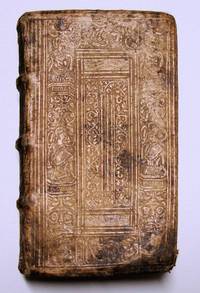
|
|
|
GELLIUS.
Auli Gellii luculentissimi scriptoris Noctes Atticae.
Lyon Lugduni Apud Haered. Seb. Gryphii 1560. LXIIII blank5333 blank p. Limp vellum 17 cm Ref: Schweiger 378; Dibdin 1340: 'beautiful and accurate edition . deserving of the student's notice'; Moss 1203; Graesse 346; Ebert 8283 Details: Gryphius' woodcut printer's mark on the title depicting a griffin which mythological animal symbolizes courage diligence watchfulness and rapidity of execution used as a pun of his family name Gryph or Greif. From the claws of this creature hangs a big rectangular stone beneath which is a winged orb. The motto is 'Virtute duce / comite fortuna' 'Virtue thy leader fortune thy comrade' a quote from a letter of Cicero to Plancus Epistulae ad Familiares liber X3. At the end a woodcut griffin. The text is printed completely in italics except for the title Condition: Vellum shabby wrinkled and showing some old repairs. Corners somewhat dog-eared at the end and beginning. Two old ownership inscriptions on the title one on the front pastedown. Upper margin of the first gatherings and a number of gatherings halfway slightly waterstained. Front flyleaf removed. Paper yellowing. A few small ink stains on the edge of the bookblock Note: The Latin author Aulus Gellius ca. 125-180 AD was never counted as a major author in antiquity nor later. His only work 'Noctes Atticae' or 'Attic Nights' is a miscellany that 'ranges from literature to law from wondrous tales to moral philosophy; one of his favorite topics is the Latin language'. . The exposition in a mildly archaizing but never difficult Latin often takes the form of dialogues with or between culturally eminent persons whom Gellius had known'. It derives its name from the fact of its having been written during the long nights of a winter which the author spent in Attica as a young itinerant student. The Noctes Atticae were exploited by pagans and Christians alike in late antiquity. In medieval florilegia he is much quoted for piquant tales and moral sentiments. 'From Petrarch onward Gellius became a favorite author of the Renaissance'. 'More than 100 manuscripts were copied'. He was used as a valuable source of information on the Latin language and had preserved numerous quotations from lost authors which were presented with grace and elegance. Gellius became a model for the 'Miscellanea' of the Italian humanist Angelo Poliziano. 'In the 18th century however new canons of elegance caused his style to seem less attractive and compilation sank to minor merit' Quotations from 'The Classical Tradition' Cambr. Mass. 2010 p. 386/7 According to Graesse this 1560 edition of Gellius is a reissue of the edition of Badius Ascensius of 1532. If this is correct than it was reissued without the preliminaries and the notes. Sebastianus Gryphius was an excellent Latin scholar himself and the printer of a host of handy and relatively cheap editions of Latin authors. Gellius was for him a moneyspinner for he published Gellius editions in 1537 1539 1546 1559 1560 & 1566 Provenance: Provenance the Tuscan city Gallicano. The first ownership inscription below the imprint is very legible: 'Bartholomaei Landi Gallicanensis' probably a Bartolomeo Landi from Gallicano. The second name on the title is crossed out: '. Johannis Mamanti Gallicanensis'. 'Johannis' and Gallicanensis' bear a contraction sign. The first name is illegible it is also contracted and ends probably on '-bri' The inscription on the front pastedown is a problem: 'Di Prese Gio. Mamanti da Gallicano'. Gallicano is a comune municipality in the Province of Lucca in the Italian region Tuscany located about 70 kilometres northwest of Florence Collation: A-D8 gathering C bound before B; a-z8 A-K8 L4 leaf L3 verso printer's mark leaf L4 blank Photographs on request hardcover
Ссылка продавца : 120130
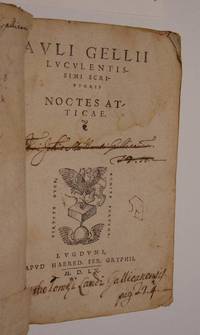
|
|
|
TERENTIUS.
De zes comedien van P. Terentius. Verduitst door Henricus Zwaardekroon rector der Schole tot Rotterdam.
Rotterdam Gedrukt bij Johannes Naeranus 1668. 12mo. 4986 blank p. Vellum 12.5 cm Ref: Geerebaert 138116; OiN 362 Condition: Binding scuffed spotted and soiled. Frontispiece removed. Oval stamp on the title. Some worming in the blank upper margin occasionally nibbling at letters. Paper yellowing Note: The late antique grammarian Aelius Donatus 4th century A.D wrote not only a commentary on the plays of the Roman playwright Publius Terentius Afer ca. 190-159 B.C. but also a short biography in which he tells that Terentius was born in the Roman province Africa and that he came as a slave in the houshold of the senator Terentius Lucanus. He adopted his name when he was manumitted. Terentius is the author of 'fabulae palliatae' which means 'plays in Greek cloths'. He adapted Greek plays especially those of the Greek playwright Menander to the taste of the Romans. Six of his comedies have survived. For later generations he became a model for elegant Latin. His style was closer to everyday conversation than Plautus' an earlier contemporary comic playwright whose style was more extravagant. He was quoted by Cicero Horace Persius and the Church Fathers. Ever since antiquity he lived also a long and influential life in schools as a model for Latin language and rhetoric. In the Middle Ages he was read for his moral sentences. He was imitated by the German abbess Hrotsvitha of Gandersheim ca. 935 - ca. 973 in her 'Dramenbuch' with which she wanted to create a Christian alternative for the pagan comedies. With the coming of humanism Terentius enjoyed a renaissance in the classroom and on stage. Scholars rejected the 'barbaries' of Medieval Latin and chose the elegance of Cicero and Terentius as their model. In his 'De ratione studii' 1511 the Dutch humanist Desiderius Erasmus 1466-1536 encouraged the study of Terentius for his language and moral utility. 'Among Latin writers who is more valuable as a standard of language than Terence He is pure concise and closer to everyday speech and by the very nature of his subject matter is also congenial to youth'. The Classical Tradition 2010 p. 930 Erasmus published later in life in 1532 an edition of Terentius' plays. Erasmus seems to have learned the whole of Terentius by heart in his youth. He admired the author for his 'latinitas' and his civilized humor. His ideal as a humanist and pedagogue was the creation of better men with the help of the classics. He held the opinion that schoolboys should read Terentius over and over again. Thus they could master a pure Latin style and learn at the same time good morals. Several Dutch humanists wrote 'Dialogi pueriles' fictitious dialogues to train schoolboys to converse in Latin; conversations which much Terentius in it. � The first Dutch translation of Terentius appeared in 1555 in Antwerp. Almost one century later 2 other new translation followed. In 1646 the remonstrant reverent Henricus Oosterhaern published a prose translation in Rotterdam. His translation is as literal as possible. His aim in didactic. He hopes that his readers will polish their speech and style when reading Terentius that they will learn from Terentius a 'suyvere en cierlijke manier van spreken en schryven'. P.J.M. van Alphen Nederlandse Terentius-vertalingen in de 16e en 17e eeuw Tilburg 1954 p. 95 Two years later in 1648 Rotterdam saw the next and more elegant prose translation now by another remonstrant the schoolmaster Henricus Zwaerdecroon since 1634 Rector of the 'Schola Latina Erasmiana'. NNBW 5.1182/83 In the dedication in this edition to his 'alumnus' Adrianus de Matenesse Zwaerdecroon dwells on the diligence and enthousiasm he and other old schoolboys displayed while reading Terentius. On their request Zwaerdecroon tells us and because they are leaving for the university he made this translation. Sometimes we find in the Dutch translation words or passages printed in italics. Those words and passages have been added to improve the Dutch and to explain matters. The edifying comedies of Terence were not only read by schoolboys. The Dutch philosopher Spinoza must also have studied his Terentius very thoroughly. In his work hundreds of quotations and borrowings from Terence can be traced. Spinoza used them to define and illustrate human feelings weaknesses and passions. F. Akkerman Spinoza's tekort aan woorden Leiden 1977 p. 3 In the same year as this edition 1648 the Rotterdam printer Naeranus brought a translation only edition on the market. This translation was reissued again in 1668 this edition Provenance: Stamp on the title: 'Bibliotheek Missiehuis Tilburg Collation: A-X12 leaves X10 X11 & X12 blank. leaf A2 the frontispiece gone Photographs on request hardcover
Ссылка продавца : 120174
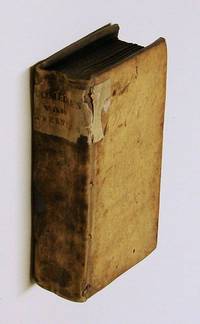
|
|
|
SALLUSTIUS.
C. Sallustius Crispus cum veterum Historicorum fragmentis. Bound with: Colloques d'�rasme fort curieusement. Traduits de Latin en Fran�ois pour l'usage des amateurs de la langue .
Ad 1: Leiden Lugduni Batavorum Ex officina Elzeviriana 1634. Ad 2: Leiden A Leyden Chez Adrian Vingart 1653. 12mo. 2 volumes in 1: vol. 1: XVI31034 index; vol. 2: XII36012 table p. Overlapping vellum 13 cm Ref: Ad 1: Willems 412 note: this is the second of the 3 reissues of this text in that year; Bergman 2115; Rahir 399; Schweiger 2877: 'Sehr saubere u. gesuchte Ausg.'; Dibdin 2384. Ad 2: Willems 1675 'Annexes de la collection Elzevirienne': 'assez jolie �dition. La traduction est de Samuel Chappuzeau'; Bergman 1357: '�dition fort jolie et d'une insigne raret�' Details: Ad 1: Title engraved by Cor.Cl. Duysent. Woodcut portrait of Sallustius at the end of the preface. Ad 2: Woodcut printer's mark on the title depicting a man climbing a palmtree the motto is 'Ardua quae pulchra' already mentioned in the Adagia of Erasmus Condition: Binding worn & soiled. Front hinge loosening but still hanging on 2 ropes. The hinge in the rear hangs on 1 rope. Tiny part of the vellum on the front joint gone. Edges of the first & last gathering thumbed. Caput numbers in the margins of the Bellum Catilinum & the Bellum Iugurthinum alternately written in ink & red pencil Note: Ad 1: 'One of the most widely read and influential of Roman historians along with Caesar Livy and Tacitus Sallust 86-34 BC has been studied quoted and imitated not only as a historian but also as a moral philosopher political thinker and stylist.' Until 1600 more than 200 editions of his work appeared. Sallust was used in the 16th and 17th century to support absolute theories of government. But 'on the other hand it was the republican Sallust 'ennemy of tyrants' whom John Milton admired and who bolstered the cause of liberty in the Lowlands during the war with Spain and later in France and on the American continent'. The Classical tradition Cambr. Mass. 2010 p. 856 Sallustius furnished indeed weapons to the supporters and opponents during the rebellion of the Netherlands against the Spaniards a war of independence that lasted 80 years from 1568 till 1648. Numberless pamphlets appeared during this war and many are full of reminiscences and quotations of classical authors. Sallust also was widely used everyone chose his favourite argument. This was possible because Sallustius preached party politics under a cloak of grave and philosophic impartiality. This 1634 edition was edited while the Eighty Years' War was raging on by the wellknown Dutch scholar Neolatin poet and editor of Latin classics Marcus Zuerius Boxhornius 1602-1653. A year before in 1633 he was appointed professor of Rhetoric at Leiden and later he filled the chair of Daniel Heinsius. � Ad 2: 'The Colloquia like the Adagia were written over a period of years and constantly enlarged as edition succeeded edition. From their earliest form of short models of Latin conversation and formulae of etiquette composed at Paris in 1497 for the use of some pupils and first printed in 1518 they grew into 'a rich and motley collection of dialogues each a master piece of literary form well-knit spontaneous convincing unsurpassed in lightness vivacity and fluent Latin each one a finished one-act play' Huizinga. The Colloquia full of witty and penetrating observations on ordinary day-to-day happenings as well as on the basic weakness of Church and society are an invaluable mine of information about 16th century customs institutions and social problems. Besides their success as a schoolbook was unrivaled and the stream of editions and translations flowed almost uninterruptedly down to modern times'. Gilhofer & Ranschburg GmbH Catalogue 50 Erasmus published on the 500th anniversary of his birth' Luzern ca. 1967 p. 34 � This translation of 1653 contains only 10 colloquia: 1 La Caresme; 2 Le point du jour; 3 Les Hotelleries; 4 Le mensonge et la V�rit�; 5 L'�pithalame; 6 L'�picurien; 7 Le Maquignon; 8 Du nom & de la chose; 9 Le Secret des sciences; 10 Le Banquet des sobres. And: Apologie d'�rasme aux th�ologiens de Louvain. This choice from the colloquia was translated by the French scholar author poet and playwright Samuel Chappuzeau 1625-1701 whose best-known work today is 'Le Th��tre Fran�ois' a description of French Theatre in the 17th century. See for him Wikipedia 'Samuel Chappuzeau' Provenance: In pencil on the front pastedown: 'J. v. Dijck' Collation: 8 A-O12 P6 minus the blank leaves P5 & P6; 4 22 A-P12 Q6 Photographs on request hardcover
Ссылка продавца : 120162
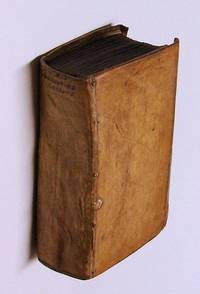
|
|
|
MAXIMUS TYRIUS.
V.C. Maximi Tyri Philosophi Platonici Dissertationes XLI. Graece. Cum interpretatione notis & emendationibus Danielis Heinsii. Accessit Alcinoi In doctrinam Platonis introductio ab eodem emendata: & alia ejusdem generis.
Leiden Lugduni Batavorum Apud Joannem Patium Acad. Typogr. 1607. 8vo. 3 parts in 1: XXIII1 blank408; 1241141 blank; 159 unnumbered pages1 blank p. Vellum 17.5 cm Ref: Hoffmann 2585; Schweiger 1204; Dibdin 2232; Graesse 4453; Ebert 13450; Brunet 31552 Details: Two thongs laced through the joints. Each part has its own title the first is in red & black. Woodcut printer's mark of Paets on the titles depicting a winged young woman who holds a scythe in her left hand and an opened book in her right arm Condition: Vellum age-toned and spotted. Tiny hole in the vellum of the lower board. Both pastedowns detached. Bookplate pasted on inside of the upper board. First title finger soiled. Almost invisible pinpoint wormhole at the tip of the right upper corner of ca. 250 p. Paper yellowing Note: The Greek Platonist Maximus Tyrus ca. 125-185 AD was an itinerant philosopher who left us 41 dissertations dalexeis on theological ethical and philosophical subjects. These lectures are not great literature nor specimina of great learning. Philosophical originality is not be be looked for in these lectures.The author offers a pleasant prensentation of a theme and his lectures 'are simply eloquent exhortations to virtue decked out in quotations chiefly from Plato and Homer'. OCD 2nd ed. 658 The themes are for example: 'die Lust h�don� 29-33 sokratische Liebe 18-22 platonische Theologie 11 'daimones' 8-9 Gebet 5 Weissagung und freier Wille 13 das B�se 41 und Wiedererinnerung 10'. Neue Pauly 71074/75 Maximus Tyrius was widely read by humanists like Ficino Bessarion and Poliziano. The 'editio princeps' was published in 1557 by the French scholar/publisher Henricus Stephanus. The next important and authorative edition was published in 1607 by the Dutch scholar Daniel Heinsius 1580-1655 who was in 1607 librarian of the University of Leiden. In 1609 he succeeded as professor of Greek his praeceptor Josephus Justus Scaliger. The first 300 pages of the first part of this book contain the Greek text of the 'Dissertationes' followed by a number of Pythagorean fragments and by 27 pages 'castigationes' on Maximus Tyrius by Henricus Stephanus. The pages 329-386 contain the Greek text of Alcinous' handbook of Platonism 'Introductio in Platonicam philosophiam'; the pages 387-408 contain Diogenes Laertius on Plato. The second part contains Heinsius's Latin translation of Maximus Tyrius and Alcinous; added are 33 pages with a Latin translation of the earlier mentioned Pythagorean fragments made by the Dutch scholar Willem Canter. At the end 27 pages filled with Apuleius's 'De Deo Socratis liber qui Maximi Dissertat. de eodem respondet'. Part 3 contains the notes of Heinsius. Heinsius based his edition of Maximus Tyrius on that of Stephanus but 'quae corrupta erant emendavimus quae obscuriora leviter illustravimus'. Part 1 leaf 6 recto But he was a conservative and reserved text critic 'Nobis' he explains 'temeritas nunquam placuit et si quid in autoribus peccandum est timidus videri malo quam audax'. Part 3 leaf a4 recto/verso Heinsius also produced the Latin translation and notes. In a 'Lectori' to the third part Heinsius tells that the French scholar Isaac Casaubon sent him a manuscript of Maximus Tyrius's 'Dissertationes'. It arrived too late for amending the Greek text and Latin translation but Heinsius used it for and in his notes. Heinsius received also some excerpts excerpta quaedam of Sixtus Arcerius and the Heidelberg professor Marquard Freher 1565-1614 sent him a manuscript from the Palatine Library Provenance: Armorial bookplate of the barony 'Sinclair' a shield divided into 4 fields flanked by 2 griffons a baron's coronet on top above which a peer's helmet with mantlings and a crest consisting of a swam on its nest. Each of the four fields is filled with what seems a ship under sail. Old manuscript shelfmark on and under the bookplate. The motto reads: 'Fide sed pugna' 'with faith but with fist' Collation: 8 24 leaf 24 verso blank; a-u8 x4 y-cc8; pi2 b-dd8 cc4 a-k8 Photographs on request hardcover
Ссылка продавца : 120123
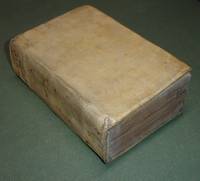
|
|
|
CIACCONIUS TOLETANUS P.
Petrus Ciacconius Toletanus De triclinio sive de modo convivandi apud priscos Romanos & de conviviorum apparatu. Accedit Fulvii Ursini Appendix & Hier. Mercurialis De accubitus in coena antiquorum origine dissertatio.
Amsterdam Amstelaedami Apud Henricum Wetstenium 1689. 12mo. XII445234 blank p. frontispiece and plates. Vellum 14 cm Details: 5 thongs laced through the joints. Short title in ink on the back. Frontispiece engraved by P. Philip. The copper plate for this frontispiece and for the other plates in this book were used previously for an edition of 'De triclinio' that was published in Amsterdam in 1664 by Andreas Frisius. Wetstein simply borrowed the text of this 1664 edition and reprinted it line for line and he used the 25 years old plates a second time. Only the first 12 preliminary pages containing a dedication and a 'lectori' are different. Title in red and black. 7 of which 5 folding plates 14 plates & illustrations of which 12 full-page in the text. They depict banquet scenes on archaeological objects and artist's impressions of banquets among which the last supper of Christ Condition: 2 small defects to spine; right margin of first leaves thumbed; right lower corner of last 10 leaves slightly waterstained Note: A triclinium 'a couch running round three sides of a table for reclining on at meals an eating-couch table-couch' it can also indicate 'a dining-room'. Lewis & Short The Spaniard priest Pedro Chac�n or in Latin Petrus Ciacconius born in Toledo in 1525 treats in his book 'De triclinio' more than couches. It also is on the meals of the Romans table manners dishes drinks especially wine symposia music etc. It is at the same time the best known title of Chacon. It was first published seven years after his death in Rome in 1588 a second edition appeared in 1590. He was a modest and industrious scholar who did not publish any work during his lifetime. Nevertheless was he called the Varro of his time. 'Alter sui saeculi Varro merito appellatus est ut erat omni disciplinarum genere ad miraculum usque instructus'. Rosinus 'Antiquitatum romanarum corpus absolutissimus' Utrecht 1701 p. 945 By some of his admirers he was considered to be an equal of a Fulvius Orsinus Hadrianus Turnebus or Lipsius. Chacon studied Greek and mathematics in Salamanca and refused afterwards offers for professorships. 'Il amait la solitude'. Pope Gregorius XIII invited him for learned researches in Rome on the text of the Bible the writings of the Churchfathers and the 'Decretum Gratiani' a collection of Canon law compiled and written in the 12th century as a legal textbook by a jurist known as Gratian. He did for the pope also research on the calendar. For this the pope made him canon of Sevilla. Chacon commented upon work Varro Caesar Pliny Maior and Sallust but especially on works of late antique and early christian authors e.g. Isidorus of Sevilla Cassianus Arnobius Minucius Felix and Tertullianus. It was said about him 'qu'il semblait n� pour corriger et r�tablir les auteur anciens'. He was so desinterested in glory that he invited scholars and friends to use and publish his works. He died in Rome in 1581 mourned by Gerard Vossius and Casaubon and others who praised his immense erudition and called him a 'tr�sor un miracle un fleuve de science'. 'His antiquarian treatises were published after his death and were partially reprinted in the Thesaurus of Graevius'. Sources: J.E. Sandys 'A history of classical scholarship' N.Y. 1964 p. 161 and 'Biographie Universelle ancienne et moderne' Paris 1844 . Vol. 7 p. 394/395 The book contains also an 'Appendix' on the subject by Chacon's contemporary the Italian scholar Fulvius Ursinus 1529-1600 who had a taste for the study of Roman antiquities. This edition is completed by a 60 page treatise on the art of eating while reclining by the Italian philologist and physician Girolamo Mercuriale or Geronimo Mercuriali or in Latin Hieronymus Mercurialis 1530-1606 best known for his 'De Arte Gymnastica' published in Venice in 1569. 'His great merit is his critical study of the ancient medical classics especially Hippocrates and his disciples. He wrote many other medical works including text books of the diseases of children of women of the skin and on practical medicine; all of which were widely read and used in many of the medical schools of his time' . 'After the publication of further works on the medical classics he was called in 1587 to the chair of medicine in Bologna'. Source: website 'New Advent' Provenance: On the front pastedown a bookplate: 'Ex libris R.G. Postumus'. Dr. R.G. Posthumus was a well known Dutch ophthalmologist. He wrote a number of articles on eye disorders Collation: 6; A-T12; V8 leaves V7 & V8 blank; 5 folding plates after p. 84 98 374 402 421. 2 plates after leaf F10 en P8; 14 plates included in the collation at leaf A10 D3 D4 D8 D11 E8 G1 G3 L1 L9 M4 Q2 & R7 Photographs on request hardcover
Ссылка продавца : 120043
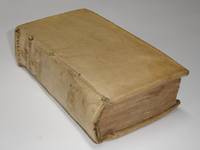
|
|
|
LUCANUS.
M.Annaei Lucani Pharsalia sive de bello civili Caesaris et Pompeji lib. X. Additae sunt in fine Hugonis Grotii notae ex binis antehac editis junctae auctae correctae et Thomae Farnabii in margine etc
Amsterdam Amsterodami Apud Ioannem Blaeuw 1643. 12mo. X3289 index1 blank p. Overlapping vellum 13 cm 'The Pharsalia contains some of the finest rhetoric ever written in verse' Ref: Schweiger 2563/64; Graesse 4273; Ebert 12345; Ter Meulen-Diermanse 430 Details: 5 thongs laced through the joints. Engraved architectural title depicting 2 Roman generals Caesar and Pompeius above them Dea Roma on her throne. Edges dyed red Condition: Vellum age-toned and with some stains. Small ink inscription of the frontcover. Front inner hinge cracking Note: When the first three books of the only surving work of the Roman poet Marcus Annaeus Lucanus 39-65 A.D. the epic 'Bellum Civile' or 'Pharsalia' were published in 62 or 63 the emperor Nero was not amused because it was great poetry and because it contained eloquent denunciations of tyranny. The epic was on the civil war between Caesar and Pompeius a war that ended the Roman republic. Lucan soon joined the conspiracy of Piso against Nero and was forced to commit suicide on its disclosure spring 65. The remaining books of the Pharsalia the last book X being unfinished were published posthumously after the death of Nero. 'Beginning with the causes of the war between Caesar and Pompey it carries the story beyond the death of Pompey until it breaks off with Caesar's occupation of Pharos in Egypt. The battle of Pharsalus is related in book 7. . All the resources of rhetoric are enlisted to impress the reader; vehement declamation and brilliant epigrammatic utterances sententiae are everywhere in evidence. There are numerous digressions many of them making a display of curious learning'. OCD 2nd ed. p. 620 Lucan made Pompey a tragic figure and evoked sympathy for him and his lost republican cause. The climax of the story is the battle at Pharsalos. According to Rose the Pharsalia contains some of the finest rhetoric ever written in verse'. H.J. Rose A handbook of Latin literature London 1967 p. 380 The philosophy of the Pharsalia is grotesque Stoic. Lucan was during the Middle Ages a popular school-author he survives in ca. 300 manuscripts. His afterlife is interesting. At the beginning of the Renaissance he was placed by Dante alongside Homer Horace and Ovid. The Englishman Thomas May composed a Continutation of the Pharsalia in English 1630. His Latin version of the Continuation 1640 was for 2 centuries added to editions of Lucan. 'For the Renaissance Lucan provided an important precedent for composing epics about comparatively recent historical events and more remarkably . for epics whose sympathies favor the losing side' e.g Alonso de Ercilla's 'Araucana' or Agrippa d'Aubign�'s 'Tragiques' about the persecution of the Huguenots. Lucan's republicanism made him in the 17th century unsuitable for incorporation in the series 'editions for the Dauphin' the crown prince of France while on the other hand the poet was admired by Voltaire for his 'libertas'. � The greatest scholarly achievement of the English scholar Thomas Farnaby c. 1575-1647 were his editions of classical Roman poets and playwrights accompanied by thorough Latin notes such as Juvenal 1612 the tragedies of Seneca 1613 Martialis 1615 Lucanus 1618 Vergil 1634 Ovid's Metamorphoses 1636 Terentius 1651 'As a school teacher a rhetorical theorist and an editor of classical texts Farnaby was one of the most influential scholars of the early seventeenth century. His schoolbooks on rhetoric were highly popular in the schoolroom he collaborated and corresponded with some of the most distinguished continental scholars of his day and his editions contributed greatly to the development of early modern textual criticism'. DBC 1308/9 Farnaby's Lucan was often reprinted in Britain and on the continent in the next century. The 20th century editor of Lucan's Pharsalia A.E. Housman wrote very favourably about Farnaby in the preface to his edition of 1926. It is his opinion that the excellent and indefatigable Farnaby produced a worthy commentary. Farnaby's notes he observes 'while full of matter are succinct and practical and the poem has even now no better commentary'. Lucanus Oxford 1926 p. XXXI At the end have been added 33 pages with notes of the Dutch scholar Hugo Grotius 1583-1645 Provenance: On the front flyleaf: 'U.J.J. C�ber anno 1768' and a 2oth century name: 'Werner Zohles' Collation: A - O-12 P-6 Photographs on request hardcover
Ссылка продавца : 120101
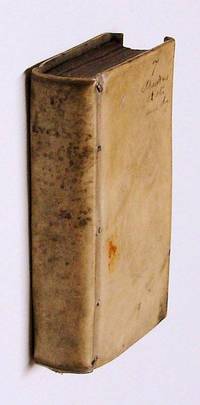
|
|
|
PRUDENTIUS.
Aurelii Prudentii Clementis V.C. Opera. Ex postrema doct. virorum recensione.
Amsterdam Amsterodami Apud Guiljel. Janss. Caesium Blaeu 1625. 12mo. 2611 blank p. Vellum. 11.1 cm Horatius Christianus Details: 5 thongs laced through the joints. Engraved title it depicts a huge Christian warrior who makes mincemeat of heathens and heretics. There in no introduction only the text Condition: Some small spots on the boards. The edges of the front flyleaf are thumbed and show 2 tears. Upper edge of first leaves slightly thumbed. Very tiny hole in inner margin of the title Note: The Roman poet Aurelius Clemens Prudentius born 348/49 died after 405 A.D. of Spanish origin was besides a man of letters also an industrious public servant. He was a fervent Christian who had not cut himself off from the culture of the ancient world. 'He regarded the pagan literature and art not as things to be rejected but as part of the inheritance into which Christian Rome enters'. 'Prudentius' ed. H.J. Thomson Cambr. Mass. 2000 vol. 1 p. IX Loeb Classical Library 'It is as a poet in whom is embodied a reconciliation between the new faith and the old culture and in whom Christian thought claims rank in the world of letters that Prudentius is historically important'. Op. cit. p. X He 'was a pioneer in the creation of a Christian literature and has the credit of originating new types of Christian poetry the literary hymn the moral allegory and what has been called the Christian ballad'. Op. cit. XII His hymns are odes in which pagan mythology is replaced by stories from the Bible. By the great English scholar Richard Bentley he was described as 'Christianorum Maro et Flaccus'. 'Prudentius was much read in the Middle Ages. His influence is also visible in medieval art. More than 300 manuscripts survive. � Allthough this edition of 1625 is not very rare it is not to be found in the usual reference works Schweiger Dibdin Moss Graesse Ebert or Brunet Provenance: On the front flyleaf in old ink: 'A.E. Ihre' Collation: A-Q8 R4 minus leaf R4 R3 verso blank Photographs on request hardcover
Ссылка продавца : 120151
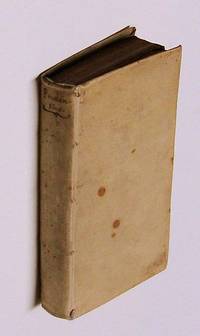
|
|
|
Frederick Boas
With Milton and the Cavaliers
James Nisbet & Co. Ltd 1904. Hardcover. Used; Good. No dust jacket. <p><i><strong>Fast Dispatch. Expedited UK Delivery Available. Excellent Customer Service. </strong></i> <br/><br/>Bookbarn International Inventory #2298821</p> James Nisbet & Co. Ltd hardcover
Ссылка продавца : 2298821
|
|
|
NICETAS CHONIATES.
Della Historia di Niceta Coniate delle cose dell'Imperio di Costantinopoli libri VII. Ne' quali si contengono i fatti degl'Imperatori Greci cominciando da Alessio Comneno doue lascia il Zonara fin 'all'anno 1457 nel qual su presa quella Citt� da Mahomet Secondo. Con le postille a suoi luoghi dinotanti le cose di maggiore importanza. Et con molte altre cose utili & necessarie a Lettori.
Venice In Venetia Colophon at the end: Appresso Francesco Sansovino 1562 4to. 4 unnumbered leaves 111 leaves. Vellum. 20.5 cm Ref: Edit17 CNCE 31070; Hoffmann 2634 Details: 2 vellum thongs laced through the joints at the head & tail of the spine. Short title in ink on the back. Woodcut printer's mark on the title depicting man who lies on his back and looks at the washing moon high in the sky. The text is printed in italics. Woodcut headpiece at the beginning of the dedication preface and translation. Woodcut initials Condition: Vellum soiled. Binding slightly damaged at the extremities. Old name on the title. A few pinpoint wormholes in the back. Small piece of vellum gone at the right outer edge of the upper board. Lacking the last blank leaf. Both pastedowns worn. Right upper corner of the last flyleaf torn off Note: The Byzantine historian Niketas Choniates Nik�tas Ch�niates ca. 1155-1216 was born in Chonai Phrygia Asia Minor and present day Khonas hence his name Choniates 'from Chonai'. He joined his older brother Michael in Constantinople where he embarked upon a political career and became an important civil servant. As governor of Thrace he was personally involved in the events relating to Frederick Barbarossa's passage through Thrace during the Third Cusade in 1189 when he lost his province to the Germans. After the capture of Constantinople and 3 of days of terrible and bloody looting by the Crusaders who were helped by the Venetians 13-15 April 1204 Niketas sought refuge in the home of a friend the Venetian wine merchant Dominicus who came to his rescue. Although a desperate refugee he was a brave man. 'As Niketas' party approached the Church of St. Mokios one of the Crusaders snatched the fair-headed daughter of a certain judge. Stumbling into a mudhole in despair the venerable judge pleaded with Niketas to save his daughter. To Niketas' credit in the face of great personal danger he persued the abductor and forced him to release the girl by appealing to his fellow Crusaders'. 'O City of Byzantium Annals of Nicetas Choniates' translated by H.J. Magoulias Detroit 1984 p. XIV-XV Niketas fled and went into voluntary exile in Nicaea where he settled at the court of the Nicaean emperor Theodore I Lascaris. There he completed a theological treatise the 'Dogmatik� Panoplia' which deals with the theological controversies of his time in some of which he himself had been involved and wrote this valuable account of the events of his lifetime. His account which is said to be impartial begins with the death of Emperor Alexius I Comnenus in 1118 who left his empire in bankruptcy and ends with events of autumn 1207 after the death of Baldwin I the first Latin emperor of Byzantium. 'The final draft of his history was left undone and its abrupt ending may have been due to his approaching death which also may explain his haste to complete it'. Idem p. XVI He considered the Comnenus dynasty a major cause of the empire's destruction and the sack of its capital in 1204. Another chief cause was the deterioration of the Byzantine navy. The Byzantines lost control of the seas to the Venetians. 'One of the historian's Niketas most telling criticisms is that the Muslims treated the conquered Latins in Jerusalem in 1187 with magnanimity while the Christians of the West behaved shamelessly toward their fellow Christians in the East'. Idem p. XXVII The history of the thallasocracy of Venice is closely connected with the Byzantine Empire. Constantinople twice granted her special trade privileges and with the Fourth Crusade and the sack of Constantinople this city state became an imperial power backed by its huge fleet. A considerable part of the loot was shipped to Venice including the famous bronze horses stolen from the Hippodrome which came to adorn the entrance of the San Marco Cathedral. With the Fall of Constantinople in 1453 numerous merchants Jews and Byzantine scholars fled to Venice. It is not strange that 16th century Venice was eager to read about their city's greatness and the collaps of the Byzantine Empire. The 'editio princeps' of the 'Historia' of Nicetas was published in Basel by Wolf in 1557. A few years later in 1562 3 Venetian translations were published. The first one this edition of 1562 was obviously a success for Francesco Sansovino brought in the same year a second augmented edition on the market. His fellow townsman Vincenzo Valgrisi published in 1562 also a translation this time made by Joseppe Horologgi. See Hoffmann 2634 Sansovino who apparantly considered Choniates' 'Historia' to be not elegant enough published in 1562 for his own press his own revision of the not yet published translation of Fausto da Longiano. Preface 4 recto At the beginning of each of the 7 books he proudly claims his part in the historiography of Constantinople for he adds to 'DELLE COSE DELL'IMPERIO DI COSTANTINOPOLI . SCRITTE PARTE DA NICETA CONIATE' printed in capitals in lowercase: '& parte da Francesco Sansovino'. This translation fell on fertile ground in Venice. Interest did not dwindle for in 1568 and 1571 two other editions appeared both translations of L. Dolce. The interest of Sansovino in Niketas may have been aroused by his experiences during his own childhood. He was born in Rome in 1521 and witnessed as a child the sack of his city in 1527 by mutinous troops of Charles the 5th. He and his father fled to Venice. Sansovino studied law in Padua and Bologna and after attempting a career at the court of Pope Julius III he returned to Venice. He was a many-sided author of poetry prose writings on literature history and rhetoric as well as a translator and editor. He opened his own printing house publishing around 30 editions many of good quality between 1560 and 1568. He was widely read during the Renaissance especially his historical works. His best known work is 'Venetia citt� nobilissima et singolare descritta in XII libri' of 1581 a kind of encyclopedia of the city Provenance: On the title: 'Ex libris Jacobi Alberti .ndini'. The first 2 letters of the last element are illegible Collation: 4 A-Z4 AA-EE4 minus leaf EE4 a blank Photographs on request hardcover
Ссылка продавца : 151902
|
|
|
PLINIUS MINOR.
C. Pliniii Secundi Novocomensis Liber de viris in re militari & administranda republica illustribus a multis mendis repurgatus & novis commentariis nunc primum nunc primum per Conradum Lycosthenem ita illustratus ut ad omnes Romanorum historias plurimum lucis & utilitatis adferat. Una cum eiusdem Plinii vita rerumque & verborum omnium indice copiosissimo.
Basel Basileae no publisher n.d. Colophon on the last page: 'Basileae Ex officina Ioannis Oporini Anno salutis humanae 1547 mense Septembri 8vo. XXXII59575 index2 blank p. 19th century half vellum 17 cm Ref: VD16 P 3521; Schweiger 21139 under Sextus Aurelius Victor; Graesse 5350 Details: Back ruled gilt and with a green morocco shield. 2 woodcut initials Condition: On the title page the words 'per Conradum Lycosthenem' are carefully erased. This erasing has been repeated on the verso of the title where in the heading of the short biography of Pliny Minor the words 'a Conrado Lycosthene' have been erased. This erasure signals the attempt to eradicate the memory of the editor of this title the Alsatian protestant humanist and encyclopedist Konrad Wolffhart latinized as Conradus Lycosthenes 1518-1561. In 1557 he published at Basel a work 'Prodigiorum ac ostentorum chronicon' or ' Chronicle of omens and portents' with woodcuts of freaks human monsters of all types curious animals comets earthquakes etc. Two years later this title and at the same time the entire oeuvre of Lycosthenes was placed on the first catholic 'Index librorum prohibitorum' by Pope Paul IV. The 'Index' of forbidden books contained publications that were banned by the Catholic Church because they were deemed heretical anti-clerical or immoral. Often these books were censored or even destroyed. The censoring sometimes came down to the erasing or cutting out of names or passages or the removal of leaves even complete chapters by catholic librarians. This explains the erasing of his name on the title page of this Plinius. The censor also cut out the name of the famous protestant publisher Oporinus leaving a neat rectangular hole of 7.5x1 cm. The censor overlooked however the name 'Conradus Vuolfhardus' in the heading of the 'praefatio' Note: 'The full maturation of ancient biography did not occur before the Roman late republican and imperial periods. The purposes of Graeco-Roman biography were varied ranging from instructive praise of a subject's virtues to panegyric to providing insurance against the jaws of oblivion by immortalizing the 'fama' good or ill of notable individuals'. The Classical Tradition Cambr. Mass. 2010 p. 127 In the early imperial period the Greek author Plutarch composed a series of vitae which are discursive and generally show a strong moral bias. The Romans were in the writing of biography not wholly dependent on the Greeks. 'The attitudes and customs of their own political and family life led them to put a special value on recording the achievements of their great men'. OCD 2nd ed. p. 168 Tacitus Agricola Nepos Liber De Excellentibus Ducibus Gentium Suetonius Vitae XII imperatorum or Caesares are the principle Roman biographers. In late antiquity they found a number of imitators and continuators e.g. the 'Scriptores Historiae Augustae' or 'Sextus Aurelius Victor'. � This 'Liber de viris in re militari & administranda republica illustribus' nowadays called in the edition of Pilchmayr 'Incerti Auctoris liber de Viris Illustribus Urbis Romae' is one of those imiations. It contains more than 75 biographies of famous Romans from Romulus to Pompeius and Sulla. When it was written no one knows some say first or second century AD others the fourth. This collection of Lives of famous Romans including Hannibal his brother Hasdrubal and king Mithridates was long time primarily ascribed to Plinius Minor 62-ca. 113 AD. The editio princeps was printed ca. 1470 and enjoyed a great popularity among humanists and on schools. Since the edition of Aldus in 1508 the collection is often called the 'Liber de viris in re militari & administranda republica illustribus'. Schweiger records before this 1547 edition ca. 40 editions and there must be more. It was printed in the 16th century also under the name of Suetonius and of Nepos. Hyginus and Aemilius Probus are also mentioned as the authors. The Flemish scholar Andreas Schottus attibuted the text in 1577 to Sextus Aurelius Victor. From then on till the second half of the 19th century he was thought to be the author of this collection. Schweiger 2 1140/41 But nowadays the author is an anonymous because the style genus dicendi does not suit Sextus Aurelius Victor. It is doubtful whether the author was a christian. He belonged probably to the Optimates. Though many historical errors hurt the eye of the reader still this collection of biographies offers much that is of great help for our understanding of Roman history of the republican period. The collection figures anonymously in the 'Bibliotheca Teubneriana' edition of that writer of 1966 edited by Pilchmayr. Especially the praefatio of Pichlmayer offers much useful information p. X & XI � Conradus Lycosthenes lectured grammar and dialectics in Basel from 1542. In 1545 he was appointed deacon and preacher of the local 'St. Leonhardskirche'. He married Christine Herbster a sister of Johannes Oporinus the printer of this book. The biographer of Lycosthenes's short biography in ADB calls his commentary in this 1547 collection his most excellent work. ADB 19 727/28 Provenance: On the front pastedown in pencil: '24 dec. 1963' written by the Flemish linguist Walter Couvreur 1914-1996 Orientalist and professor of Indoeuropean linguistics at the University of Gent. It indicates the date of aquisition. The place of acquisition is written on the flyleaf at the end: 'Bologna Galliera' Collation: alpha-beta8 a-2T8 leaf 2T8 blank Photographs on request hardcover
Ссылка продавца : 120121
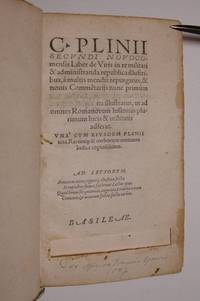
|
|
|
LIVIUS.
Romainsche Historien van Titus Livius sedert de bouwing van Romen tot aan d'ondergang van 't Macedonische Rijk. Ten meestendeel van nieus vertaalt en met een tweede decade voor de gene die verloren is verrijkt en op ontellijke plaatsen vermeerdert. Met een vervolg der Romainsche historien strekkende van 't einde van T. Livius tot aan de doot van C. Iulius Caesar; beneffens een kort doch bondig Vertoog van de Staat der oude Romainen. Nieuwelijks uit de Romainsche Historie van M. Scipio Dupleix vertaalt en met nieuwe Bladwyzers verrijkt.
Amsterdam t' Amsterdam Gedrukt by Jacob Lescaille voor Ian Iacobsz. Schipper 1646. Folio. 2 parts in 1: LII including frontispiece622 recte 620 38 index 2 blank; 198 recte 194 26 p. Vellum. 31.5 cm Ref: STCN ppn 840918704; Geerebaert 1153; OiN 242; Schweiger 2548; Ebert 12138 Details: Back with 7 raised bands. Brown morocco shield in second compartment. Both boards blind tooled. Blind stamped oval ornament in the center of both boards. The frontispiece depicts Jupiter sitting on a flying eagle and brandishing his thunderbolt; Jupiter is accompanied by Hera Iris and 2 warriors; Iris holds a caduceus in her hand; in the foreground rests near a well Tiburinus the personification and genius of the river Tiber; at his feet are playing Romulus and Remus who he is told to have found on the border of his river and the she-wolf Lupa. Woodcut ornament on the title. Woodcut initials. Numerous charming woodcuts in the text. Printed in 2 columns and in Gothic type Condition: Vellum age tanned and slightly spotted. Some soiling of the frontispiece. Some small spots on the title Note: The Roman historian Titus Livius 59 B.C. - 17 A.D wrote a huge and immensely influential history of Rome 'From the foundation of the City' Ab Urbe Condita libri in 142 books. Of this work only 35 books are still extant. Of the rest remain only fragments and summaries. He 'set himself to give Rome a history that in conception and style should be worthy of her imperial rise and greatness' OCD 2nd ed. p. 615. The later Roman historian Tacitus declared that Livy was 'brilliant for eloquence and credibility'. Annales 4.43 Livy was the source and model of many classical medieval and later historians and writers like Lucan for his 'Civil War' for Einhard's biography of Charlemagne for Petrarch's 'Africa' for Shakespeare's 'Rape of Lucretia' etc. Other humanist historians wrote the history of their state to equal what Livy had done for Rome. The English philosopher 'Francis Bacon declared Livy the best historian who provided models for behavior Advancement of Learning 1605' The Classical Tradition Cambr. Mass. 2010 p. 537 � The Dutch translator of this Livius of 1646 is Jan Hendriksz. Glazemaker 1619/20-1682 who was a professional translator �nd glazier. Glazemaker means glazier If there were no texts to translate Glazemaker worked as a glazier in the firm of his stepfather. He started his career translating popular literature later he specialized in philosophy. He translated e.g. Descartes and Spinoza for the Dutch market. He mainly translated from Latin and French. His knowledge of Greek seems to have been insufficient to translate properly. So he must have used also Latin and French examples for his Greek authors. Choosing words to translate he was a purist and always chose pure Dutch terms so enriching the Dutch vocabulary. He was not a scholar nor a humanist virtuoso. To make some money he had to translate a lot and fast. His hastiness was the cause of some sloppiness. 'In vertalingen uit het Latijn valt op dat Glazemaker nogal eens mistast bij pronominale verwijzingen. Ook moet men niet veel precisie verwachten bij zijn vertaling van tempus modus en genus van werkwoordsvormen. Kleine woordjes als adverbia partikels coniuncties worden op de gis vertaald of weggelaten. . Meestal is zijn globale tekstbegrip zo groot dat geen verduistering van de strekking het gevolg is'. Glazemaker's style seems unvarying. He aims at keeping the structure of the sentences as clear and simple as possible which is said to be benificial to the reading pleasure and to be good for global and rational clarity. Glazemaker 1682-1982 Catalogus bij een tentoonstelling over de vertaler Jan Hendriksz. Glazemaker Amst. 1982 p. IX-XIII � The translation is preceded by a 44 p. richly illustrated survey of the buildings of Rome and of Roman customs and traditions. After the translation of the first ten books of Livy's 'Ab Urbe Condita' Glazemaker has added as replacement of the lost second decade which cover 293-218 B.C. a translation of the relevant part of the historical work of the French historian Scipion Dupleix 1569-1661. S. Dupleix 'Histoire Romaine depuis la fondation de Rome' 3 volumes Paris 1638-1643 At the end of Livy's work after p. 622 Glazemaker has added as continuation again a considerable part of Dupleix' work. This part runs from from 167 B.C. when Livy ends till the death of Julius Caesar in 44 B.C. The continuation starts on page 170 chapitre 9 livre 20 in volume two of Dupleix' 'Histoire Romaine'. As a replacement of the the lost second decade Glazemaker offers his translation of the p. 643-717 chapitre 5 livre 12 - livre XIII of Dupleix' historical work. � Glazemaker is not mentioned on the title-page. His name however occurs on the half title preceding the continuation of Dupleix. As the writer of the preface Aan de lezer tells the reader that he supplements lost parts of Livy with Dupleix he cannot be any other than Glazemaker. 'Doch wy hebben echter om dit werk tot enige volmaaktheit te brengen 't geen dat ons dienstigh was uit de Romainsche Historie van M. Scipio Dupleix getrokken te weten dat 't welk wy hier in plaats van T. Livius tweede Decade die door de ramp des tijts verloren is ingevoegt hebben en voorts het vervolg op onze schrijver dat is van d'ondergang van 't Macedonische rijk tot aan de doot van C. Julius Cesar door de voorgenoemde Dupleix'. p. 4 recto Collation: 4 - 44 56; A-Z6 Aa-Zz6 Aaa-Eee6 Fff-Lll4 leaf Lll4 blank; A-H6; Aa-Ii6 Kk - Ll4. Irregular pagination in the first part between p. 404 & 407; irregular pagination in the second part between p. 96 and 101 Photographs on request Heavy book may require extra shipping costs hardcover
Ссылка продавца : 151901 ISBN : 1619201682 9781619201682
|
|
|
PORPHYRIUS.
PORPHURIOU PERI TOU EN T�i ODUSSEIAi T�N NUMPH�N ANTROU. Porphyrius De antro Nympharum. Graece cum Latina L. Holstenii versione. Graeca ad fidem editionum restituit versionem C. Gesneri & animadversiones suas adjecit R.M. van Goens Trajectinus. Praemissa est Dissertatio Homerica ad Porphyrium.
Utrecht Traiecti ad Rhenum Sumptibus Abrahami v. Paddenburg 1765 4to. XXXIV2XXXVI1228 p. Contemporary half calf 26.5 cm Ref: STCN ppn 203268296; Hoffmann 3284; Schweiger 1274; Brunet 4823/24; Ebert 17795; Graesse 5415 Details: Probably an Italian binding. Back gilt and with a red morocco shield. Title and the first leaf of the preliminaries leaf chi1 and also L2 printed in red and black. Greek text followed by the Latin translation of Holstein at the bottom of the page are the 'variae lectiones'. At the end has been added a second Latin translation that of Conrad Gesner. A small text engraving on page 117 Condition: Back slightly rubbed its head very sligthtly damaged. Boards scuffed. Corners bumped. Some tiny wormholes in the right lower corner not coming even close to the text. Paper age-toned Note: The author of this treatise on the Odyssean Cave of the Nymphs is the Greek scholar and philosopher Porphyrius Porphyry 232/3 - ca. 305 A.D. who was more a polymath than an original thinker. In his numerous treatises and commentaries he had the good habit of quoting his sources by name. He thus preserved many fragments of older learning. OCD 2nd ed. p. 864/65 Porphyrius was a student of Plotinus whose Enneads he edited somewhere after 300. Most of his work is written from a Plotinian point of view. He produced also numerous philosophical commentaries on Plato Aristotle Theophrastus and Plotinus. His commentary on the Categories of Aristotle became a standard medieval textbook of logic. His philologic work include his 'Homeric Investigations' a landmark in the history of Homeric scholarship and 'De antro Nympharum' a specimen of allegorizing interpretation in which Porphyrius symbolically explains the passages in the 13th book of Homer's Odyssey on the Cave of the Nymphs. In this cave situated on the island of Ithaca Odysseus hid the treasures of the Phaeacians on his return home. Od. XIII 102-112 361-365 The edition of 1765 opens after a dedication to young prince William V with a 'Dissertatio Homerica ad Porphyrium' by the Dutch classical scholar Rijklof Micha�l van Goens 1748-1810. The Greek text which follows is accompanied by 2 Latin translations. The first one by the German philologist Lucas Holstein or Holstenius 1596-1642 is printed parallel to the Greek text. It was first published in 1630 in Rome where he was librarian of the Vatican. At the end of the Greek text comes the second translation made by the Swiss classical scholar Conrad Gesner 1516-1565 which was first published in Z�rich in 1542. After that translation follow the 'Collectanea ad Porphyrium De antro Nympharum' in which the editor Van Goens offers the Homeric text with the relevant scholia and commentaries and observations of Eustathius Johannes Spondanus Joshua Barnes Madame Dacier Alexander Pope and among others Willem Canter who declared that the complete Odyssey was an allegory of man searching for wisdom and happiness which he only could reach through death for Odysseus' sleep on board of the Phaeacian ship that brought him home must be understood as a stay in death. p. 81 At the end we find 38 pages filled with observations and commentary by Van Goens himself. Van Goens was a precocious polymath. He matriculated at the age of 12 and only 18 years old he succeeded his professor at the University of Utrecht Peter Wesseling. He had to quit his chair in 1776 because he had made himself impossible. He went into Utrecht politics made more ennemies and left his country disappointed in 1786. His principal work is his edition of Porphyrius of 1765. He does not agree with the allegorical explanations of Porphyrius and Dacier which he calls 'nugae'. Such trifles only made the Odyssean passage incomprehensible instead of clear. Van Goens wants instead to shed light on the beauty of Homer's description of the cave. Praefatio p. XXII His aim is not textcritical but more philosophical Epistola p. IV. Porphyrius explains the cave of the Nymphes and her double entrance as a profound allegory of the journey of the soul on it ways to and from its origin. p. 23 The cave symbolises the material world into which the human soul has descended. The darkness in it stands for the unseen powers of the material world. Porphyrius discusses the famous cavern of Plato refers to Pythagoras Heraclitus Mozes Zoroaster Stoics and the Egyptians and construes with bold imagination and wondrous combinations an allegoric explanation. In his 'Animadversiones ad Porphyrium de Antro Nympharum' p. 85-122 Van Goens investigates in order to explain the interesting passages in the work of Porphyrius thoroughly and with a marvelous erudition old and new authors. He seems to plunder a whole library from Plato to Spinoza from the New Testament to Leibniz to prove his point Provenance: Bookplate on the front pastedown depicting the coat of arms of the Vargas Macciucca family with surrounding text: 'ex bibliotheca illris Ducis Thomae Vargas Macciucca'; on the recto of the first flyleaf has been pasted a leaf with a set of house rules which the Duke prescribed himself and others using or lending books from his library. The Italian noble Vargas Macciucia or Vargas Machuca family is of Spanish or rather Gothic origin. It dates back to the 8th century. By a degree of king Alfonso XI of 1267 the family has the privilege to bear the royal arms of Castiglia e Leon which are also depicted on the bookplate. In the middle of the 17th century the family took root in the South of Italy under king Philip IV who was also king of Naples. The 19th generation Vargas was Tommaso or Tommasso de Vargas Machuca Thomas Vargas Macciucca who was gouvernor of Capua. In 1732 he was created 'Duca de Vargas Machuca'. In 1748 the family lived in the monumental palace 'Real Monte di Manso' in Naples. He died in 1775. See for this family: nobili-napoletani.it/Vargas_Macchucca.htm Collation: -44 51; -44 52 chi1 A-Q4 R2 chi1 is originally 52. This leaf has been replaced according to the instructions for the binder Photographs on request hardcover
Ссылка продавца : 140036
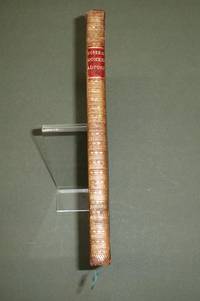
|
|
|
PLINIUS MINOR.
Lettere di Plinio il Giovane tradotte in lingua Italiana e dedicate all'Illustriss. ed Eccellentiss. Signore D. Alessandro Albani nipote di nostro Signore Clemente XI Pontefice Ottimo Massimo dal Canonico Gio. Antonio Tedeschi e tra gli Arcadi Orticolo Eleo.
Roma Della Stamperia di Gio. Maria Salvioni nella Sapienza 1717. 4to. XXXV1 blank; 4411 errori2 blank p. Calf 24 cm Ref: Schweiger 2816; Moss 2502 quotes Nicola Francesco Haym 'Biblioteca Italiana o sia notizia de libri rari nella lingua italiana' Venice/Milan 1741 p. 157: 'La traduzione e l'impressione sono ambi bellissime'; Ebert 17379; Graesse 3351 Details: Back with 5 raised bands and a gilt red morocco shield in the second compartment. Title printed in red and black. Woodcut initials. Excellent quality paper Condition: Binding scuffed. Boards scratches and spotted. Corners bumped. Foot of the spine slightly damaged. Front joint partly split. Bookplate and small label on the front pastedown. Front hinge cracking but strong. First two leaves foxed. Faint name on the title Note: The Roman civilian administrator Gaius Plinius Caecilius Secundus 61-112 A.D published 10 books of literary letters consisting of short essays character sketches and sensible observations. The letters paint the high society of the young Roman empire. The ninth book contains Pliny's correspondence with the emperor Trajan. Pliny is famous for his description of the eruption of the Vesuvius on the 24th of August in 79 A.D. He was a nephew of the encyclopedist Pliny the Elder who died observing the eruption from afar overcome by poisonous fumes. Pliny the Younger held under Trajanus a number of magistracies. In 111 /112 he became governor of Bithynia. From here he was in constant correspondence with the Emperor. His letters which were conceived of as artistic productions are more or less epistolary essays. In the late antiquity and later in the Renaissance the literary letter had a widespread influence. � Not much is known about the Canon Giovanni Antonio Tedeschi or Johannes Antonius Tedeschi who produced this first complete Italian translation of the correspondence of Pliny Minor. He also published a translation of the letters of Symmachus 1724. He died in 1727. We found one Giovanni Antonio Tedeschi who was dean archiprete of the family Borghese in whose palace he died in 1727 and who was buried in S. Lucia della Tinta. Claudio De Dominicis 'Carlo De Dominicis architetto del settecento romano' Roma 2006 p. 73 This must be our Tedeschi for he dedicated his Symmachus translation to Marcantonio Borghese. Tedeschi was a member of the Italian literary academy/society 'Accademia degli Arcadi' or 'Accademia dell'Arcadia'. In 'Prose degli Arcadi tomo terzo' Roma 1718 p. CV he is described as 'Orticolo Eleo. Il Canonico Gio. Antonio Tedeschi da Pesaro'. 'Orticolo Eleo' being his 'nome arcadico' i.e. his pen name or pseudonym. So the phrase 'e tra gli Arcadi Orticolo Eleo' probably means 'and among the Arcadi his name is 'Orticolo Eleo''. Might this pen name refer to a 'olive grove' A problem is that there is in this same period a namesake who was a sculptor/stonemason Provenance: On the title the name of 'Harriet Taylor'. This is Harriet Taylor Upton 1853 - 1945 who was an American political activist and author. Taylor 'Upton is best remembered as a leading Ohio state and national figure in the struggle for women's right to vote and as the first woman to become a vice chairman of the Republican National Committee'. Harriet Taylor married in 1884 the attorney George W. Upton. She 'was a key organizer and the first president of the Suffrage Association of Warren. She was also a member of the National Woman Suffrage Association NWSA from 1890. In 1891 Upton hosted a conclave of women seeking equal rights with men Ohio Women in Convention in her home. . Harriet Upton was inducted into the Ohio Women's Hall of Fame in 1981 in the category of Government and Military Service. In early 2010 Upton was proposed by the Ohio Historical Society as a finalist in a statewide vote for inclusion in Statuary Hall at the United States Capitol'. She probably wrote her name before 1884. See Harriet's lemma in Wikipedia � On the French title in pencil: 'J.W. Tellegen' � On the front pastedown the bookplate of 'Thomas Conolly' depicting a round garter with the motto: 'En Dieu Est Tout'; in the center a cubit arm the hand is grasping an annulet. Someone wrote once in pencil beneath the plate: 'One time Speaker in the Irish House of Commons'. This is not correct. This Speaker was William Conolly of humble descent who was the first of his line and in his time the wealthiest and the most powerful politician in Ireland. He died childless in 1729. Thomas Conolly 1738-1803 was a son of his nephew William James Conolly. Thomas inherited the estate of his father William James when he was still a minor. 'Thomas Conolly was the quintessential Irish gentleman a keen huntsman and a fine horseman as well as a politician and landowner. Regarded as the wealthiest commoner in the kingdom: he actually spent much of his career in debt because of large debts he inherited from his father. Conolly sat in the Irish parliament for forty years where he prided himself on his often imagined independence'. See for this interesting family: wwwcastletown.ie Collation: pi4 b-c4 d6 leaf d6 verso blank; A-3H4 3I6 leaf 3I6 blank Photographs on request hardcover
Ссылка продавца : 153326
|
|
|
MONTESQUIEU.
Considerations sur les causes de la grandeur des Romains et de leur d�cadence.
Amsterdam Chez J. Wetstein 1746. 8vo. IVIV1902 blank p. frontispiece. Mottled calf. 15.5 cm Ref: Not in Brunet Cioranescu Graesse or Ebert. Not in L. Vian 'Montesquieu bibliographies des oeuvres' Details: Back gilt and with 5 raised bands. Marbled endpapers. Engraved frontispiece depicting an Roman emperor on his throne. Title in red and black. Engraved printer's mark of the Wetstein family on the title depicting 2 sphinxes and 2 winged putti grouped around a round shield with a burin on it; the burin is being sharpened on a whetstone Wetstein!; around the shield the device: 'Terar dum prosim'. Edges dyed red Condition: Binding somewhat scuffed. Joint of the lower board split but strong the joint of the upper board beginning to split. Name on the front flyleaf Note: The idea of a Golden Silver Bronze and Iron Age each age of lesser splendour than the preceding one is a topos in European literature. 'From the ancient world medieval and modern historians and moralists inherited a rich vocabulary for describing and analysing decline . Decline was viewed fundamentally moral and associated with softness and effeminacy. It was the inevitable effect of the rise of civilization'. The classical tradition N.Y. 2010 p. 782 The vocabulary of decline was common in the influential Roman historians Sallust and Tacitus. Their work offered Renaissance historians and politicians like Leonardi Bruni and Machiavelli opportunities for interpreting in vivid colours the progress and decline of their states. � The French political philosopher of the Age of Enlightenment Charles-Louis de Secondat Baron de La Br�de et de Montesquieu or simply Montesquieu 1689-1755 who opposed despotism follows in his 'Considerations sur les causes de la grandeur des Romains et de leur d�cadence' Sallust by stressing the disease of corruption 'but he also innovates by discussing economic reasons for decline implying a parallel with the decline of Spain in the 17th century'. op. cit. p. 783 Montesquieu published his 'Considerations' anonymously in Amsterdam in 1734 but the 'privil�ge' of an edition of 1735 already reveals the name of its author. The anonymous is indicated in this edition of 1746 at the end of an 'avertissement du libraire' as 'Auteur des Lettres Persanes' who was as every educated person of that time knew Montesquieu. Of all the writings of Montesquieu this title has remained one of the most popular. It has become a classic. The 'Considerations' is more a political treatise than the work of an ancient historian it is a political reflection of great scope on the idea of freedom. Montesquieu performs a frontal attack on established ideas disregards traditional chronology and wipes the floor with established reputations. It indirectly critizes the imperialistic politics of the French state. Montesquieu's view on Roman history was revolutionary. He refused for instance to accept the thesis of Rome's grandeur. In the first 8 chapters he explains that the Romans owed their success not to fortune or their characteristic features or even devine providence but to human factors. They were more cunning more experienced and more suspicious than others. The decline set in with the Civil Wars in the first century B.C. Then follow 15 chapters describing the 15 centuries of decline the struggle for life the last convulsions revivals and utter ruin. For the first half of the book Montesquieu consulted the Roman historians Polybius Florus. Especially the last one was constantly on his desk. It is said that Montesquieu imitated Florus' concise style. The Frenchman borrowed also from Machiavelli whose 'Les Discours sur la premi�re d�cade de Tite-Live' he had read and reread. � This Amsterdam edition of 1746 is a reissue of the first edition of 1734. It even imitates the colours and the lay-out of its title page. It has also 2 peculiarities it is virtually unknown to bibliographers and it contains at the end fin a dialogue of 9.5 pages the 'Dialogue de Sylla et d'Eucrate' of which dialogue the bibliographies state that it was first added to the second edition of the 'Considerations' Paris 1748 which was revised by the author himself. The dialogue 'Sylla et d�Eucrate' was first published in the 'Mercure de France num�ro de f�vrier 1745' and was appended to the end of the second revised of 1748' it is said by the editor of the complete works of Montesquieu �douard Laboulaye for the first time by Montesquieu himself. Oeuvres compl�tes de Montesquieu volume 2 1876 p. 329 In all subsequent editions these two works are inseparable. The statement that the short dialogue 'Sylla et Eucrate' was only added in 1748 by the author clearly contradicts our copy of 1746 an issue of the otherwise first edition which includes this dialogue. Has Montesquieu seen a copy of this book noticed the appended dialogue and thought that this was a good idea and added it also to the second authorized edition of 1748 The dialogue has merits of its own: 'Nos ma�tres litt�raires ont toujours propos� � notre admiration ce dialogue c�l�bre ; ils y ont vu un des chefs-d��uvre de l�esprit humain' Op. cit. ibidem Provenance: On the front flyleaf: 'H.A. Tromp' Collation: pi2 2 A-M8 leaf K8 blank Photographs on request hardcover
Ссылка продавца : 120281
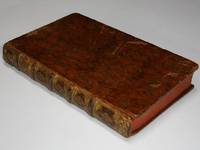
|
|
|
PLINIUS MINOR.
C. Plinii Caecilii Secundi Epistolarum libri X. Notis integris Is. Casauboni Jani Gruteri H. Stephani Augusti Buchneri Casp. Barthii Joh. Fred. Gronovii Selectissimisque Joh. Mariae Catanaei Ritterhusii & aliorum insertis suo loco integris commentariis Francisci Balduini J.C. Cunradi Ritterhusii J.C. & Gerh. Joh. Vossii in 'Relationem' seu consultationem 'Plinii' & ad hanc 'Rescriptum Trajani' Imper. de 'Christianis' illustrati & accurate recensiti a Johanne Veenhusio Brem.
Leiden Rotterdam Lugd. Batav. Roterodami Ex Officina Hackiana 1669. 8vo. LII81823 index1 blank p. frontispiece. 19th century half calf. 19.5 cm 'We shall have reason to congratulate ourselves on the acquisition of so elegant and desirable an edition' Ref: STCN ppn 840239440; Schweiger 2809; Brunet 4722: 'bonne �dition'; Fabricius/Ernesti 2415 among the 'meliores editiones'; Dibdin 2331: 'is one of the scarcest and most valuable of the octavo Variorum classics'; Moss 2494/95: 'the text of Pliny is correct and the select notes of Veenhyseen sic do great credit to his learning and judgment'; Ebert 17351: 'eine der bessern Augaben cum notis varior.' Graesse 5347/48 Details: Back ruled gilt and with 4 raised bands. The frontispiece engraved by G. Wingendorp depicts Plinius at his desk in front of him 2 quills and an inkpot. Woodcut printer's mark on the title depicting a soaring eagle motto 'Movendo'. Dibdin adds: 'and whether we consider the elegance of its typography the accuracy of the text or perspicuity of the notes we shall have equal reason to congratulate ourselves on the acquisition of so elegant and desirable an edition'. Winckelmann used this 1669 edition of Pliny when he visited the Laurentine Villa Ep. II17 of Pliny Condition: Binding slightly scuffed. Seven small wormholes at the foot of the spine. New endpapers. Ownership entry on the title. Some foxing Note: The Roman civilian administrator Gaius Plinius Caecilius Secundus 61-112 A.D published 10 books of literary letters consisting of short essays character sketches and sensible observations. The letters paint the high society of the young Roman empire. The ninth book contains Pliny's correspondence with the emperor Trajan. Pliny is famous for his description of the eruption of the Vesuvius on the 24th of August in 79 A.D. He was a nephew of the encyclopedist Pliny the Elder who died observing the eruption from afar overcome by poisonous fumes. Pliny the Younger held under Trajanus a number of magistracies. In 111 or 112 he became governor of Bithynia. From here he was in constant correspondence with the Emperor. His letters which were conceived of as artistic productions are more or less epistolary essays. In the late antiquity and later in the Renaissance the literary letter had a widespread influence. � The German classical scholar Johannes Veenhusius of Bremen 1643-1675 published the 'Epistulae' with the complete commentaries of Casaubon Gruterus Henri Estienne Buchnerus Barthius Johannes Fredericus Gronovius and with select notes of Cattaneo Ritterhusius and himself. The emendations of Gronovius are published here for the first time. Added are Henri Estienne's 'Praefatio' and Conrad Lycosthenes' 'Vita Plinii' Boxhornius' essay on Pliny's alleged Christianity and the notes of Balduinus Ritterhusius and the Vossii. For his text of the 'Epistulae' Veenhusius generally follows Estienne/Cattaneo even when he reports in the footnotes the notes and the comments of other scholars who disagree with or correct the text he is printing. To confirm Pliny's authorship of book 10 he reprints at the beginning of that book the dedicatory letter of Giovanni Maria Cattaneo who published an edition of Pliny's letters in 1506 to Ambrogio del Maino. In his own dedication to the officials of the city of Bremen Veenhusius speaks of the difficult task of an editor. But he affirms that Pliny is an author worthy of their sponsorship; many of his letters deal with Roman law which would be useful to compare with common law and many contain learned observations about antiquity and politics which are not only useful but also necessary to know. 'Catalogus Translationum Et Commentariorum: Mediaeval and Renaissance Latin translations and commentaries annotated lists and guides'. Volume IX editors V. BrownJ. HankinsR. A. Kasterp Washington 2011 p. 94 � Not much is known about Veenhusius he is not to be found in ADB and NNBW. At the beginning of the 'dedicatio' to this edition he calls himself Johannes Veenhusen and Bremen his 'Patria'. In 1671 he produced for the Leiden publisher Hackius another 'Variorum' edition now of Statius. Provenance: On the title 'Bibliotheca vallis Sti Lamberti 1749'. We found on the internet one book with exactly this same provenance: crlvorg/bibliographie-des-voyages/1203. The Cistercian abbey Val St. Lambert was situated in Seraing Southwest of the Belgian city of Li�ge. It was founded in 1202 and closed down in 1796. Nowadays it is a crystal glass factory. See Wikipedia 'Val-Saint-Lambert'. On the front flyleaf the name of the Dutch specialist of Roman law 'J.W. Tellegen'. On the front pastedown a small label of 'Libreria dello Studente Add.: Paolo Franchini Firenze' Collation: -38 42; A-3G8 leaf 3G5 verso blank; minus leaf 3G6 7 & 8 Photographs on request hardcover
Ссылка продавца : 153325
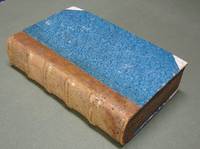
|
|
|
POTTER J.
Archaeologia Graeca sive veterum Graecorum praecipue vero Atheniensium ritus civiles religiosi militares et domestici fusius explicati per H. Joannem Potterum.
Leiden Lugduni Batavorum Excudit Petrus van der Aa Bibliopl 1702. Folio XII788 recte 712 columns14 index p. heraldic plate 9 plates of which 1 folding plus 67 plates of which 2 folding and a folding. Prize copy without the prize. Vellum. 44 cm Ref: STCN ppn 218141505; Brunet 4817; Ebert 17886; Graesse 5428; Spoelder p. 493 Amsterdam 12 Details: Back with 7 raised bands. Gilt coat of arms in all 8 compartments of the back. Boards gilt panelled with a large gilt coat of arms of Amsterdam in the center. Title in red and black. Big engraved printer's mark on the title depicting an armed Athena seated before the 'Burcht' of Leiden the Genius of the river Rhine is looking at her; they are surrounded by symbols of wisdom; the motto is: 'Studio et Vigilantia'. Immediately after the title comes a full page coat of arms of the British politician and statesman Robert Harley Speaker of the House of Commons in 1702 to whom Potter dedicated this title. The big folding map of Greece 35.5 x 50 cm was engraved after a map of Abraham Ortelius 1527-1598. It was one of the most reliable and accurate maps of the 16th century. The 9 plates belonging to this edition depict ancient buildings sport scenes soldiers deployment of troops siege tactics men of war. The other 67 inserted plates show mythological literary and historical scenes and figures. Among them a big folding plate of 33.5 x 84 cm of a famous ancient Roman mural painting a frieze known as the 'Aldobrandini Wedding' depicting an allegory of marriage. It was found in 1605. See for the origin of these extra 67 plates the note below Condition: Prize removed. Vellum worn tanned soiled spotted and scratched. Front joint split but strong. Corners bumped. Title slightly soiled. Small and faint waterstain at the right lower corner of the first 20 pages. The lower edge of a huge folding plate with coins is chipping. A small piece of the blank lower corner of the 'Aldobrandini Wedding' torn off Note: The Englishman John Potter 1674 - 1747 edited already at the age of 19 Plutarch's treatise 'De Audiendis Poetis' and Basil's 'De legendis graecorum libris' Oxford 1694. After this he produced a beautiful and excellent edition of Lycophron the best of that age Oxford 1697. The same year he gave to the world his best known work the 'Archaeologia Graeca or The Antiquities of Greece' Oxford 1697/98. 'This erudite and useful work was received with general approbation both abroad and at home; engaged him in extensive correspondence with men of learning and obtained for him a distinguished rank among the benefactors to the republic of letters'. Archaeologia Graeca English edition of 1832 p. IV � The Dutch publisher Petrus van der Aa saw a market opportunity for the use of Potter's title at school and universities and had made a Latin translation of the work which he brought on the market in 1702. In the preface to the book Van der Aa tells the reader that he wanted to publish it whatever the costs and trouble. He even asked Potter to enlarge his work with the result that the Latin translation nearly doubled the length of the English work 'ita ut hic Liber duplo auctior prodeat in lucem quam Anglicana lingua editus fuit'. p. 5 recto of the 1702 preface Van der Aa did a splendid job he printed with incomparable typographical elegance and added magnificent illustrative engravings. The book does not deal with Greek archaeology as a modern reader might expect. In the 18th century 'archaeologia' referred to the 'science of Greek antiquities' which is a vague term 'insofern er im Grunde das ganze ehemalige Daseyn desselben the Greek people in allen Einzelheiten seines Lebens und seiner Erscheining imfasst'. K.F. Hermann 'Lehrbuch der griechischen Alterth�mer' 2. Auflage Heidelberg 1836 p. 1 The 'Archaeologia' had for its subject the peculiarities and productions of the ancient Greek world particularly those which are known to us only from history and not in the first place by works of art. Works of art were only important as sources and confirmations of ancient history. The unwritten sources such as sculpture architecture and works of art in general could only be understood by means of the written sources the 'monumenta literata'. So Potter wanted his 'Archaelogica Graeca' to supply in the first place a key to unlock the treasures of Greek literature. The book deals with the customs and traditions political and constitutional history law government and adminstration art of war religion etc. of the Greek people. 'The authorities from which the information is obtained are accurately stated and the numerous quotations from the poets with which the work abounds give a satisfactory explanation of the phrases and customs they are intended to illustrate'. Archaeologia Graeca English edition of 1832 p. V � After this work John Potter dedicated himself to the Church of England took a degree of Doctor in Divinity in 1706 became Regius professor of Divinity in 1708 at Oxford found time to produce a splendid edition of Clemens Alexandrinus Oxford 1715 was made bishop of Oxford 1715 and arrived at the highest ecclesiastical dignity which England could offer when he was appointed Archbishop of Canterbury 1737. This 1702 Latin edition of the 'Archaeologia Graeca' was published by the firm of Van der Aa separately just as our copy but it was also incorporated as volume 12 into the enormous 'Thesaurus Antiquitatum Graecarum' which consisted of 13 fat and richly illustrated folio volumes of which monster project the Dutch classical scholar Jacobus Gronovius was the editor Leiden 1697-1702. The aim of this project was to collect and make accessible into one body numerous treatises on Greek antiquities which were worth of preservation in a uniform work. The 13 volumes contain works of older antiquaries from the middle of the 16th to the middle of the 17th century. Gronovius made 1 exception. He gave a place in the 12th volume to the very recent and impressive work of young John Potter. Van der Aa had made for this 12th volume of the 'Thesaurus' 9 full page engravings. Our copy however has another 67 plates and a folding map extra. These plates originate from the other volumes of the Thesaurus and were added by the binder probably on order of the curators of the Schola Latina to make this prize copy even more splendid. The boy who won this prize must have been very clever and promising but also very happy for he must have held in his hands a very expensive and raving beauty Collation: 6 A-Z4 Aa-Ss4 Tt usque Zz2 Aaa-Eee4 irregular numbering of columns: the numbering jumps from 661 to 736 nothing missing and the numbers of columns 462/63 have been used twice Photographs on request Heavy book may require extra shipping costs hardcover
Ссылка продавца : 151913
|
|
|
MUSAEUS.
MOUSAIOU TOU GRAMMATIKOU TA KATH' H�R� KAI LEANDRON. Musaei Grammatici De Herone et Leandro carmen. Cum scholiis graecis nunc primum e codice MS. Bibliothecae Bodlejanae editis. Ex recensione Matthiae R�ver qui variantes lectiones et notas adjecit.
Leiden Lugduni Batavorum Apud Theodorum Haak 1737. 4to. Frontispiece XLIV10126 index p. Vellum 21 cm Ref: STCN ppn 238249670; Hoffmann 2608: 'Abdruck des Textes von Kromayer mit wenigen Ver�nderungen; unter dem Texte jedoch befinden sich Varr. aus 7 Handschriften und 17 Ausgaben'. Brunet 31958; Dibdin 2240; Moss 2312; Ebert 14562; Graesse 4633 Details: 5 thongs laced through both joints. Short title in ink on the back. Frontispiece designed and engraved by F. van Bleijswijk depicting a drowned Leander washed ashore and Hero just before she hits the ground after having jumped from a tower. The title features the engraving of 2 ancient coins which depict a swimming Leander and Hero with her torch on a tower. In the preface R�ver gives an assessment of previous editions and a list of the manuscripts and editions he used. The Greek text is accompanied by an opposing Latin translation; on the lower part of the page are printed the scholia. At the end have been added 3 Latin verse translations Condition: Vellum age-toned and slightly spotted. Paper slightly yellowing at the edges Note: The Greek poet Musaeus Musaios middle 5th century A.D. wrote an 'epyllion' of 343 hexameters the only surviving full narrative of the love story of Hero and Leander. It is about young Leander who lived in Abydos a town on the borders of the Hellespont the Dardanelles and fell in love with Hero a priestress of Aphrodite who's home was in Sestos a town at the opposite side. His parents rejected his feelings but he nevertheless swam every night ca. 5 km to Sestos to meet his love. She lit a lamp at the top of the tower in which she lived to guide him. One stormy night the flame was extinguished and the young man drowned. When his body was washed ashore Hero jumped in despair from the tower. The story of this couple is a typical ancient love romance. It borrows elements from the ancient novels of Chariton Achilles Tatius and Nonnus. The form is that of an alexandrian love elegy. This story was known to Vergil Georg. 3258/63. In his Heroides no. 18 & 19 Ovid has them exchange love letters. � From the 15th century Hero and Leander form a famous love couple in European art and literature. The first great Spanish mythological poem by Juan Bosc�n Almog�ver of 1541 is about this love affair. The English poet Marlow made this theme popular during the Elizabethan renaissance. The 'Sturm und Drang' period honours them as examples of fidelity till death. This couple inspired composers and painters like Rubens and Turner. � Numerous editions of the epyllion have been published the first with a Latin version by Marcus Musurus was published ca. 1494 in Venice by Aldus Manutius. The young Dutch scholar Matthias R�ver 1719-1803 published in 1737 a new edition of Musaeus when he was only 18. After his studies at Leyden he practiced as a solicitor for 3 years. He then returned to Delft his native city where he became a scholarly recluse for the rest of his life expanding his knowledge and corresponding with famous scholars. His activities however bore no fruit. He left a huge library. Van der Aa 15 p. 515/16 Nevertheless Dibdin is full of praise for R�ver and observes that this Musaeus edition 'exhibited strong proofs of critical skill and correct judgment'. R�ver used for his edition 7 manuscripts and 17 earlier editions. In the preface he thanks Abraham Gronovius 1695-1775 later in life librarian of the University of Leiden for offering him the collation and readings of 3 manuscripts from the Bodleian in Oxford which had been collated by his father Jacobus Gronovius 1645-1716 professor of Greek at Leyden and he thanks Jacobus Philippus d'Orville 1690-1751 professor of eloquentia of the 'Athenaeum Illustre' at Amsterdam for his readings and collations of a manuscript from an ancient Vatican and of a Venitian manuscript. The scholia which are printed here for the first time were once copied in the Bodleian by Jacobus Gronovius. page 23 recto R�ver tells on page 5 recto and verso of the preface that he has added 3 other excellent verse translations one of Andreas Papius Gandensis one of Q. Septimius Florens Christianus who was once praised by J.J. Scaliger for his proficiency in Greek Latin and French poetry and the one made by David Whitford which surpasses both others 'qui priores carminis elegantia & facilitate longe superat' Collation: pi1 frontispiece -54 62; A-Q4 leaf Q4 verso blank Photographs on request hardcover
Ссылка продавца : 130350
|
|
|
ORIGENES.
�RIGEN�S KATA KELSOU EN TOMOIS �'. tou autou PHILOKALIA. Origenis Contra Celsum libri octo; eiusdem Philocalia. Gulielmus Spencerus Cantabrigiensis Collegii Trinitatis Socius utriusque operis versionem recognovit & annotationes adjecit. Accedunt item notae Davidis Hoeschelii in octo libros Origenis una cum notis Jo. Tarini in Philocaliam. Cum indice rerum & verborum locupletissimo.
Cambridge Cantabrigiae Excudebat Joan. Hayes Celeberrimae Academiae Typographus impensis Guli. Morden Bibliopolae 1677. 4to. X428; 2 blank 6110298; 38 index p. Contemporary calf. 23.5 cm Ref: ESTC Citation No. R6493; Hoffmann 323; Neue Pauly Suppl. 2 p. 421; Dibdin 1190 about Spencer's edition of 1658 calls the notes of Spencer 'learned and ingenious'; Ebert 15216; Graesse 546; Brunet 4228/29 Details: Back gilt and with 5 raised bands. Shield in the second compartment. Title printed in red and black. Woodcut initials. Printed in 2 columns Greek and Latin in parallel columns. At the end 98 pages commentary Condition: Back rubbed corners bumped. Joints partly split. Two small faint stains on the title page. Old ownership inscription on the front flyleaf. Pinpoint wormhole in the right lower corner always far from the text. Some old clear and legible scholarly ink notes in the beginning. Paper slightly yellowing Note: The Greek theologian Origenes Adamantius 184/185-254/55 AD was without doubt the greatest scholar of the Church in its first three centuries. His 'writings were voluminous and their range wide but only a small proportion has survived. He was a pioneer in textual criticism of the Bible in exegesis and in systematic theology'. OCD 2nd edition p. 757 In fact Origenes did not write he produced texts. 'Es standen ihm n�mlich berichtet Eusebius Hist. eccl. 6232 wenn er diktierte mehr als sieben Stenographen zu Gebote . ferner ebenso viele Buchschreiber . samt M�dchen die im Sch�nschreiben ge�bt waren'. Bardenhewer 'Geschichte der altkirchlichen Literatur' 2nd ed. Freiburg 1914 p. 98 His apologetic work 'Contra Celsum' in 8 books survives in its entirety in many manuscripts. In it Origen attacks after half a century the first comprehensive polemic against Christianity called the 'Al�th�s logos' written ca. 180 AD by the Neoplatonic philosopher Celsus. Celsus's attack was an elaborate indictment of Christianity. The response of Origenes is considered to be the ultimate apology of Christianity. The 'Philokalia' is a collection of excerpts from Origenes's works. 'It preserves the original text of many passages known otherwise only in Latin translation'. OCD ibidem During the 1660s and 1670s Origenes enjoyed a Renaissance in England. He was important in the theology of 'Cambridge Platonism'. He was called by some the 'miracle of the christian world' but his championship was regarded however with suspicion by the Restoration church establishment that dreaded the revival of the heterodox Origenes. The Restoration was critical about Origenes's doctrine of the pre-existence of the soul. In this climate William Spencer Fellow of Trinity College Cambridge of whom little is known produced in 1658 his first edition of 'Contra Celsum'. After the dedication follows a preface 'sur les controverses orig�nistes et les jugements port�s sur Orig�ne; notice de J�rome sur Orig�ne dans VirrIll IV/V en latin et en grec'. Crouzel 'Bibliographie critique d'Orig�ne' Steenburgge 1971 p. 109 Spencer adopted and improved for his edition Origenes's eight books against Celsus the Latin translation made by the Czech humanist and Greek scholar Sigismund Gelenius which had appeared for the first time in a revised Origenes edition of Erasmus of 1557. It was reprinted in 1605 in Augsburg with Gelenius's notes by the German scholar David Hoeschelius. Spencer took over Hoeschel's notes too in his edition of 1658 reappearing in 1677 in a line for line reissue. Spencer adopted also the text of the 'editio princeps' of the 'Philokalia' Paris 1618 and its accompanying Latin translation of the French scholar Jean Tarin 1585-1666 who taught Latin at the 'Coll�ge de France'. At the end of the book are 98 pages with the notes on the 'Contra Celsum' of Spencer followed by 28 pages notes of Hoeschel and Tarin Provenance: On the recto side of the first blank leaf an inscription: 'Ex libris Gasparis Rohleri Rolleri sacerdotis Senonensis 5a Augusti anno 1726'. Who this priest of the diocese of Sens East of Paris was we could not find out. The marginal notes in the beginning of the text were probably made by him. � From the Rostagni Library. 'The Rostagni private library has been built over a time of 133 years between 1880 and 2013 by 3 generations of collectors: Augusto Gabinio 1863-1939 internist his nephew Augusto Rostagni 1892-1961 classical philologist at the University of Turin and his son Luigi Rostagni 1932 Operational Director. . Augusto Rostagni thaught Ancient literature in various Italian Universities. In 1928 he was appointed professor in Latin literature at the University of Turin an office he fulfilled until his death in 1961. He became one of Italy's most authorative philologists of the 20th century. He held positions of President of the Turin Institute of Classical Philology Dean of the Department of Literature and Philosophy Editor of the Rivista di Filologia Classica President of the 'Accademia delle Scienze di Torino'. He was a well-known member of many Italian and foreign academies and institutions amongst them the Accademia dei Lincei. The Department of Philology Linguistics & Classical Tradition of the University of Turin is named after him.' Burgersdijk & Niermans Auction sale 340 Leiden 2014 p.68 Collation: A4 minus blank leaf A1 a2; B-4R4 leaf 3I3 blank 4S2; on the verso of 4S2 a stocklist of 'W. Morden bookseller in Cambridge'. The first gathering 'A' should have a blank leaf A1 then the title followed by A3 both connected by the watermark and at the end an unsigned leaf. These 4 leaves are followed by a 2 leaf gathering 'a' which brings the total of preliminary leaves to 6 12 pages. These preliminary pages are described in other copies we found as having 10 pages not including or recognizing the blank A1 Photographs on request hardcover
Ссылка продавца : 152320
|
|